|
An Inventory of Marx Playset Figures and Accessories Manufactured from 1951 to 1979
Appendix S-2 - Space Exploration Accessories
|
Contents of this web site may not be reproduced or duplicated for use on the Internet or for commercial purposes without permission by Eric Johns.
| Please note: Due to the wide variety of items and sizes on this page, I have not attempted to keep them in actual proportion. Rather, I have sized them to provide reasonably good viewing on your computer screen. For the most part, items within each group are shown approximately proportional. I also have provided measurements for many items so that you have an idea as to their size. |
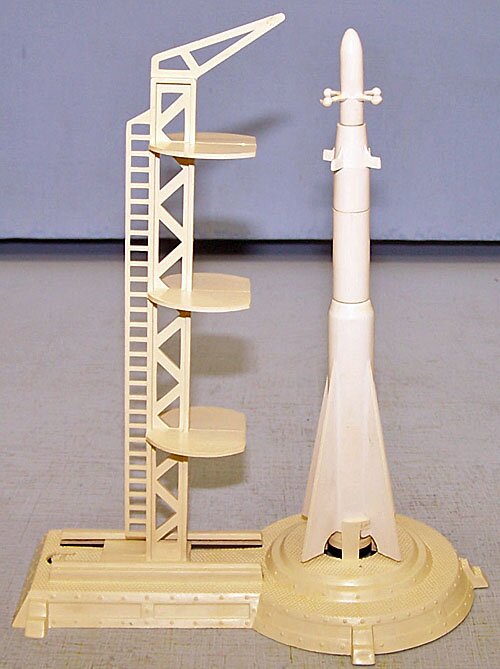 Table of Contents
(click on name to move to section)
|
| Gates and Fencing |
| Buildings and Other Structures |
| Small Accessories |
| Rockets and Missiles |
| Ground Vehicles |
| Flying Vehicles |
| Water Vehicles |
| Terrain |
| Playmats |
| Back to Main Table of Contents |
If you like big, colorful, impressive accessories, the space exploration playsets are the ones for you! Space sets were a mainstay of the Marx playset line, produced from 1952 right through the company's bankruptcy in 1979. Colorful buildings, big rockets that really fired, and even underground headquarters really jazzed up the space sets.
I had a Tom Corbett Training Academy as a child and well recall using catapults made of Tinker Toys in a space battle with my father. However, I never realized how large some of the accessories were until I started accumulating items to create this page. I was downright shocked at the size of the first Marx rocket launcher I received in the mail, which happens to fire a rocket about 25 feet! As sometimes noted below, I have had to display some of the photos much smaller in size when compared to smaller items in order to fit them onto a computer screen. I've provided measurements for such items whenever I have them.
A little additional information on the various series of Marx space playsets is provided on the Space Exploration Figures page of this web site
| Gates and Fencing |
Early Playsets - Tom Corbet, Space Patrol, and Rex Mars
Marx' 1950's space exploration playsets -- Tom Corbett, Space Patrol, and Rex Mars -- included gates and walls to surround the space compounds. Except for the lithography painted on them, these were identical to the company's Wild West forts, such as Fort Dearborn, Fort Apache, and the Alamo. They were made of tin-plated pressed steel -- called tin litho by collectors -- and decorated with brightly-colored lithography, though the basic gate color was generally light gray. Signs on gates identified which playset the gates belonged to.
Gates were about 5-1/2 inches tall and 9 inches wide. Of note, small window openings were punched into the gates, as well as the walls. For some reason, these openings -- perfect to pose cavalrymen and pioneers defending forts -- were not made in the Wild West versions. Veteran collector Josh Petrie has informed me that some space sets included walls without the windows in them.
The following photos show three gates from the early space playsets, but there are at least a few more of these gates with differing colors and/or designs from some versions of these sets.
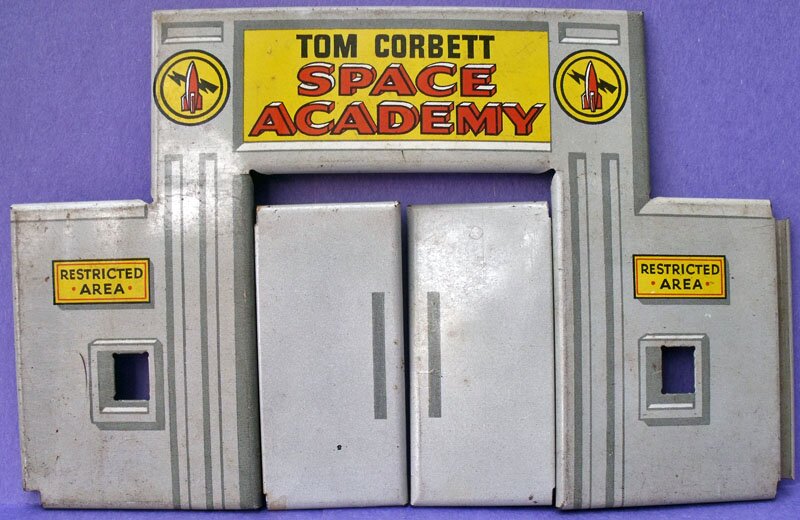 |
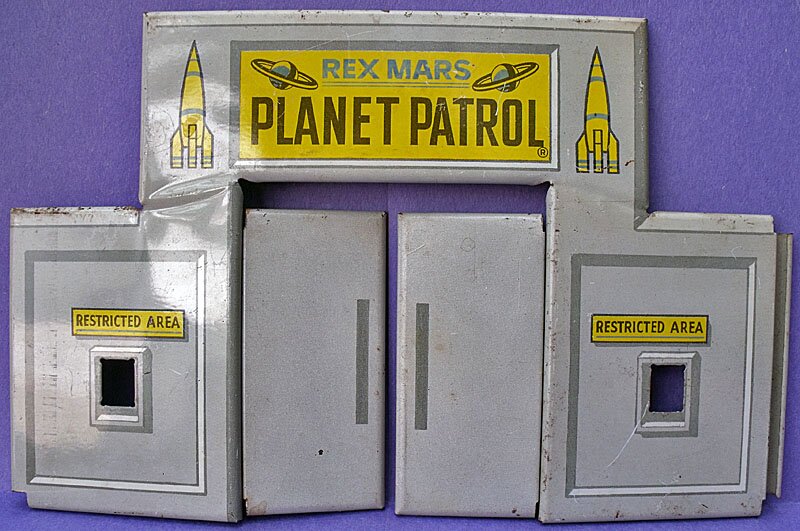 |
| Gate for Tom Corbet Space Academy | Gate for Rex Mars Planet Patrol actual color of gate is same as photo at left -- a light gray -- very hard to get my colors correct here! |
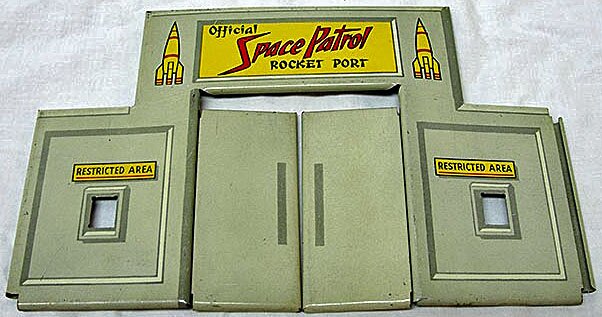 |
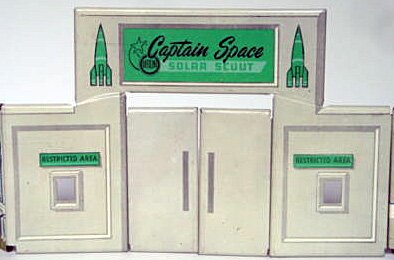 |
| Gate for Space Patrol Photo courtesy of Rick Eber, www.marxplaysets.com |
Gate for Captain Space Solar Scout Photo courtesy of Allan Ford, Ebay ID 610allanf |
Fence sections were about 3-1/2 inches tall and 9 inches wide. Walls in all the space sets had identical lithography. According to PFPC Issue 29, the lithography "is supposed to represent a glacier-type rock formation." I'd say that it simply shows an imaginary moonscape; veteran collector Josh Petrie has corrected me that it should be called a spacescape, because there is no grass on the Moon. But then, in 1952, who knew!?!.
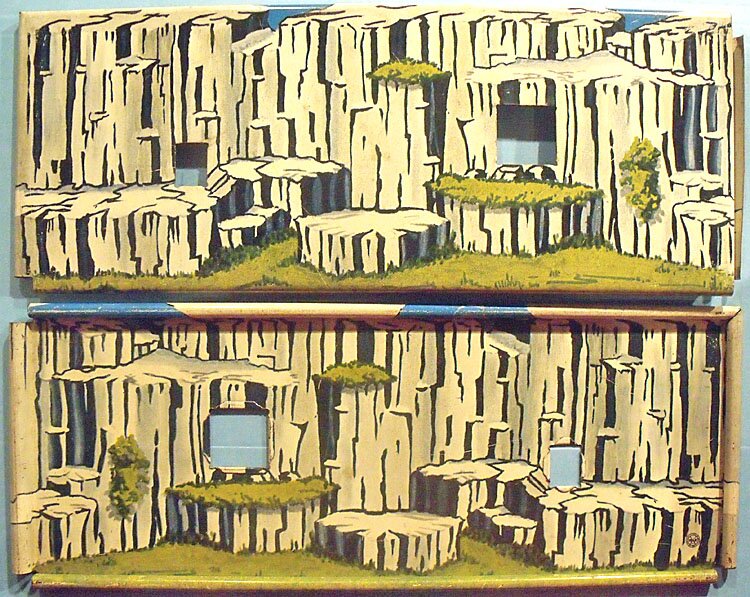 |
| Moonscape walls (outside on top, inside on bottom) |
Cape Canaveral
With the introduction of Cape Canaveral sets in 1958, gates were dropped from space sets and tin litho walls were down-sized to a smaller format, the type used in a few other playsets such as Zorro. This fencing was about 2-1/2 inches by 10-1/2 inches; no gate was made for the fence. The lithography was changed to represent an ocean shoreline, similar to those near NASA facilities in Florida. A notch in the middle at the top and bottom of these smaller walls allows them to be easily bent, if desired. The tin litho walls were last used in space playsets in 1961.
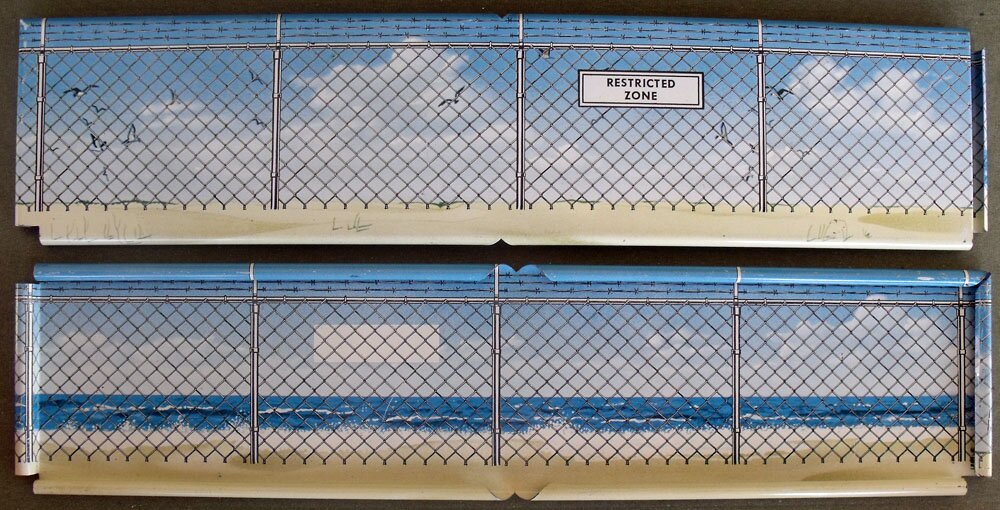 |
| Cape Canaveral walls (outside on top, inside on bottom) |
Small fencing
Small plank fencing was included in some space sets, good for security fencing inside the main walls or simply to divide separate sections of the space base. Plank fencing was about three inches wide; sections hooked rather firmly together. The fence was also used in other playsets, such as Gunsmoke and some farm sets.
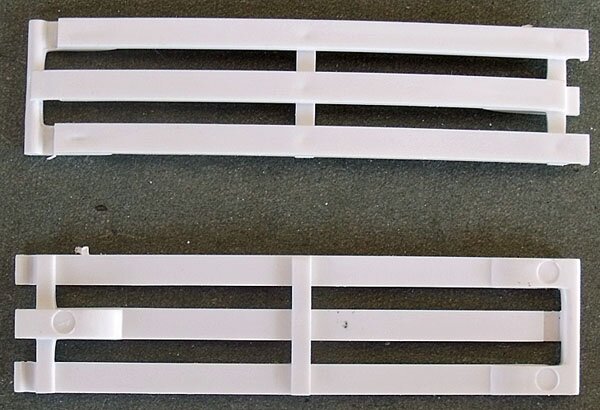 |
| Small plank fence (front side at top, back side at bottom) |
In a few playsets, barbed wire fencing was borrowed from earlier military playsets.
 |
| Barbed wire fence (PL-939) |
A taller "anchor" or mesh fence was included in a few space sets. About 5-1/2 inches wide and 2 inches high, it was first used in Cape Canaveral sets in 1962, as the company phased out its tin litho fences. The anchor fence had first been used in Marx Untouchables playsets and was included in some military sets.
This is my favorite type of Marx fence. It is sturdy, and fence pieces hold well when attached to each other. Each piece can be attached either in a straight line or at a 90 degree angle.
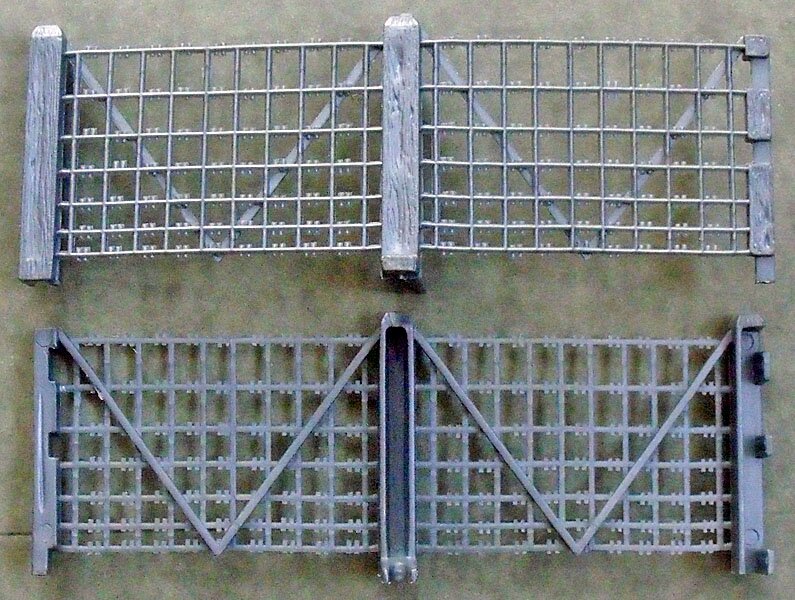 |
| Mesh or anchor fence Front side on top, back side on bottom |

| Buildings and Other Structures |
A wide variety of tin litho buildings were included in Marx space exploration playsets. Lettering on the buildings generally identified from which playset the building came. The few sets that were introduced after Cape Canaveral did not include tin litho structures, except for Moon Base sets which had a tin litho insert that fit inside the set's large vacuform mountain. The Moon Base building is shown with the set's mountain under this page's Terrain Section, along with the set's space platform and a few other small accessories unique to the set.
Early Playsets - Tom Corbet, Space Patrol, and Rex Mars
Early space sets came with a tin litho shoebox building in the same shape and size as many Marx Wild West buildings (such as the Alamo), about 12 inches wide, 5 inches tall, and 4 inches deep. However, for the space sets, a tower was added to the front of the building (11 inches tall and 3 inches square). Also, holes in the top of the building allowed the observatory accessory (see later on this page) to be attached with tabs on the observatory; the tabs were eliminated later, so that most observatory pieces found today do not have them. The building is open in the back, and the interior is colorfully lithographed.
The Tom Corbett building was generally silver with blue trim, and the tower was decorated with a rocket and lightning bolts. Space Patrol buildings were generally light blue instead of silver (though I believe the silver building shown below was from a Space Patrol set); Captain Space, some Rex Mars, and later Tom Corbett buildings were yellow. These early buildings had no lettering.
Marx instruction sheets suggested that the observatory and search light accessories (both described later on this page) should be placed atop the tower building. As shown in the photo below, the observatory should be on the left side, and tabs were included on early observatory accessories that fit into two holes in the building roof. Interestingly, the interior shows a round access portal right below where the observatory sits. Perhaps that is what the ladder accessory is for; the building is about five inches high, and the ladder (shown later on this page) is 3-3/4 inches. The searchlight simply sits inside a circle lithographed on the right side of the roof.
In addition, a metal clicker mechanism was included in early sets to be attached to the roof in back of the tower, allowing kids to click out messages in "space code", which is shown on the back of the tower (see photo below). This code is actually Morse Code. The building shown below shows the code, but was made without a clicker.
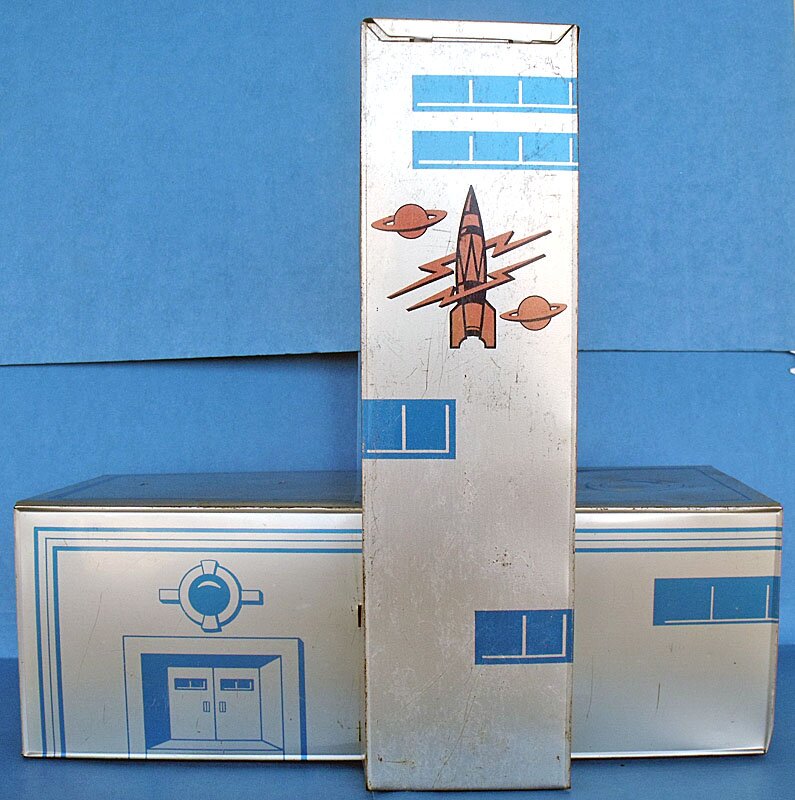 |
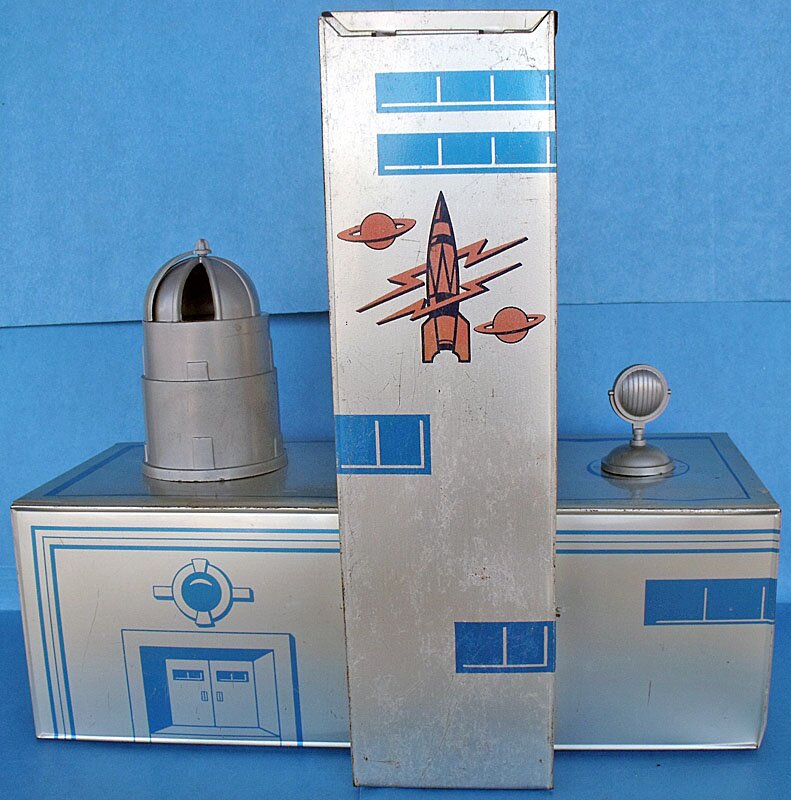 |
| Early tower building | Tower building with accessories in place as suggested by Marx instruction sheets |
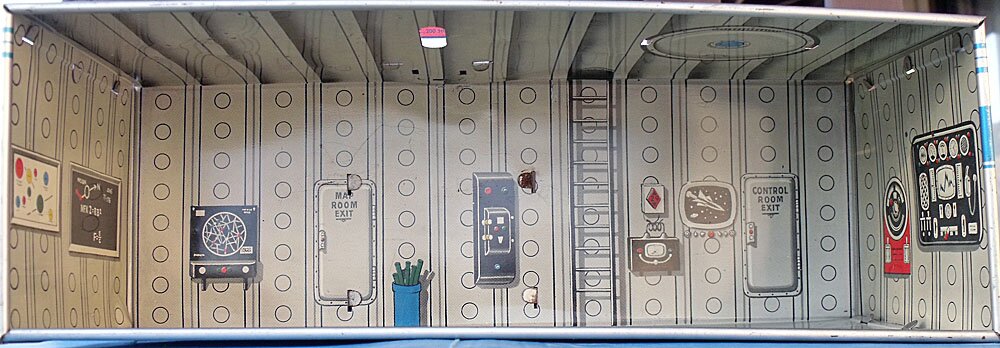 |
|
| Tower building interior | |
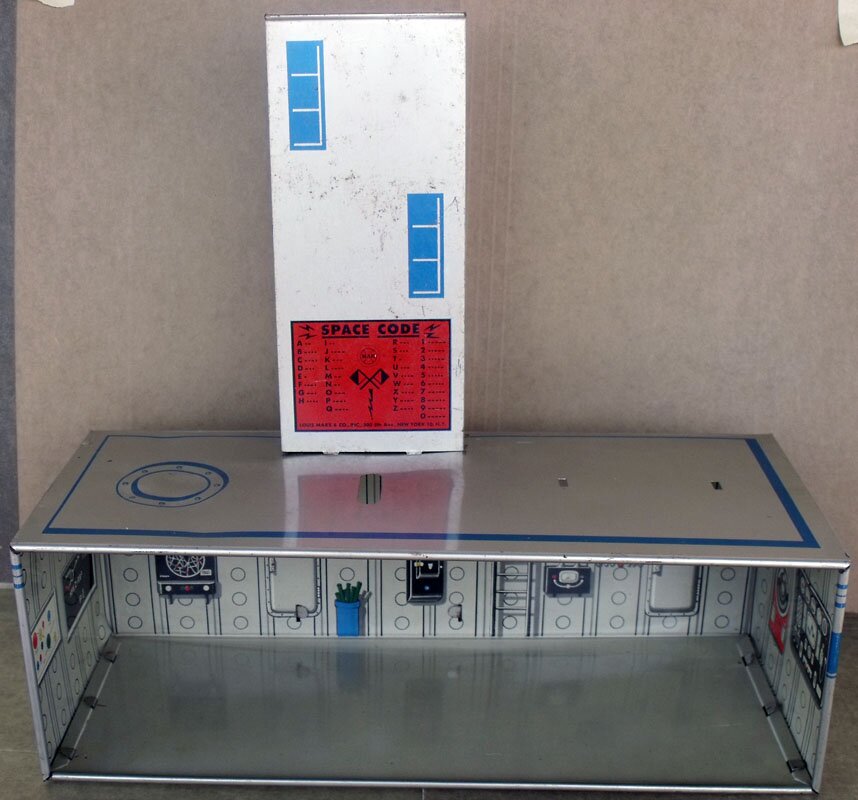 |
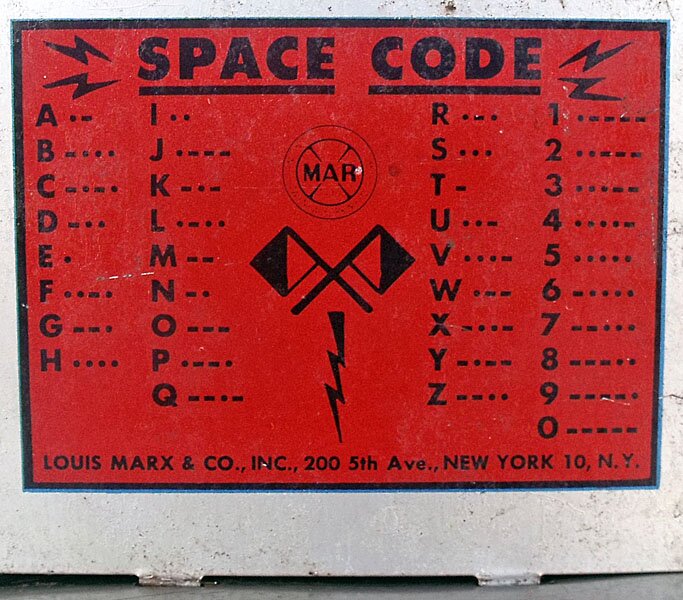 |
| Back of tower building Note the lack of the code clicker mentioned in the above narrative, though the holes for it and for the observatory tabs are still there. |
Space code sign on back of tower |
Cape Canaveral Playsets
According to PFPC Issue 46, early Cape Canaveral playsets had T-shape buildings (also referred to as thrust-front buildings by collectors), with the main structure again based on the standard shoebox shape. However, these attractive structures feature an upper floor that juts several inches out from the front of the building, with lithography of large windows displaying equipment inside the building. These extend the depth of the building and are about a foot long. Based on photos I have seen of these buildings, it would appear that the company simply changed the position of the "tower" from its early space buildings, so that the longer wide of the "tower" was horizontal to the ground.
The back of the building is open, and the interior is identical to the interior of the earlier Tom Corbett buildings; it is the only Cape Canaveral building with a lithographed interior. Including a large gray radio antenna on top of the upper level (the same as on the company's skyscraper structure), the building is about 14 inches tall. The hard plastic tower is three pieces, a left and right side with tabs to hold them together plus the antenna. As it sits on top of the thrust portion of the building, it actually overhangs each side by a fraction of an inch.
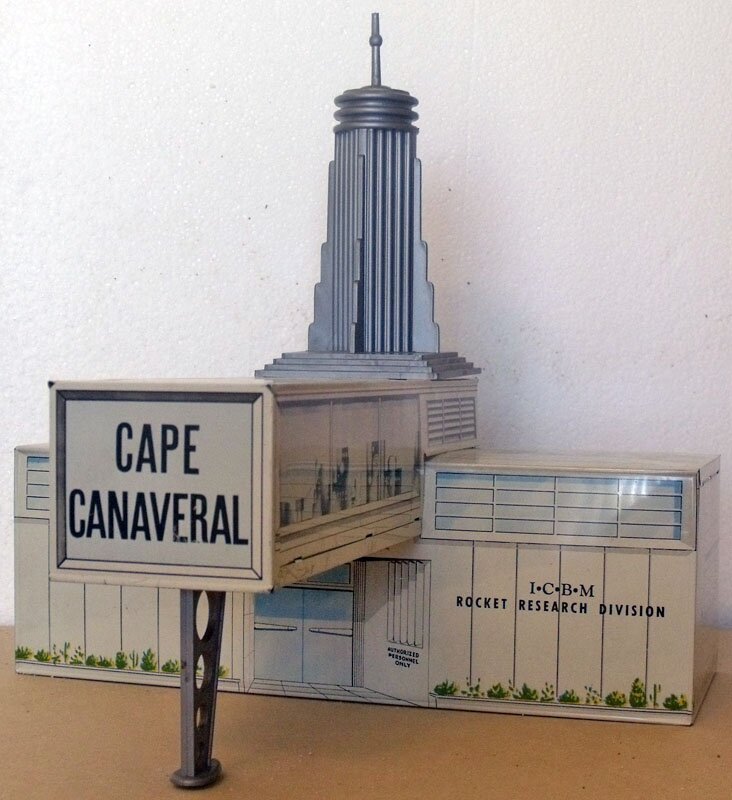 |
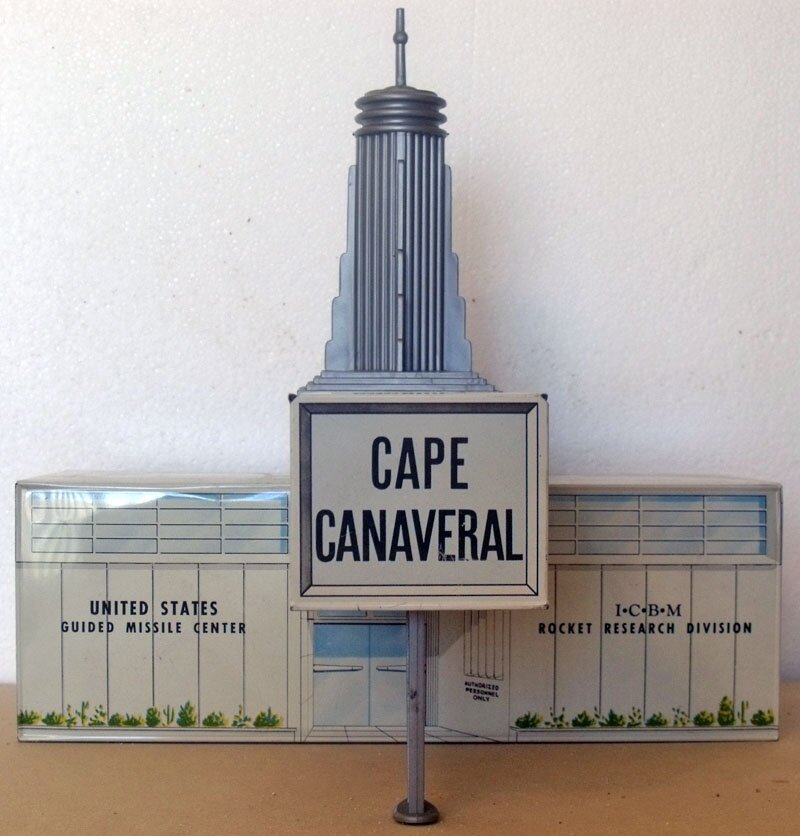 |
| Thrust-front space building Top of tower's antenna is broken off |
|
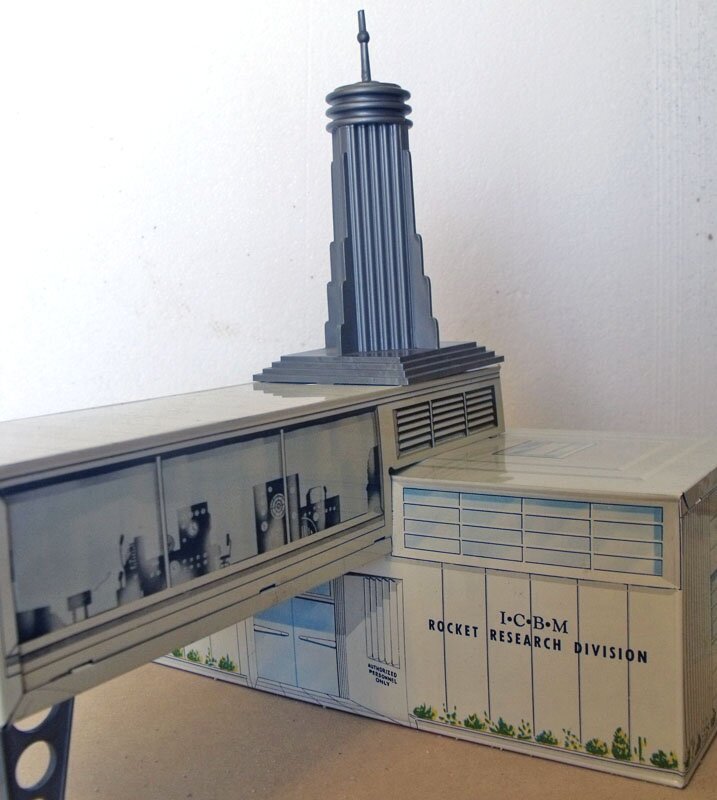 |
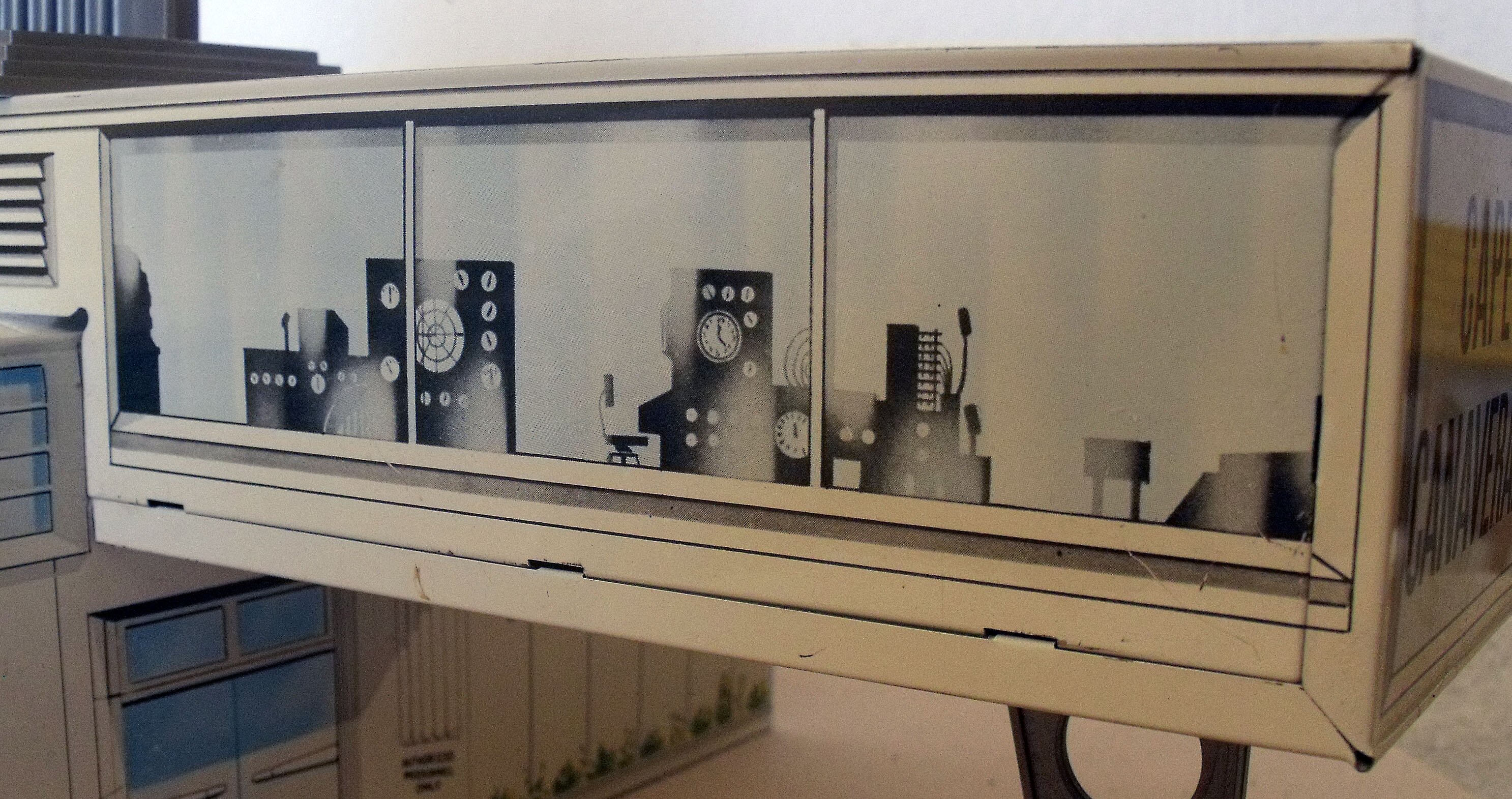 |
| Thrust front from right side | Close up of thrust front from left side |
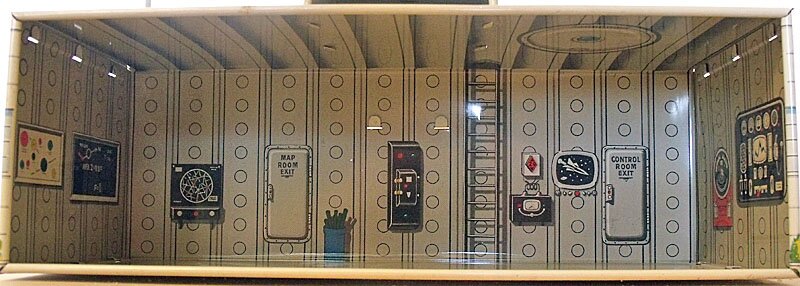 |
| Inside of space building as seen from open back This is identical to the interior used in earlier space buildings |
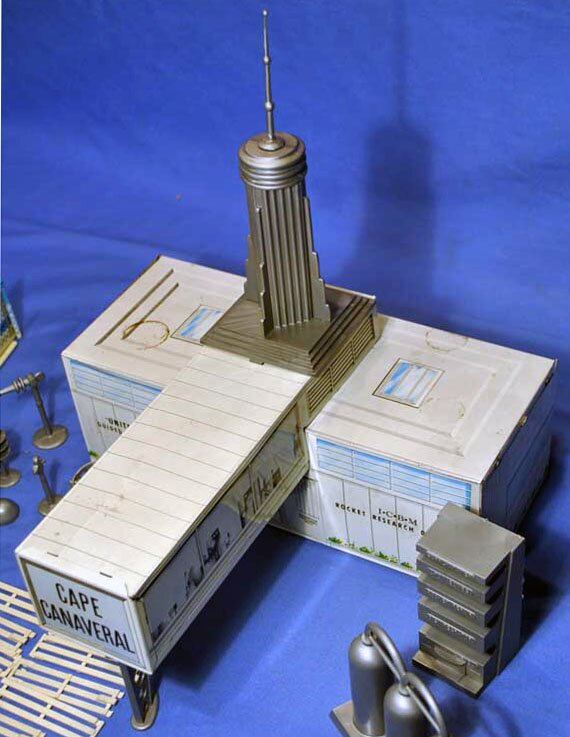 |
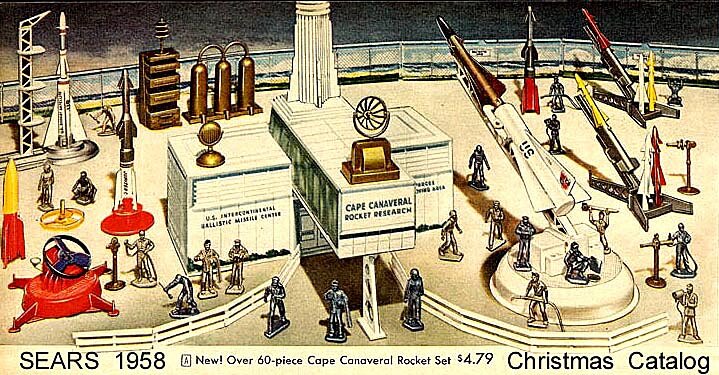 |
| Thurst-front building from overhead Photo courtesy of Colleen, Ebay ID tink642 |
T-shaped building in Sears Roebuck advertisement for Cape Canaveral Playset Photo courtesy of Kent Sprecher |
About a year after Cape Cavaveral sets were introduced, the tin litho structures were changed back to a tower building, the same shape and size of those in the early Tom Corbett sets. However, the lithography on the buildings was more realistic. And missing were the roof top holes to attach the observatory accessory and the clicker mechanism to send messages. PFPC Issue 46 reports that this version had no interior lithography, but the one shown below certainly did, the same as in earlier buildings. PFPC states that the building is about 12 inches wide, 6-1/4 inches deep, and 11 inches tall.
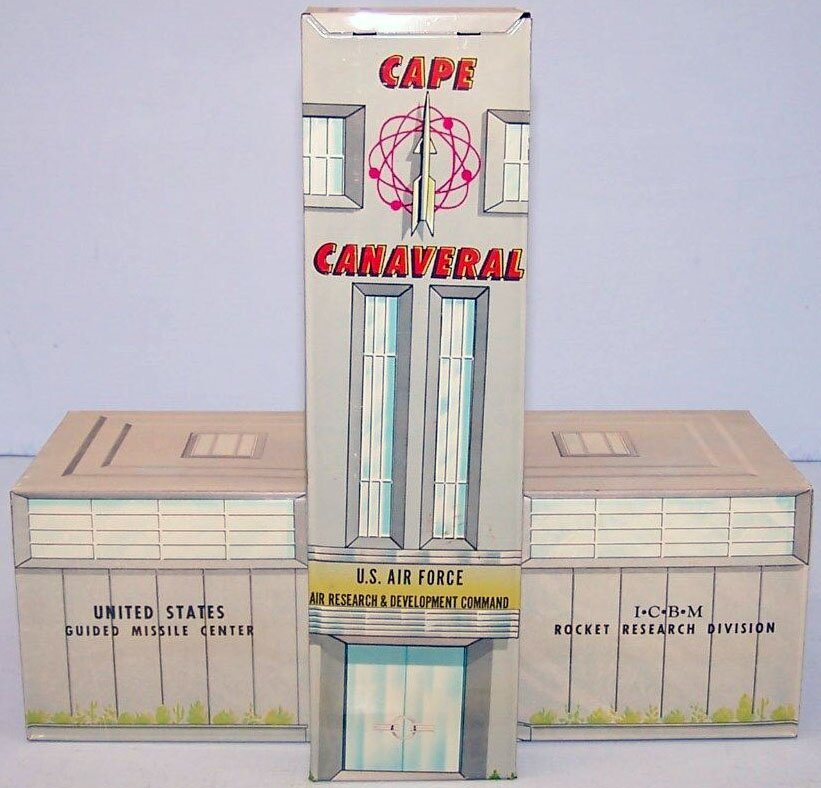 |
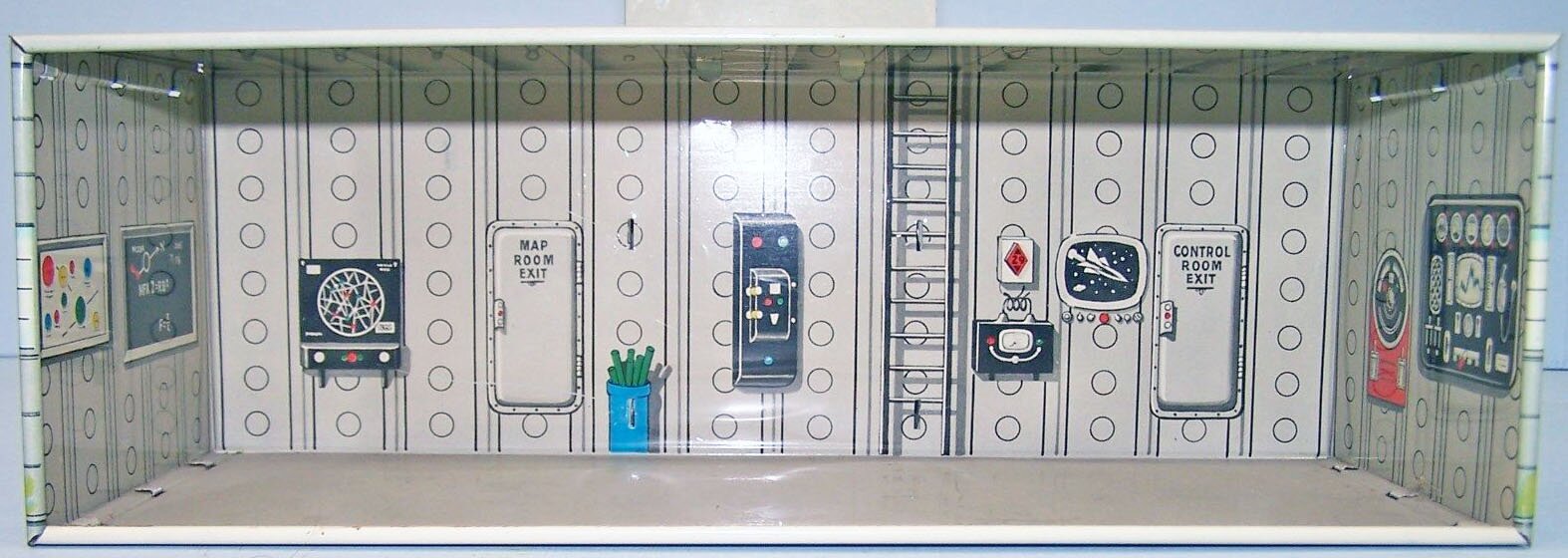 |
| Tower building used in a few Cape Canaveral sets Photo courtesy of Ebay ID Marxy1950 |
Inside of tower building as seen from rear Photo courtesy of Ebay ID Marxy1950 |
In addition to the two T-shaped buildings, two or three early Cape Cavaveral sets had a "shoebox" building that used the same stamping as such buildings as the Alamo and Zorro playsets. PFPC reports that these are very hard to find today. The buildings had the open back door as seen on the Zorro hacienda, but otherwise are enclosed on all four sides with no interior lithography. "Cape Canaveral" is printed in attractive silver letters above the lithography front door. As on the T-shapped buildings, other signs on the front read "United States Guided Missile Center" and "ICBM Rocket Research Division."
Perhaps the best known and most popular Cape Cavaveral building made by Marx is the "red top" building, first included in the 1960 Atomic Cape Canaveral Playset, according to PFPC. I'd say that it is the most attractive tin litho structure that Marx made in the space theme.
Three versions were made. The ones shown below are both the original version that came in the Atomic set with the ARDC logo beneath the words Cape Canaveral and above the U. S. Air Force designation. The building is generally a tan as shown in the first picture, rather than the lighter color shown in the other photos.
In the second version a NASA logo replaces ARDC, and the Air Force title is replaced with National Aeronautics and Space Administration. The third version, which came only in the 1966-67 Project Apollo Cape Kennedy Playset -- is identical to the second version, except that it reads Cape Kennedy instead of Cape Canaveral.
The tin litho building is a foot wide, 13-1/2 inches tall, and 4 inches deep. The delicate red top is made up of eight seperate hard plastic pieces -- the base with fence, two stairways, four antenna devices, and a flag pole -- plus a 50-star tin litho flag. I have no idea what these "antenna" represent, but perhaps someone out there can enlighten us? The plastic pieces are often broken in buildings found on the market today.
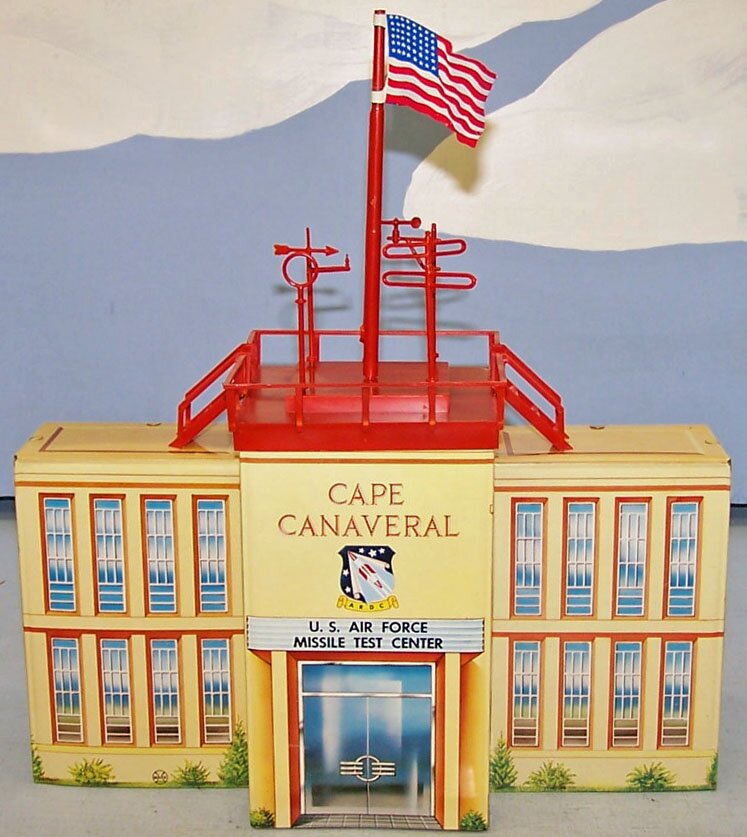 |
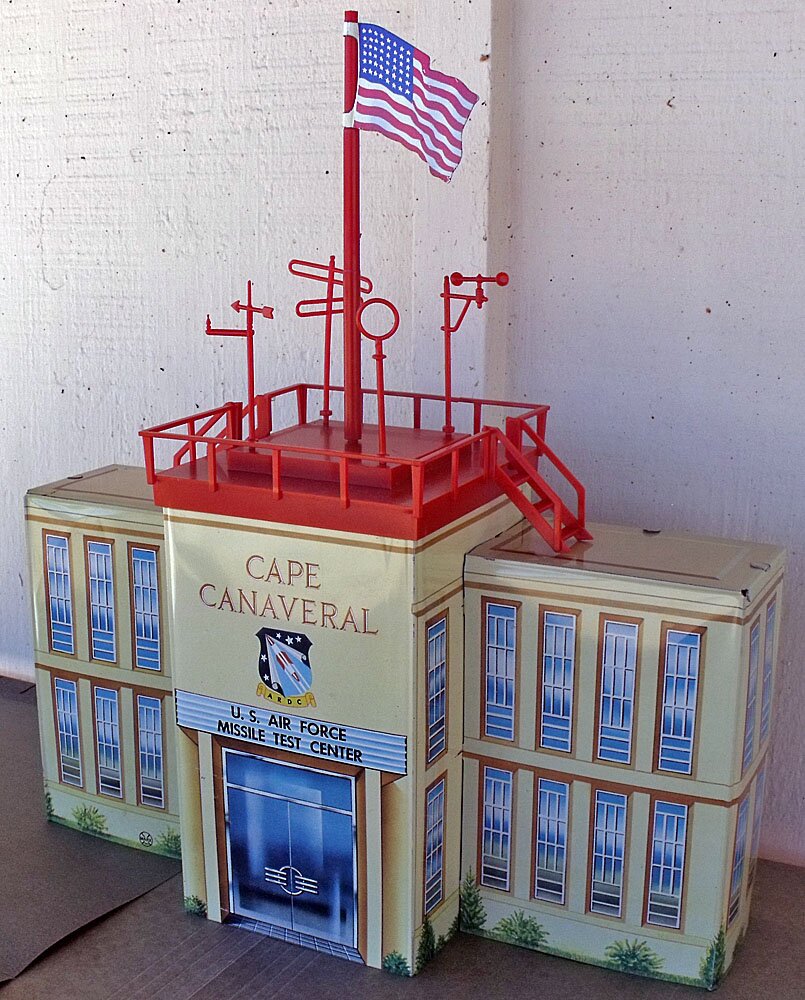 |
| Cape Canaveral headquarters building - red top version Photo courtesy of Dan, Ebay ID marxy1950 |
Cape Canaveral headquarters building - red top version |
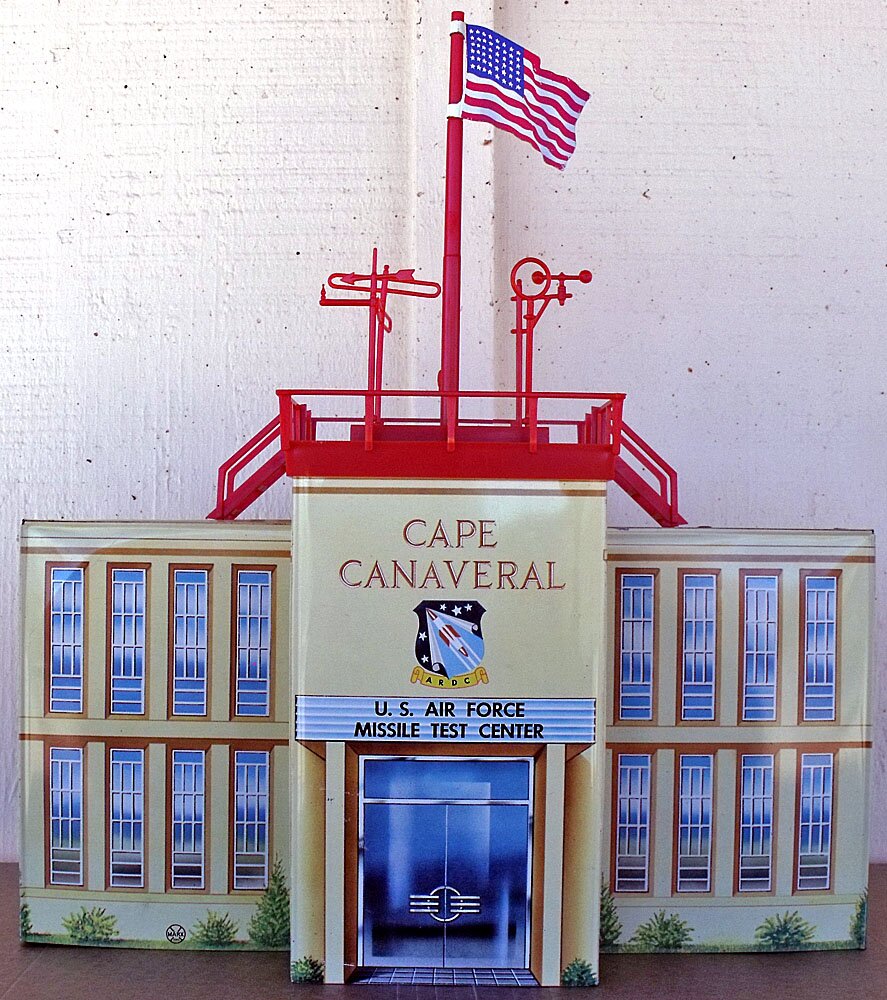 |
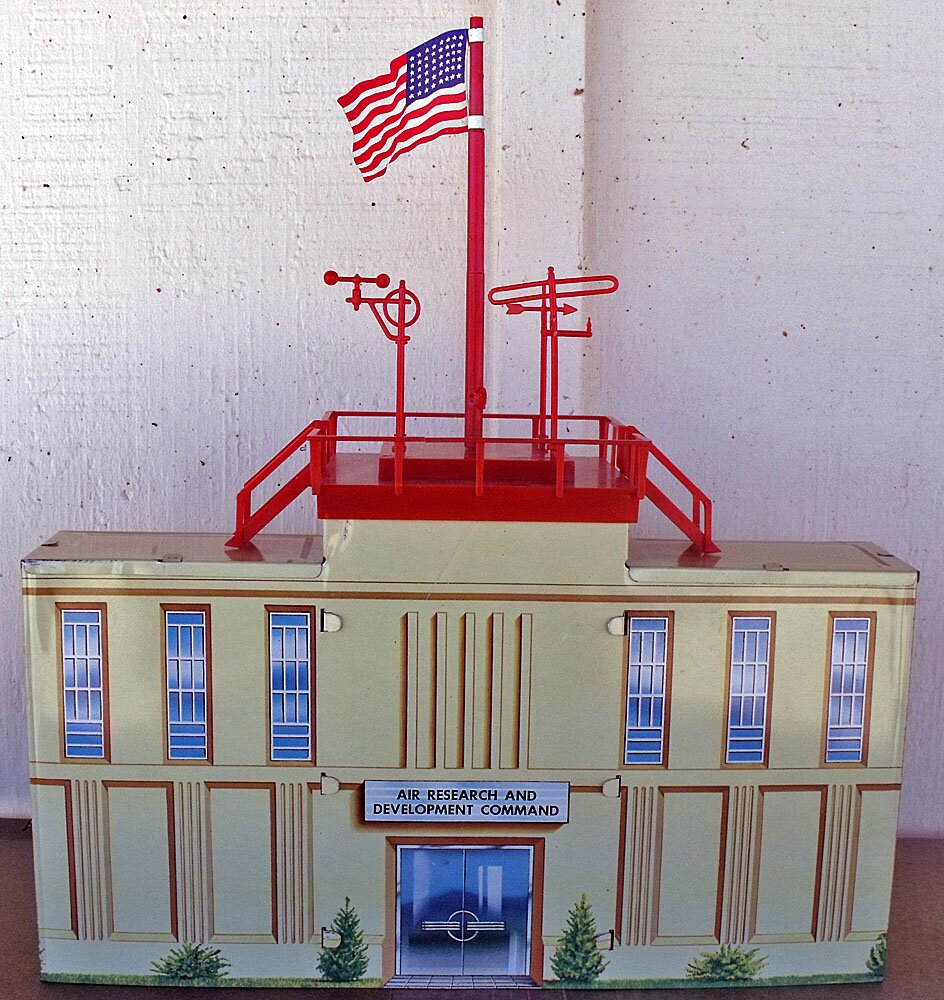 |
| Front and back sides | |
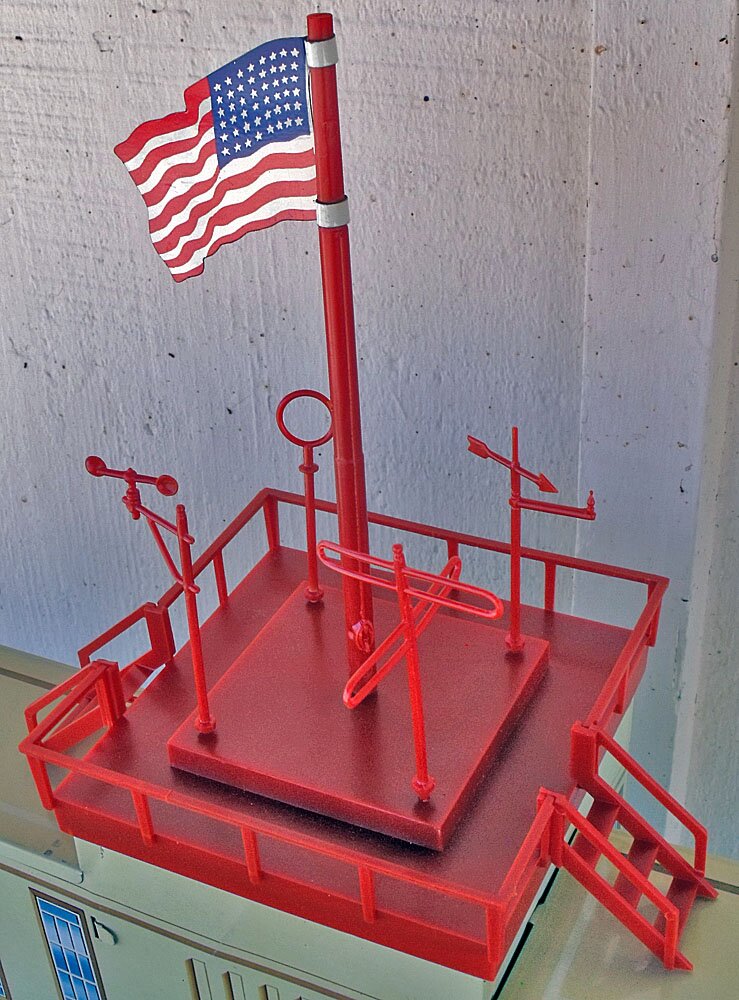 |
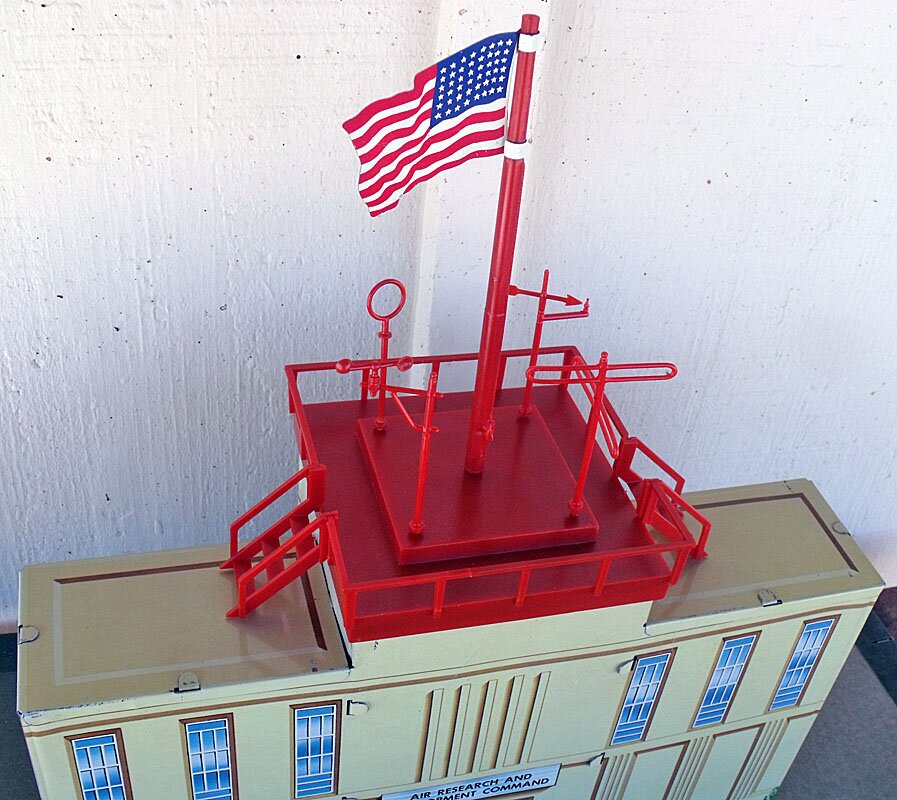 |
A more difficult Cape Canaveral tin litho structure to find today is the shoebox building. Identical (except for the litho) to the Zorro structure with a large door cut out on the back side, it is identified as Cape Canaveral in silver 3-D style letters across the top on the front side. PFPC Issue 46 notes that it initially had a tin awning borrowed from the Marx Skyscraper playset (perhaps in only one set), which was later changed to the semi-round plastic awning in the company's Jetport sets. In a small number of sets, it had no awning at all. The inside of the building is white with no litho.
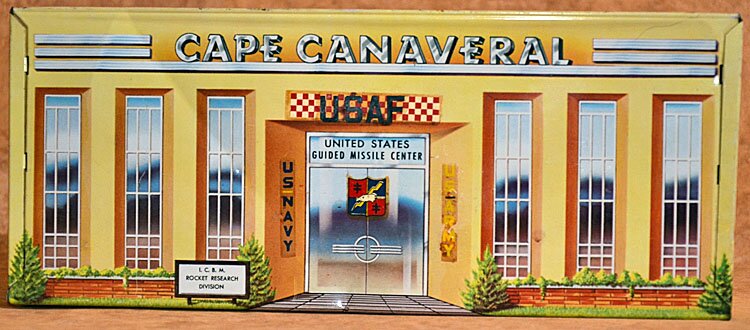 |
| Shoebox building, version without awning - front Photo courtesy of Diane Grams |
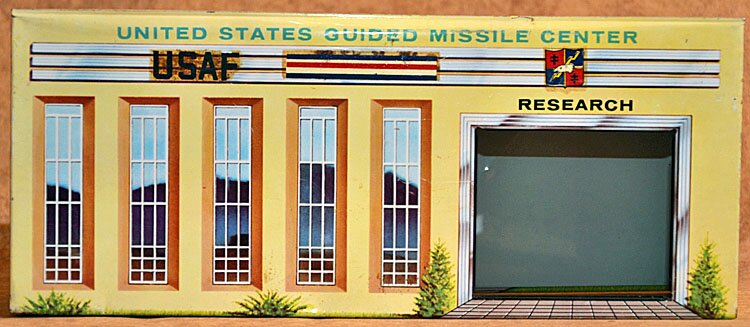 |
| Shoebox building - back Photo courtesy of Diane Grams |
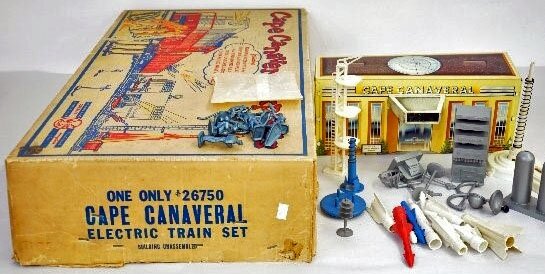 |
| Shoebox building with awning in Cape Canaveral Train Set Photo from Diane Grams |
This same building, using different litho, also was used for an Air Force Missile Center playset. A similar building litho was used on Marx airport terminals.
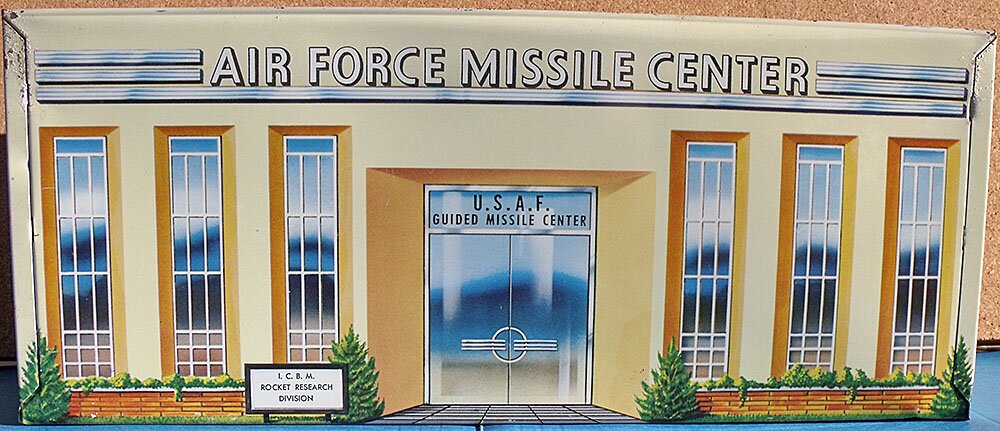 |
| Shoebox building, version without awning - front |
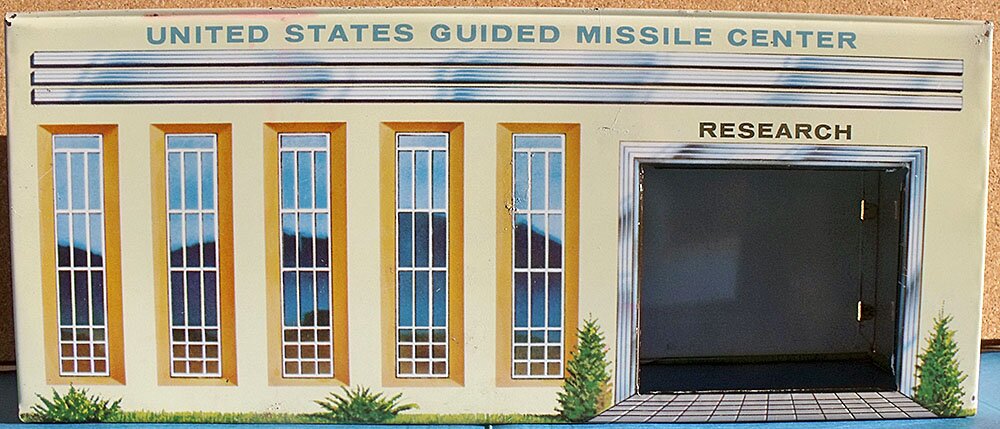 |
| Shoebox building - back |
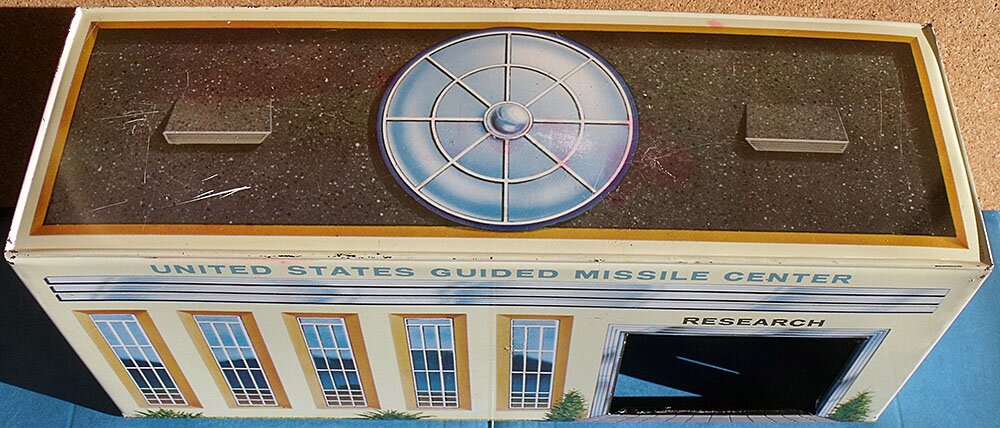 |
| Top view of building |
Another seldom seen accessory is the tin litho building for the Raytheon Missile Test Center set. The sets were made specially for Raytheon, a military contractor, as an employee perk. The building is similar to the Marx military Training Center buildings and was made in very limited quantities.
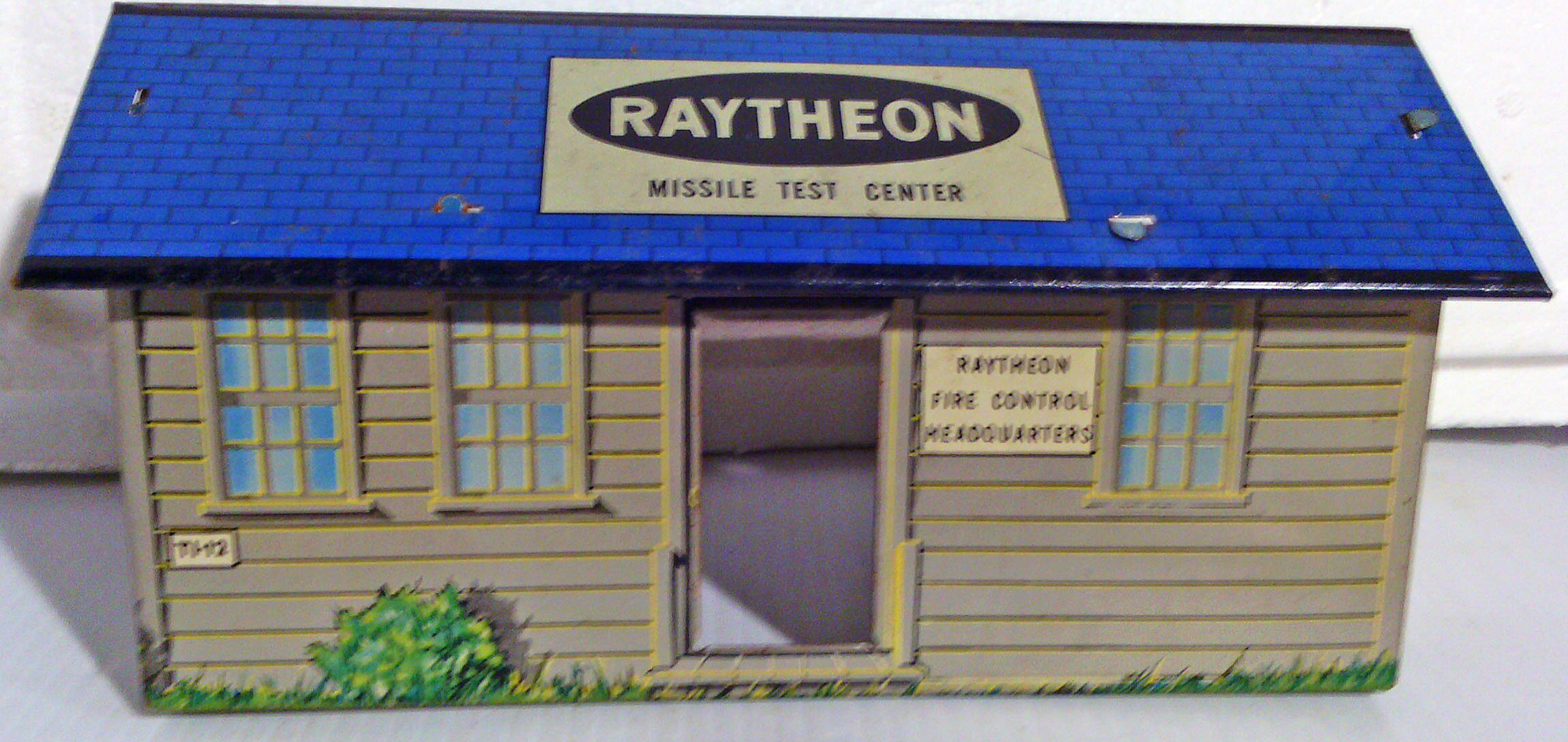 |
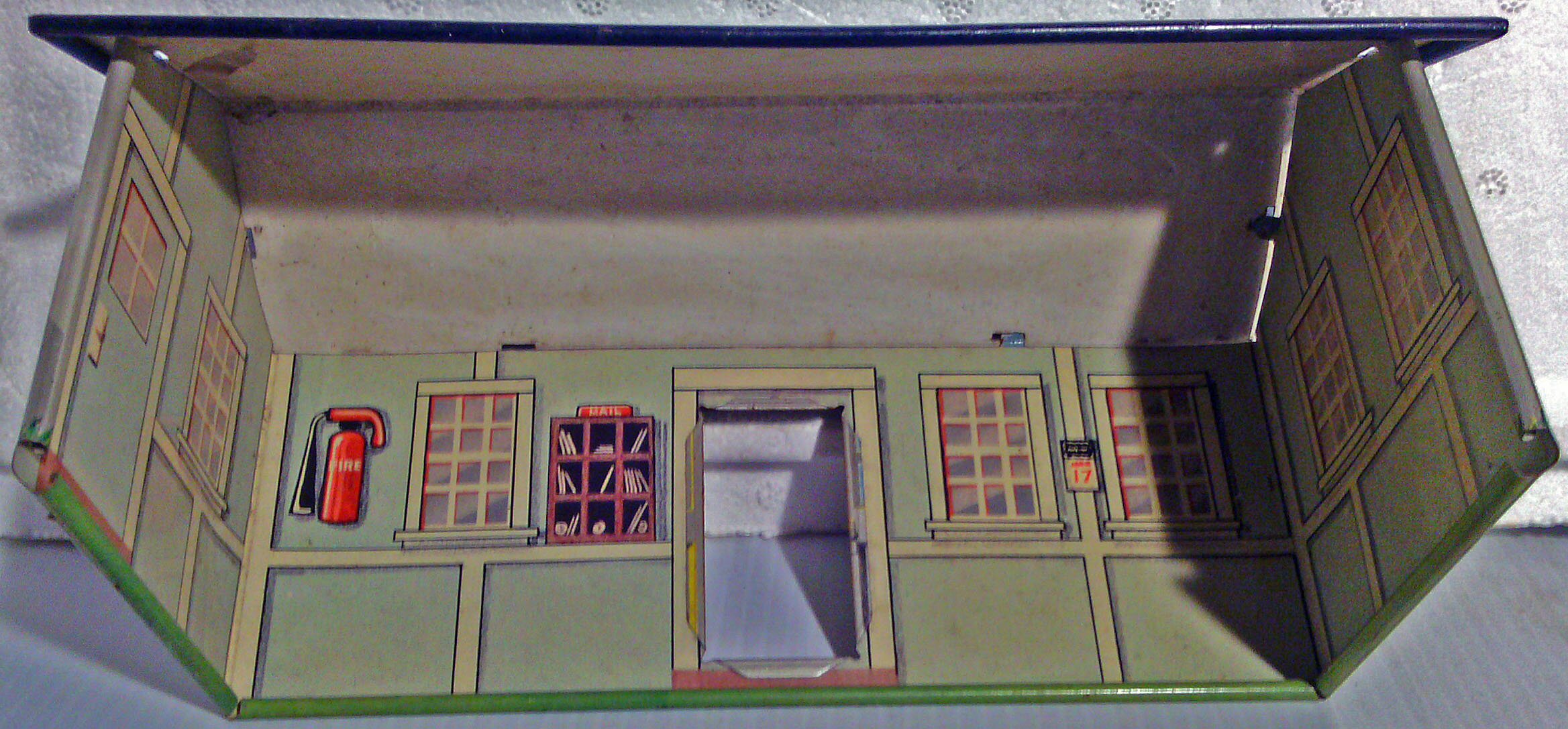 |
| Raytheon Building Photos courtesy of collector Emerson McGowan |
|
A second hard-to-find playset that used the same building as the Raytheon set is the Satellite Launching Station released in 1958, according to PFPC Issue 46. The basic lithography is the same, but there is no sign on the roof and the sign on the front reads "U.S. Satellite Headquarters. The PFPC article states that it has "the same silver clapboard siding and the bright blue shingled roof." Although obviously a space-related set, the set included Marx 45mm Army training center figures.
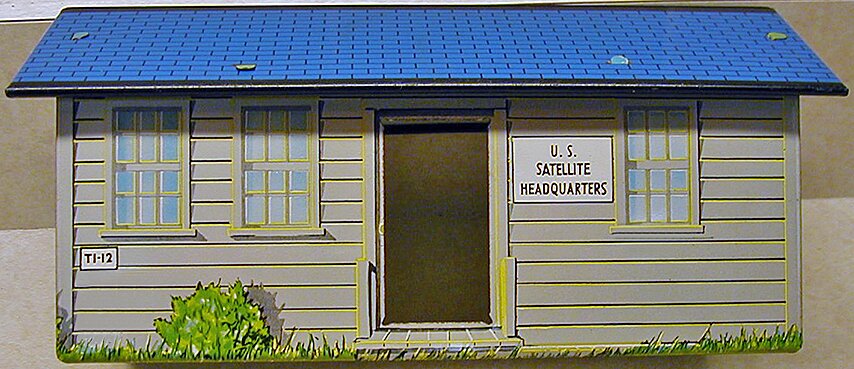 |
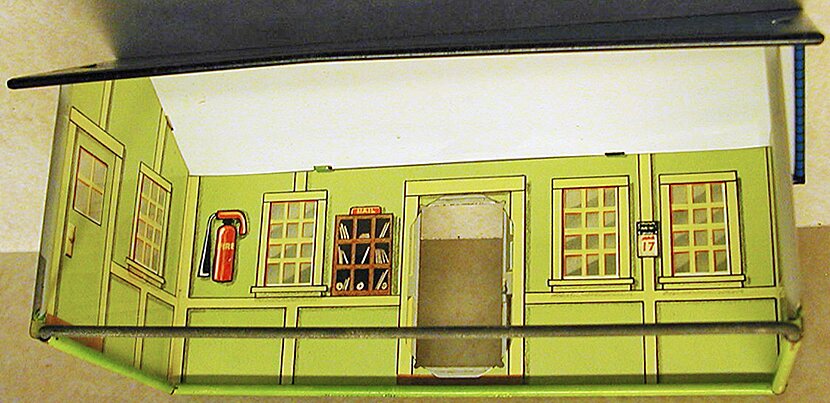 |
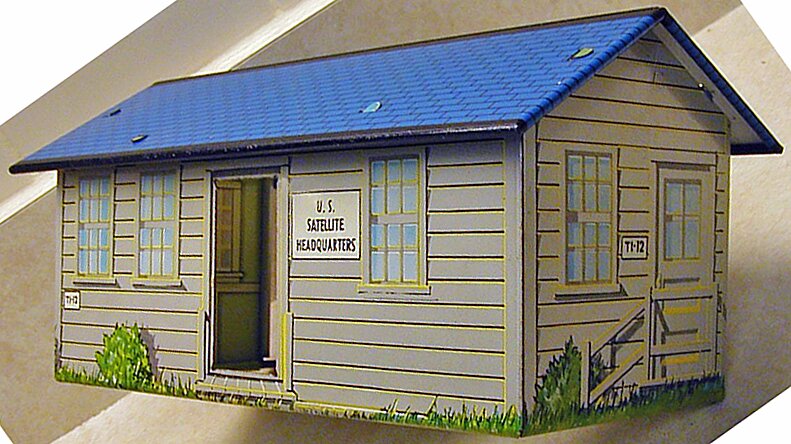 |
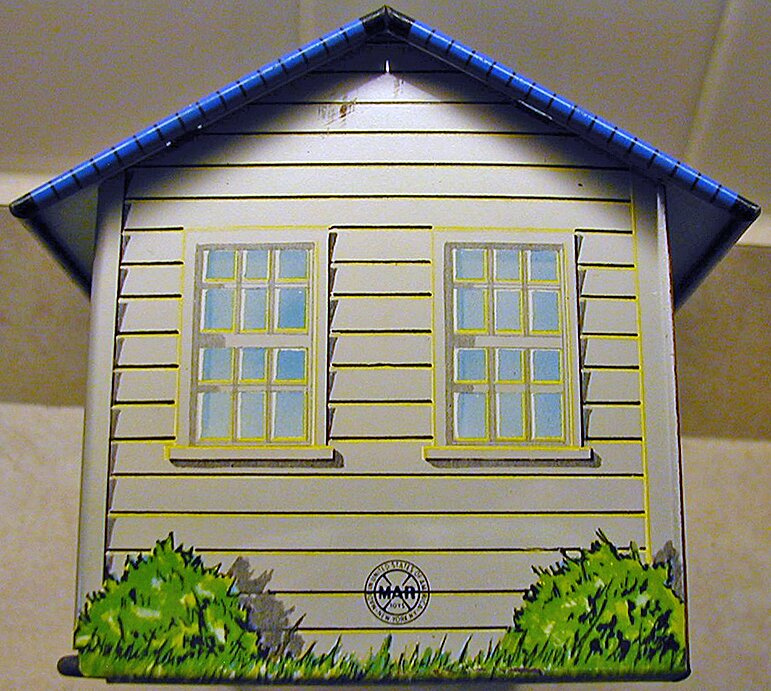 |
| U.S. Satellite Headquarters Building Photos courtesy of collector David Gladd |
|
International Geophysical Year (IGY) - Arctic Satellite Base
This 1958 playset is a representation of a renowned scientific station established by scientists from around the world to study the Arctic north, according to Playset Magazine Issue 32. The station operated in the midst of the 1957-58 space race between the U.S. and Russia. The PM article notes that besides the scientists, the station housed U.S. Air Force planes, rockets, and igloos built to house native workers. The IGY Arctic Satellite Base is one of the more difficult space playsets to find.
The set -- numbered #4800 -- uses a gate, fencing, accessories, and figures similar to other space sets, but also includes eskimo figures and accessories from the Wild West Alaska Playset (see the Wild West section) and the quonset hut used in some construction and other Arctic-based playsets. As noted below, the contents of the set are listed in the PM Issue 32 article, which includes numerous photos.
 |
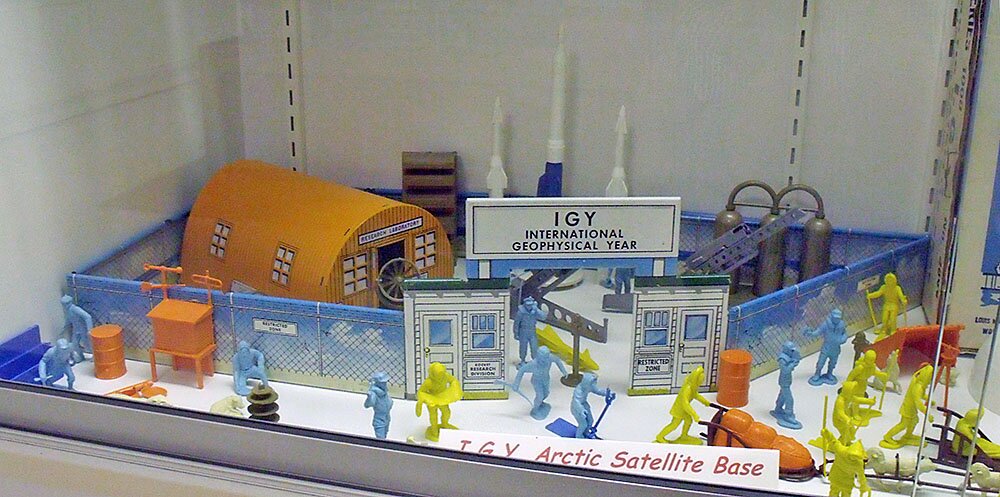 |
| IGY Arctic Satellite Base box Photo courtesy of collector Willis Beyer |
IGY Arctic Satellite Base Photo is of display at the Marx Museum in Moundsville, West Virginia |
 |
 |
| Contents of IGY Arctic Satellite Base playset Photos courtesy of collector Willis Beyer (Note that a few items are included in both photos. Playset Magazine Issue 32 has a detailed list of set contents.) |
|
Galaxy Command
In one of its final efforts to stay financially viable, Marx produced a Galaxy Command Playset in 1979. According to PFPC Issue 49, this set included two vacuform structures: a rocket platform and a control center. Both were in an "L" shape and were about one foot by 8 inches and about an inch-and-a-half high. The rocket platform included a position for the old Tom Corbett gravity chamber and four pegs that held four waxy orange rockets, but no launchers. The control center has a position for the Tom Corbett fuel tanks and a clear dome that covers a circular, molded-on control panel.
Note that the photos below are from Fritz and Bettina Berg of Toys and Stuff. Despite their web site, I can find no way to contact them. They have contacts of similar sites on their site, so I think they will not mind me using them. However, if you are them, please contact me, or if you know them, please let me know how to contact them! I generally do not use photos without permission, but these are so wonderful, I could not resist.
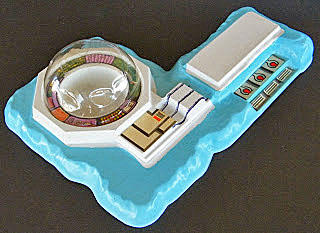 |
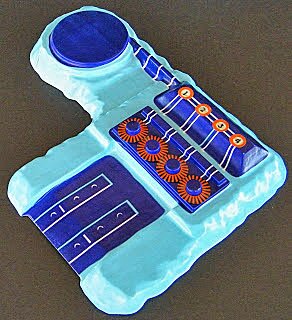 |
| Control center Photo courtesy of Fritz and Bettina Bert of Toys & Stuff |
Rocket platform Photo courtesy of Fritz and Bettina Bert of Toys & Stuff |
Cape Cheerios Structures
Surely the most difficult Marx space structures to find now are the five cardboard structures for the Cape Cheerios Rocket Base. This small cereal premium set was sold in the late 1950s for fifty cents and two Cheerios boxtops. The set came with eight of the Air Force/Cape Canaveral figures, the company's first 3-stage missile with gantry (see section below on rockets and missiles), and a sheet of decals to decorate the rocket.
Buildings for the set, however, were cut-outs on the cereal boxes. By purchasing five boxes of Cheerios, you could get a headquarters building, a 3-story barracks for your spacemen, a rocket repair pit, a radar tracking station, and a domed fuel tank. Wouldn't it have been great to have those in tin litho? Of course, if you need a barracks, you could always confiscate one from a military playset! An advertising sheet that came with the set provided a map showing how to lay out the rocket base (see below).
PFPC Issue 36 has an excellent article on the Cheerios set, written by current Playset Magazine co-editor Rusty Kern. The black-and-white photo below is from that article. The other photos show the back of the five Cheerios boxes that had the buildings printed on them, which were recently auctioned off by Hake's Americana & Collectibles (www.hakes.com). The winning bid was $115, which I would consider a good deal based how scarce I believe they must be today. Many thanks to a collector who prefers to be identified simply as Kaptain for pointing them out to me!
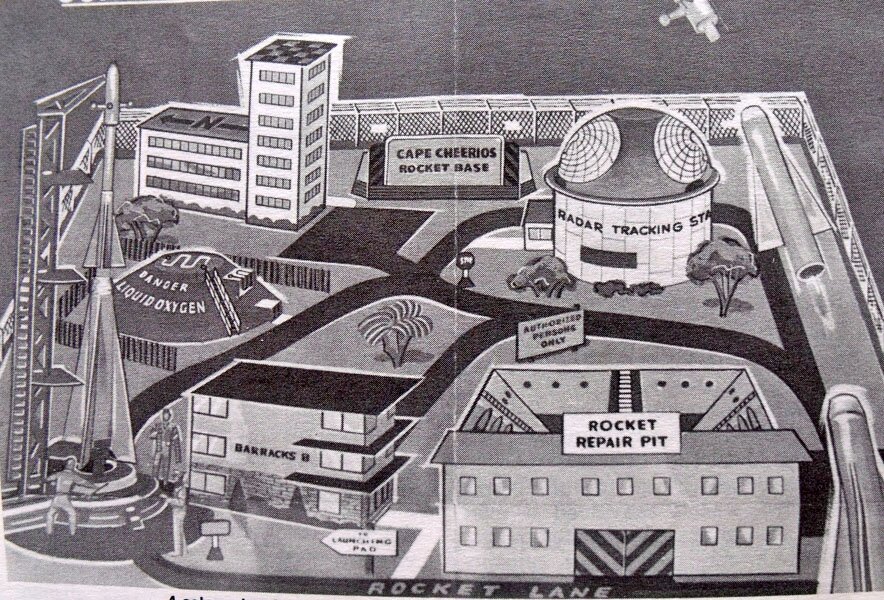 |
| Advertising sheet that came with Cape Cheerios Rocket Base playset, showing the five cardboard structures that came on cereal boxes Picture from PFPC Issue 36 |
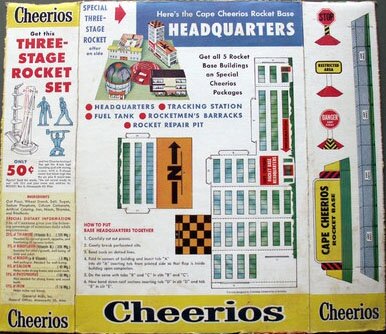 |
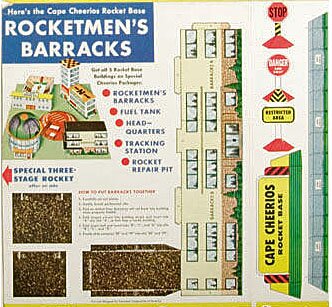 |
| Headquarters Photo courtesy of Hake's Americana & Collectibles, www.hakes.com |
Barracks Photo courtesy of Hake's Americana & Collectibles, www.hakes.com |
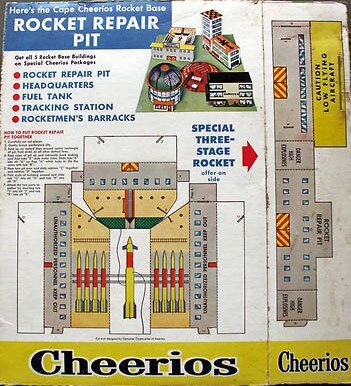 |
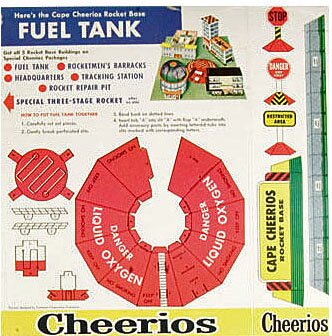 |
|
| Tracking Station Photo courtesy of Hake's Americana & Collectibles, www.hakes.com |
Rocket Repair Pit Photo courtesy of Hake's Americana & Collectibles, www.hakes.com |
Fuel Tank Photo courtesy of Hake's Americana & Collectibles, www.hakes.com |

| Small Accessories |
Academy Furniture
(PL-469)
Because the company's first space exploration playsets were identified as space academies, initial indoor furniture was training related, such as desks and flip chart easels. These were made originally in light blue and later in other colors. Marx made no other indoor furniture for its space sets. Though not used in Cape Canaveral sets, this furniture was included in a gold color in the Captain Space set in 1957 and 1962's Operation Moon Base.
Of items included in this group, I have to say that the student desk is one of the oddest accessories that Marx made. Totally unadorned, it had me befuddled when I received it in the mail. What is it and which end is up? I had to check out Playset Magazine to figure out what it was supposed to be and how it was supposed to stand. Seems like they could have at least molded a couple of books on top of it like the teacher's desk. And too bad there is not some writing on the easel...could have been a nice mystery for us old folks trying to figure out what it meant!
The fragile ladder is tilted slightly backwards and is 3-3/4 inches tall. Based on my experience, it is almost impossible to find an original ladder that has not been broken off its base. As noted earlier, the ladder fits well as access to the circular door painted in the interior lightography of early space buildings. The door appears to be the entrance to the set's undersized observatory, which is meant to sit on top of the buildings.
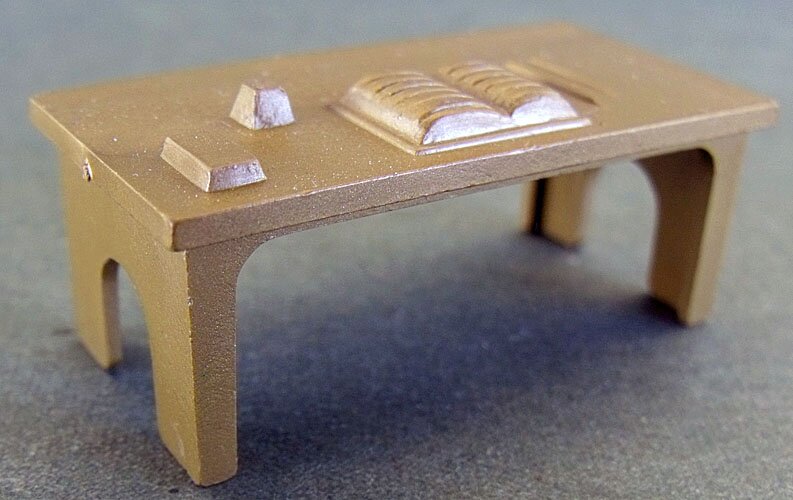 |
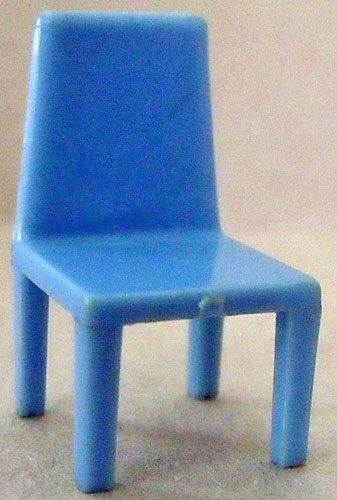 |
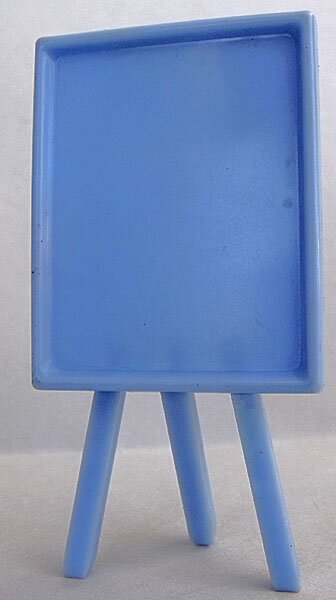 |
| 1. Teacher desk |
2. Desk chair | 3. 3-legged easel |
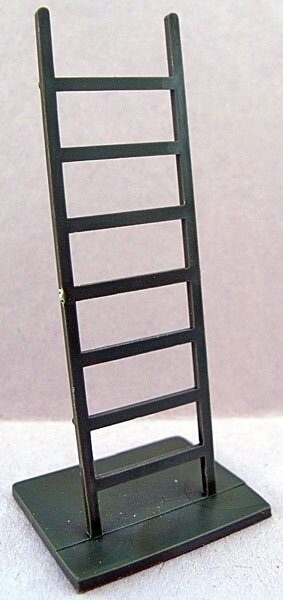 |
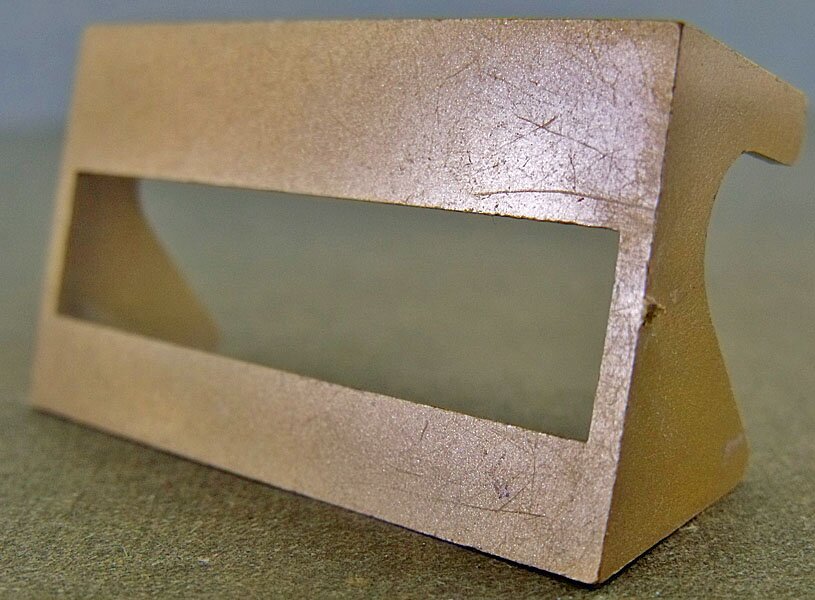 |
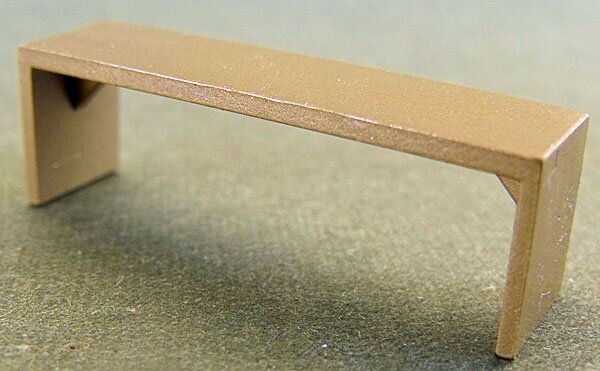 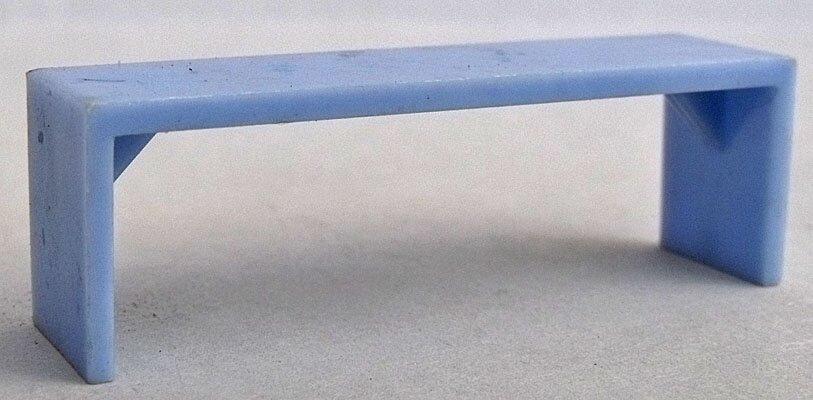 |
| 4. Ladder on base Re-issue ladder from Hobby Bunker |
5. Student desk |
6. Student bench |
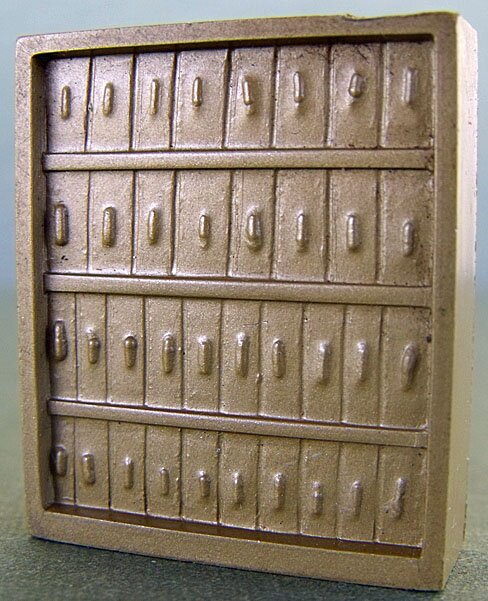 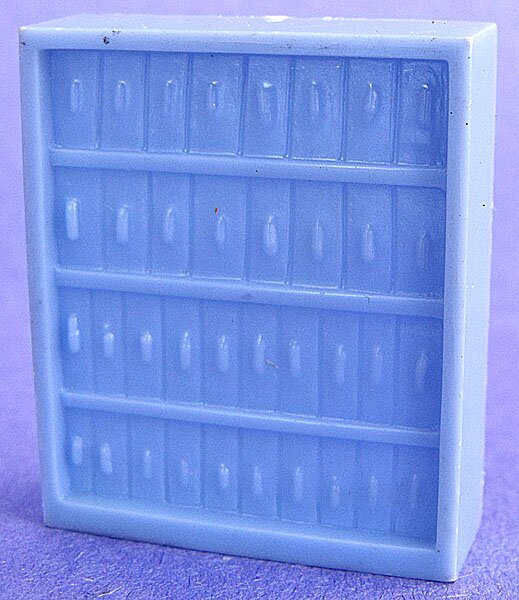 |
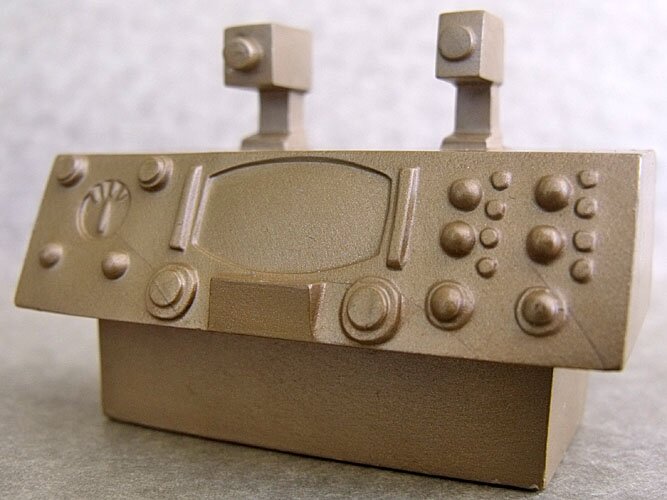 |
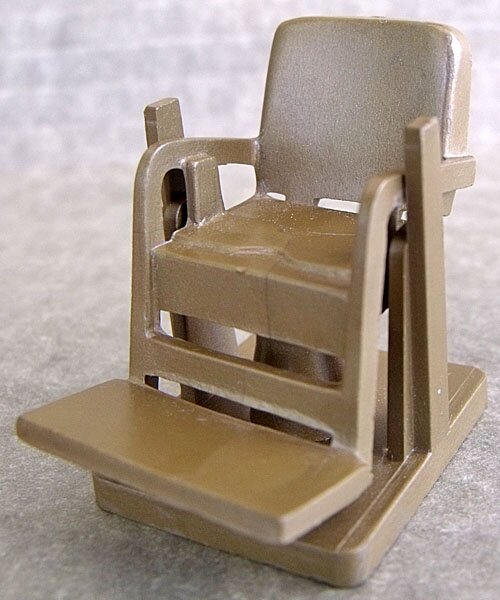 |
| 7. File cabinet |
8. Rocket control console |
9. 2-piece control console chair |

Tom Corbett Field Accessories
(PL-470)
This group of accessories was first used in the Tom Corbett Training Academy and other early sets in hard plastic silver. These remained the sole small accessories in space playsets for several years and were included in almost all Marx space play sets through the company's demise in 1979, including the Galaxy Command Playset released that final year. PFPC Issue 49 calls Galaxy Command's accessories a "pale lime green." The pieces also can be found in blue, orange, yellow, and probably a few other colors.
My favorite of the group is the supply cabinet, which seems to have a drawer full of atom bombs, something that I don't think would be sitting around in a cabinet anywhere. Especially when launching fuel is stored two drawers down. On the other hand, where do we store our atom bombs? Collector Kaptain (he prefers that nickname) has brought up an interesting theory on this accessory that I have not heard elsewhere. Kaptain states, "One of the most common mistakes is that the Supply Cabinet is just that. It's actually a multi-story building roughly on the same scale as the speaker tower and gravity dome." I understand his reasoning and can, in fact, see what might be entrance doors at the bottom of the accessory. I suppose that is possible, but even then, I can't see the military (or NASA?) erecting a building and advertising in large letters on the facade that atom bombs are stored inside! I'll just set up the cabinet/building along with the others on my display shelf and let the viewer decide what he or she is looking at!
Another interesting side note is that in early sets, the greatly down-sized observatory had tabs on the bottom that fit into holes in the top of the tin litho space building. This obviously made it a more realistic-looking observatory, though still vastly undersized.
Due to the variance in size of the items, I have not posted these items in exact proportion to one another.
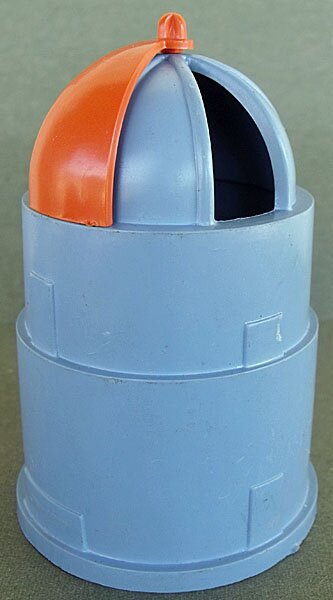 |
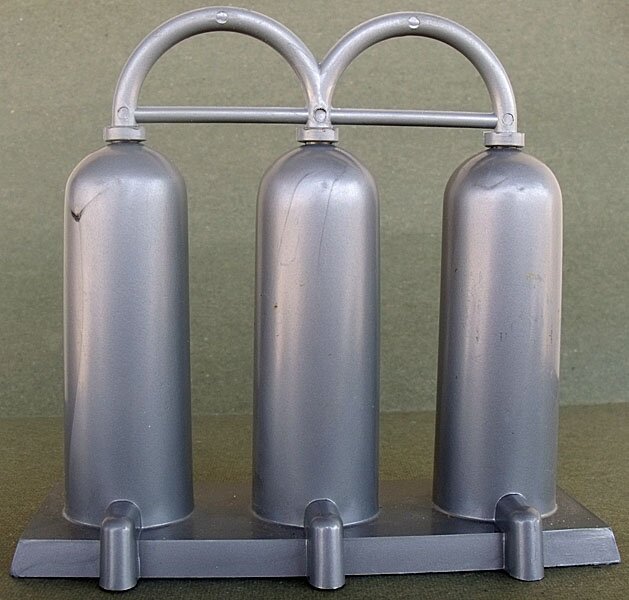 |
| 1. Observatory dome with skylight door (2-piece) |
2. Fuel tank unit (2-piece) |
 |
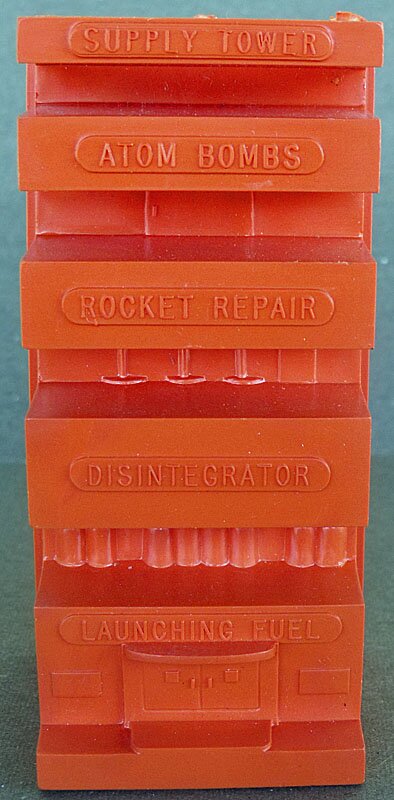 |
| 3. Siren or speaker tower |
4. Tiered supply cabinet |
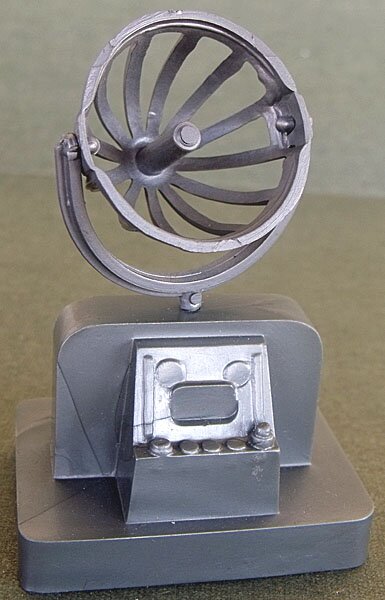 |
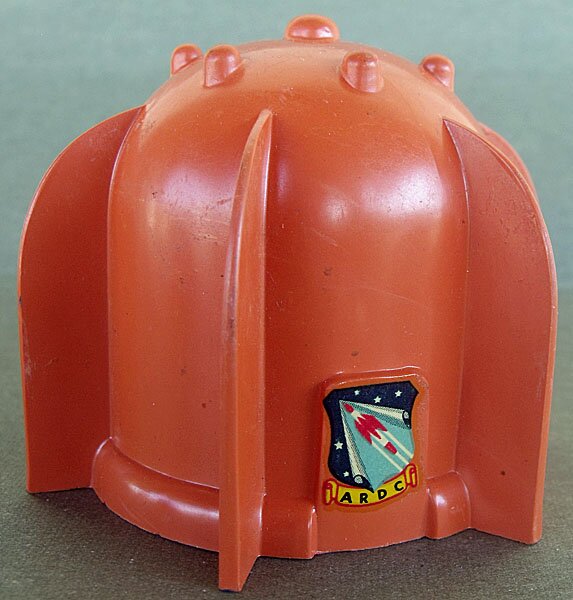 |
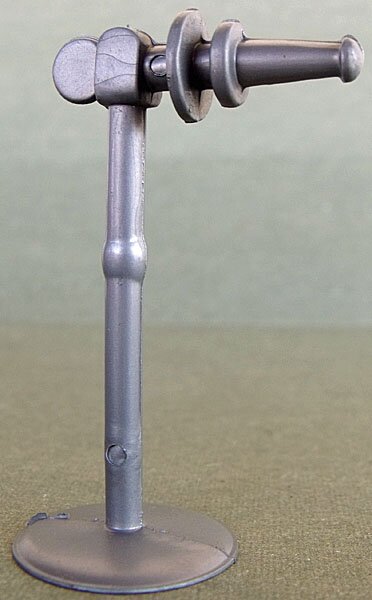 |
| 5. Radar antenna unit (3-piece) | 6. Gravity chamber (Decal is one of many provided with the set) |
7. Laser device on stand |
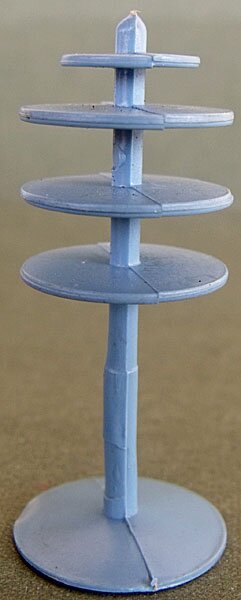 |
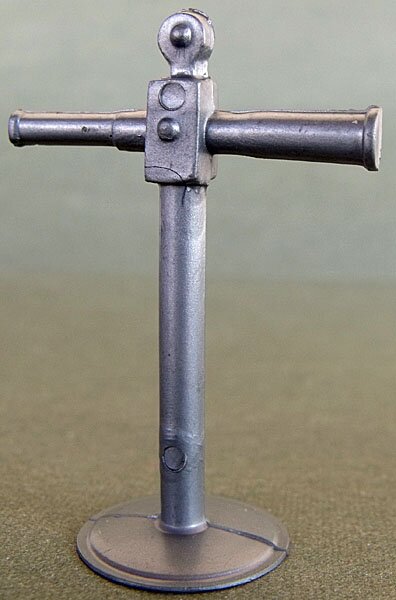 |
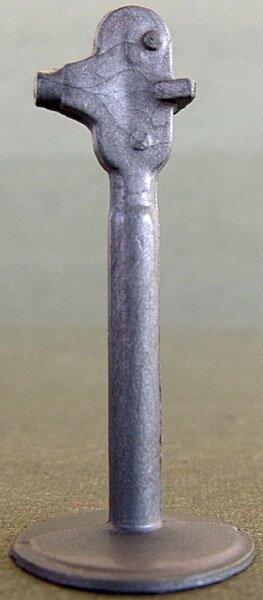 |
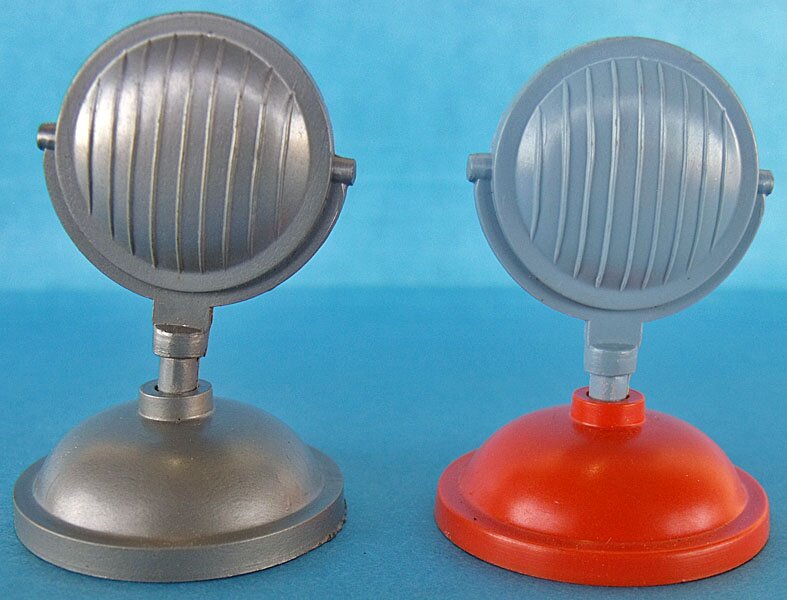 |
| 8. Disc antenna on stand | 9. Telescope on stand |
10. Camera on stand |
11. Search lights on pedestal bases (2-piece) Early silver on left, later light blue/orange on right |
Pom-Pom Gun
It's hard to have a good playset without a cannon to shoot, and the early Marx sets included a 3-barrel, firing cannon. The cannon is about 2-1/2 inches tall as shown in the photos below and 3-3/4 inches long. It was built with a spring-powered mechanism (see photos) that shot shells out of the top barrel, the same as Wild West single-barrel artillery. Despite having three barrels, the space cannon actually fires from only the top one.
Space cannons, which came only with the early sets, were red with a yellow base (or vice versa) and had a sprue of 10 red or yellow shells. In at least one well-known anamoly, Marx' production line ran into a problem with the Wild West cannons and substituted brown or silver space cannons into some Alamo playsets.
My cannon (on right below) shoots the shells about six inches, but I'm sure these things were more powerful than that when new!
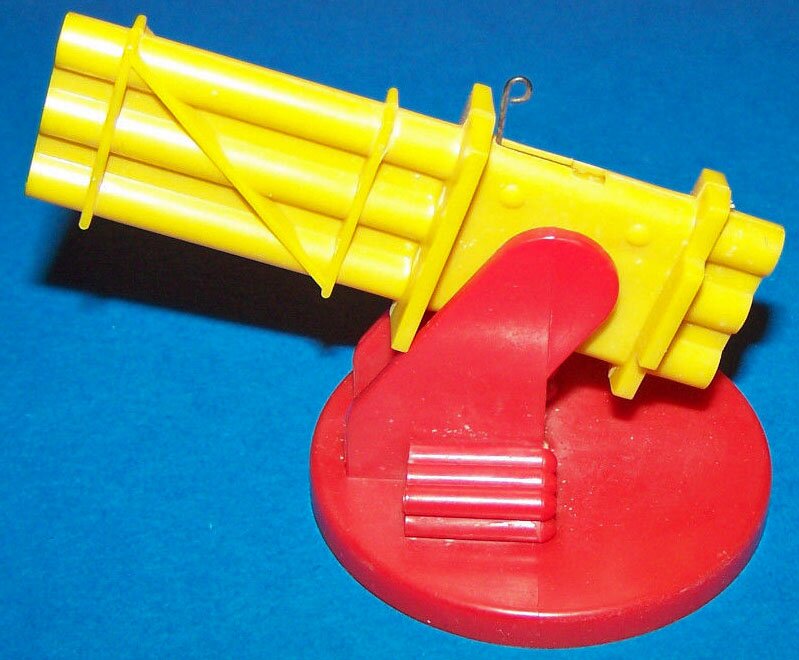 |
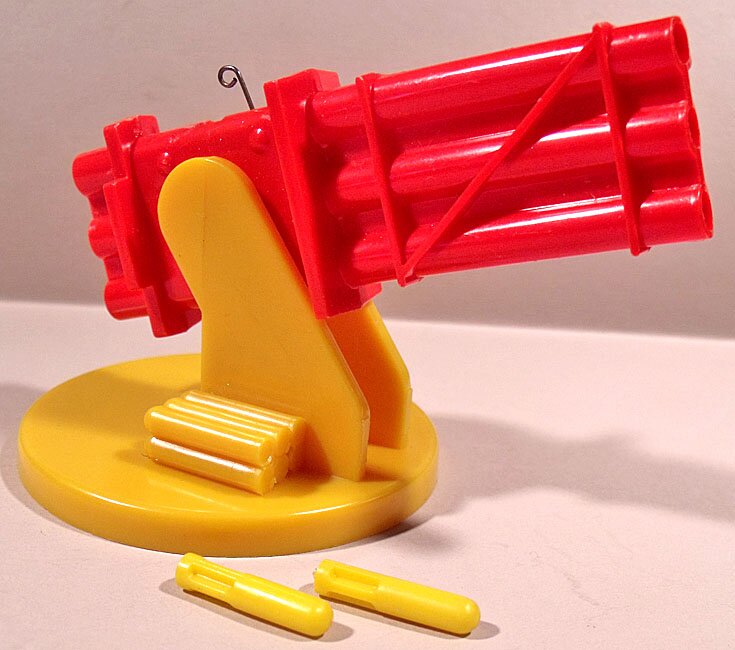 |
| Tom Corbett 3-barrel pom pom gun Photo courtesy of collector Dennis Swing |
Pom pom gun with reverse colors Note shells at bottom of photo |
 |
|
| Shells for pom pom gun |
Rex Mars Accessory Variation - 1952
In 1952 only, the Field Accessory group above was not included in Rex Mars playsets. Instead, the company included three hard plastic silver accessories previously used in military playsets: a search light, a radar, and an anti-aircraft gun. In the military sets, these were mounted onto the back of flat-bed trucks, but for Rex Mars they were presented as stand-alone items. Bases for each of the three pieces are identical (other than tabs used to attach to military vehicles) and the sitting figure in the Tom Corbett figure group (see space figure page) fits perfectly into the seats on the bases.
These are difficult items to find in today's market.
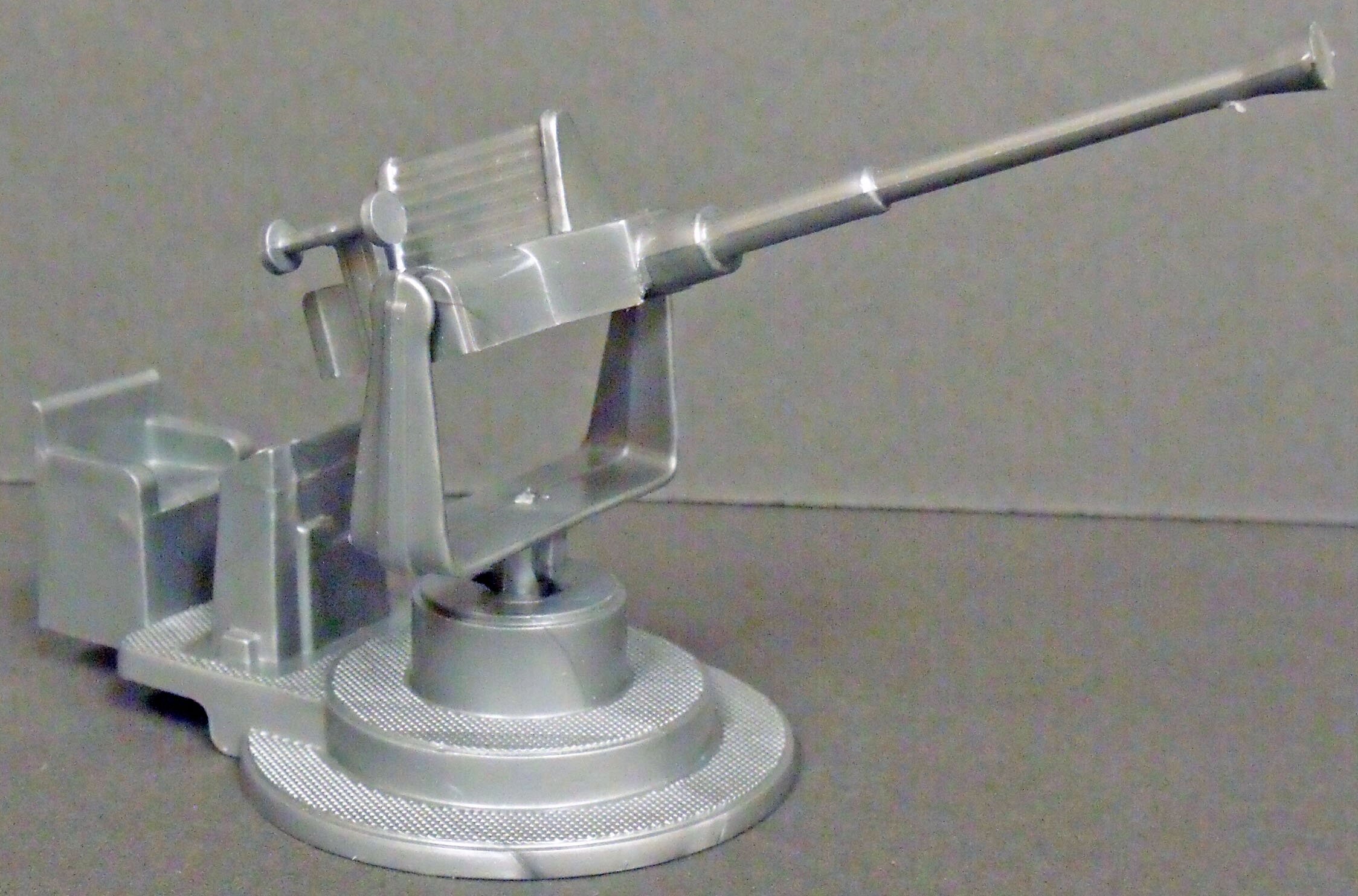 |
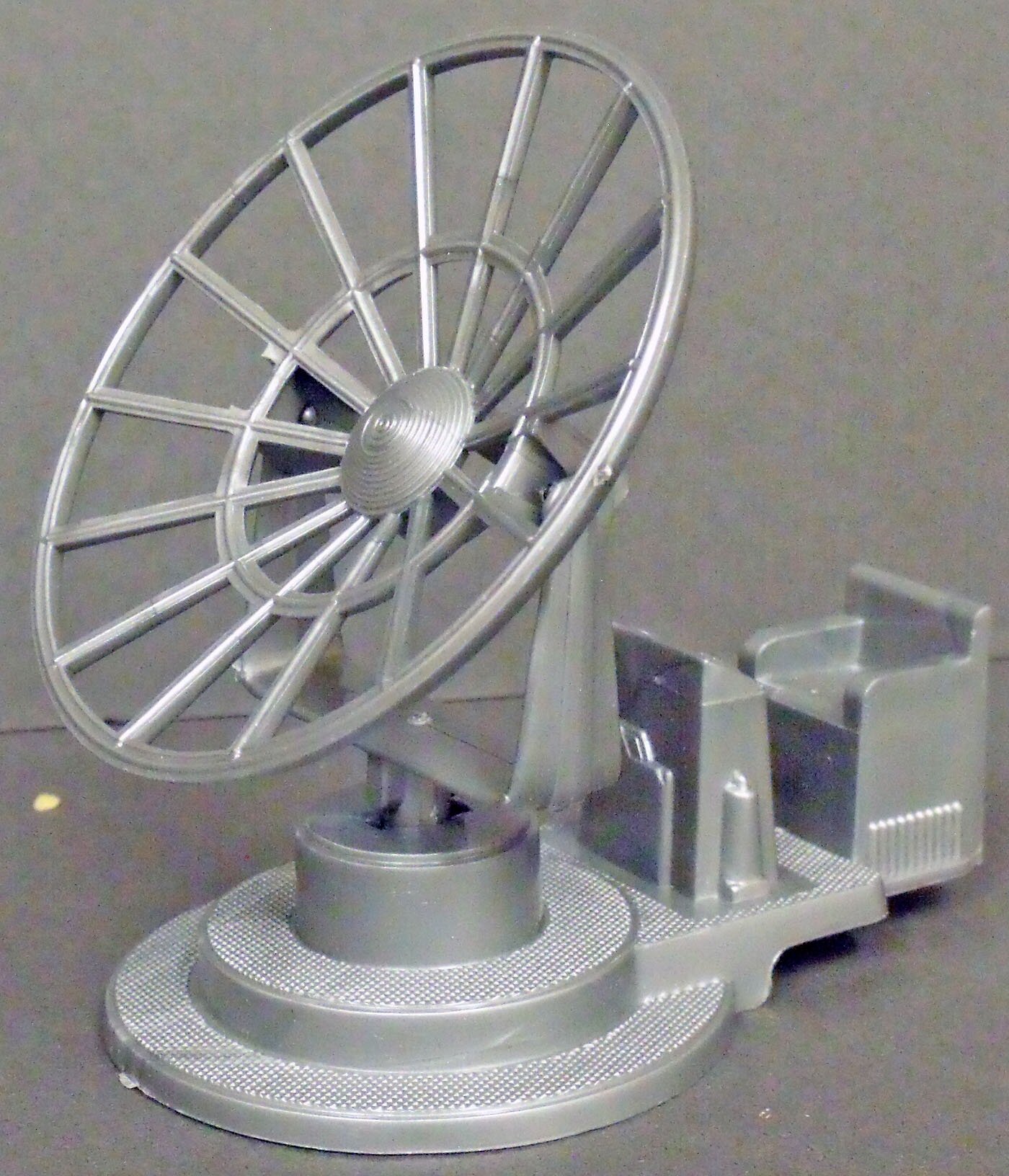 |
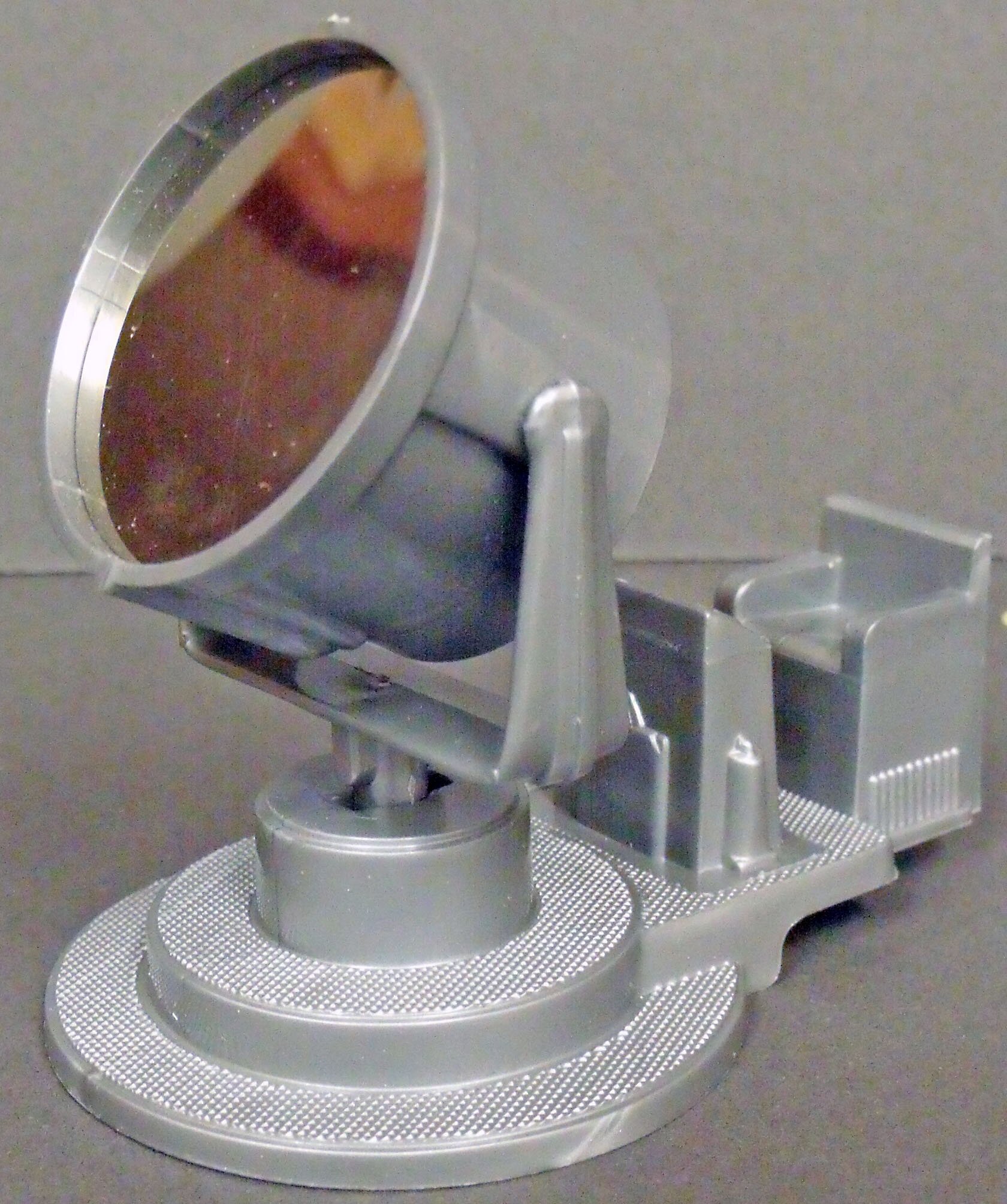 |
| Anti-aircraft gun | Radar | Search light Note original relective paper on lens, usually missing from these items |
| All three photos courtesy of collector David Schafer | ||
Moon Base Field Accessories
For about 10 years, Marx did not create any small space accessories other than those used in its initial space sets. Moon Base playsets -- first sold in 1962 -- included the indoor furniture and the field accessories from the initial Tom Corbett playsets, though in gold and yellow. However, they also added a new group of somewhat strange field accessories, as shown below. I have used the names for these items as shown in PFPC Issue 35, but am uncertain of the actual use for some of these items (I can only assume that they actually exist in the real world).
The magazine article reports that they came in a flourescent red (revised to orange in Issue 49), but PFPC Issue 49 notes that in other playsets these accessories were made in silver (Giant Martin Landing of 1972) and yellow (Galaxy Command of 1979). They can be found rather easily today in all of these colors.
Other than the enlarged code card, items are shown in approximate size to one another, but not to other items on this page. As a reference, the signal blinker and the capsule recovery unit are 3-1/2 inches tall, and the fancy 4-piece disc helical radar antenna (my favorite among the group) is slightly smaller at 3-1/4 inches.
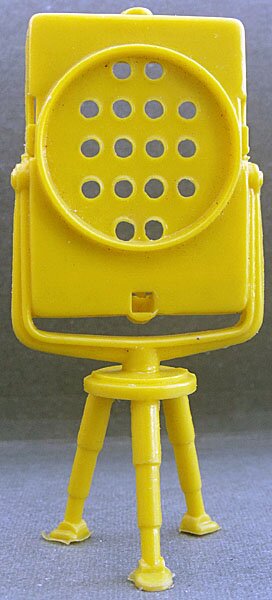 |
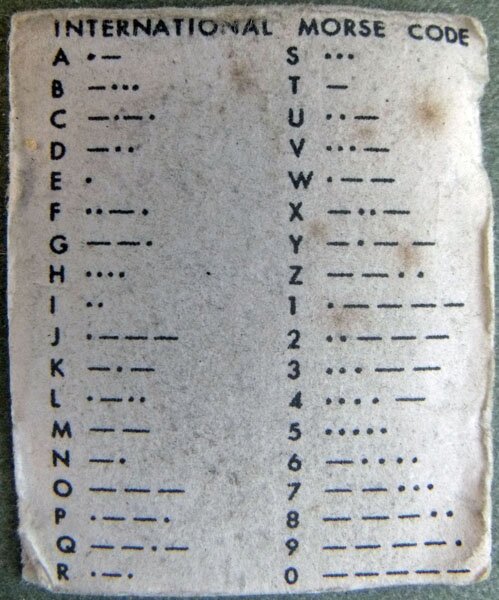 |
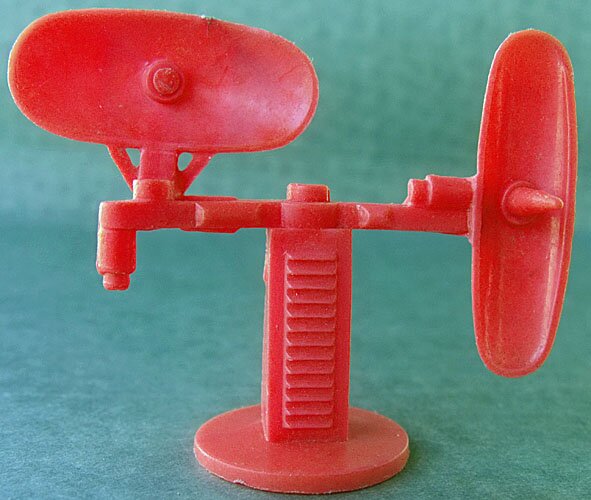 |
| Signal blinker | Code card for blinker (fits into back of the signal blinker) |
Dual directional antenna |
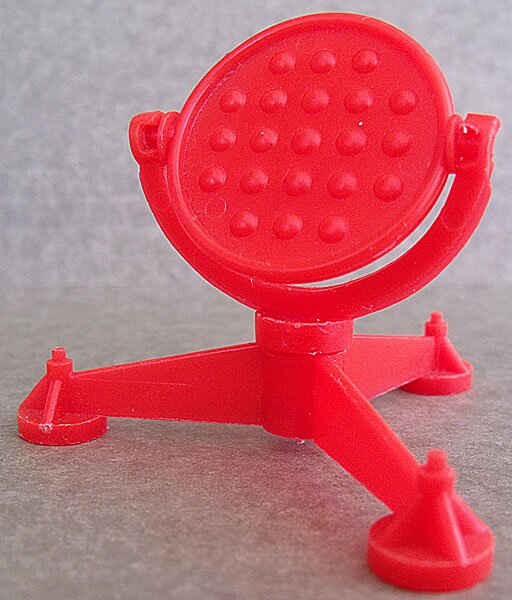 |
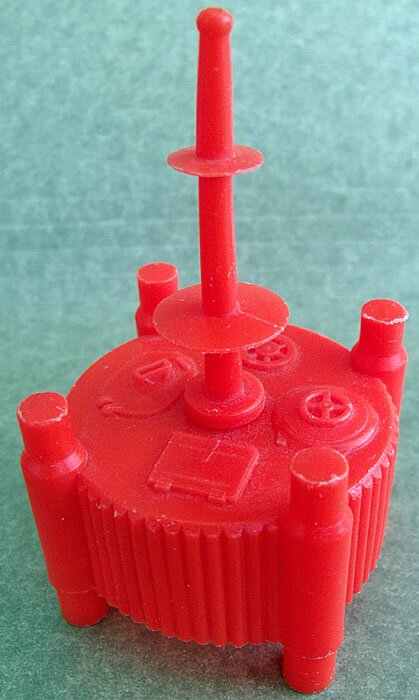 |
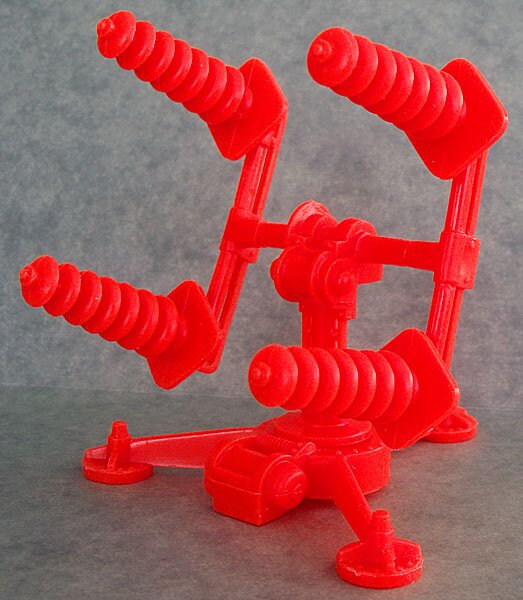 |
| Solar battery | Escape capsule recovery unit | Disc helical radar antenna |
Overhead Illumination
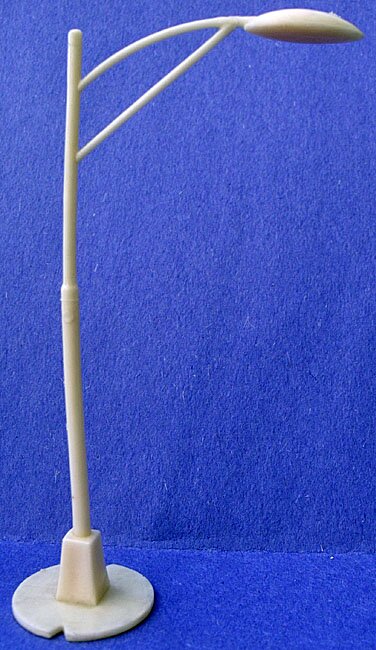 |
The mid-1960s Project Mercury Playset included street lights to illuminate the launching area. The lights had previously been included in the company's airport sets. The lights stand about 4-1/2 inches tall; the one shown is made of soft plastic. I think most of the space theme sets could have a few of these added to them! |

| Rockets and Missiles |
Vertical Rocket Launcher
Early Vertical Rocket Launchers
Marx' first rocket launchers in Tom Corbett, Space Patrol, and Rex Mars playsets were made up of a hard plastic launcher; hard plastic, finned rocket body; and silver, rubber-like nose cone that fit tightly onto the rocket body. The launcher and the rockets were both about four inches tall. The rockets were powered by a spring that fit onto the launcher. Rocket bodies and lanchers were made in blue or red, and they were generally opposite colors in a playset. Both rocket bodies and launchers were made in PL-472.
The "vertical" launchers fired the rockets directly upward, perhaps to avoid damage to mtoher's good dinnerware and father's pipe rack. Forcing the rocket down over the launcher's spring, a twist to the right or left locked the rocket onto the base. Then a slight push on a rocket fin fired the rocket into outer space or the ceiling, whichever came first. About 60 years after being manufactured, my Marx miniatures climb about six feet when fired directly upward.
The rockets in Tom Corbett and similar early sets lacked any decoration and did not represent any specific rocket.
Note that some collectors may use other terms for these launchers and rockets. I have most commonly seen them called "vertical" rocket launchers, but they are sometimes refered to as auxillary rocket launchers or intermediate range missile launchers.
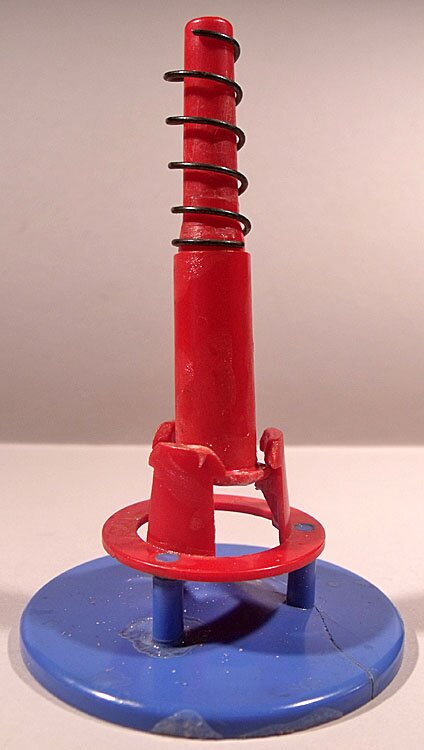 |
 |
|
| Early vertical rocket launcher Damaged, but this is what it looks like |
Early rocket body with fins and separate nose cone |
Early rocket ready to fire |
Later Vertical Rocket Launchers

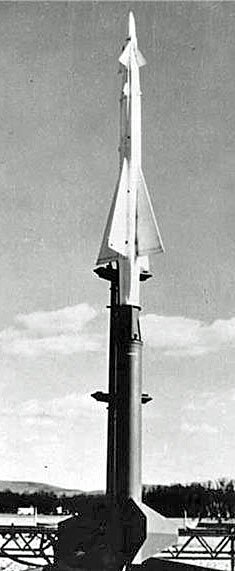 With the introduction of Cape Canaveral sets in the late 1950's, Marx made rockets which often represented actual rockets in the U. S. space program. The initial rockets were fired with "vertical" launchers almost identical to those in the early playsets. They also appeared in later Martian Landing and Moon Base sets. The rockets are 2-stage (i.e., in two pieces), and I have seen them refered to as Vanguard, Jupiter, Nike-Ajax, Atlas, and Thor. Toy soldier expert Tim Geppert presented a brief study of the various rockets included in Marx playsets in PFPC 37, and I have used his information to show and describe them later on this page. I am not knowledgeable of rockets and missiles, so I would welcome information that anyone might care to share.
With the introduction of Cape Canaveral sets in the late 1950's, Marx made rockets which often represented actual rockets in the U. S. space program. The initial rockets were fired with "vertical" launchers almost identical to those in the early playsets. They also appeared in later Martian Landing and Moon Base sets. The rockets are 2-stage (i.e., in two pieces), and I have seen them refered to as Vanguard, Jupiter, Nike-Ajax, Atlas, and Thor. Toy soldier expert Tim Geppert presented a brief study of the various rockets included in Marx playsets in PFPC 37, and I have used his information to show and describe them later on this page. I am not knowledgeable of rockets and missiles, so I would welcome information that anyone might care to share.The Cape Canaveral launchers and rockets generally were molded in hard plastic blue or white. Note that the launcher has short legs on it (see Photo 1 below), while the Tom Corbett launcher did not. In addition, collector Bob Spreitzer has pointed out that there are also two versions of the three pegs between the bottom piece of the rocket launcher and the launcher itself, one with pegs molded onto the bottom piece and small sockets on the rocket launcher for the pegs to fit into (see photo below). A few small details were molded onto the rockets, and plentiful decals were included to help decorate them with appropriate signage.
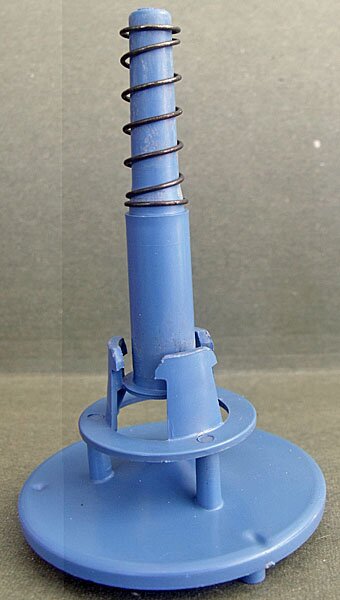 |
 |
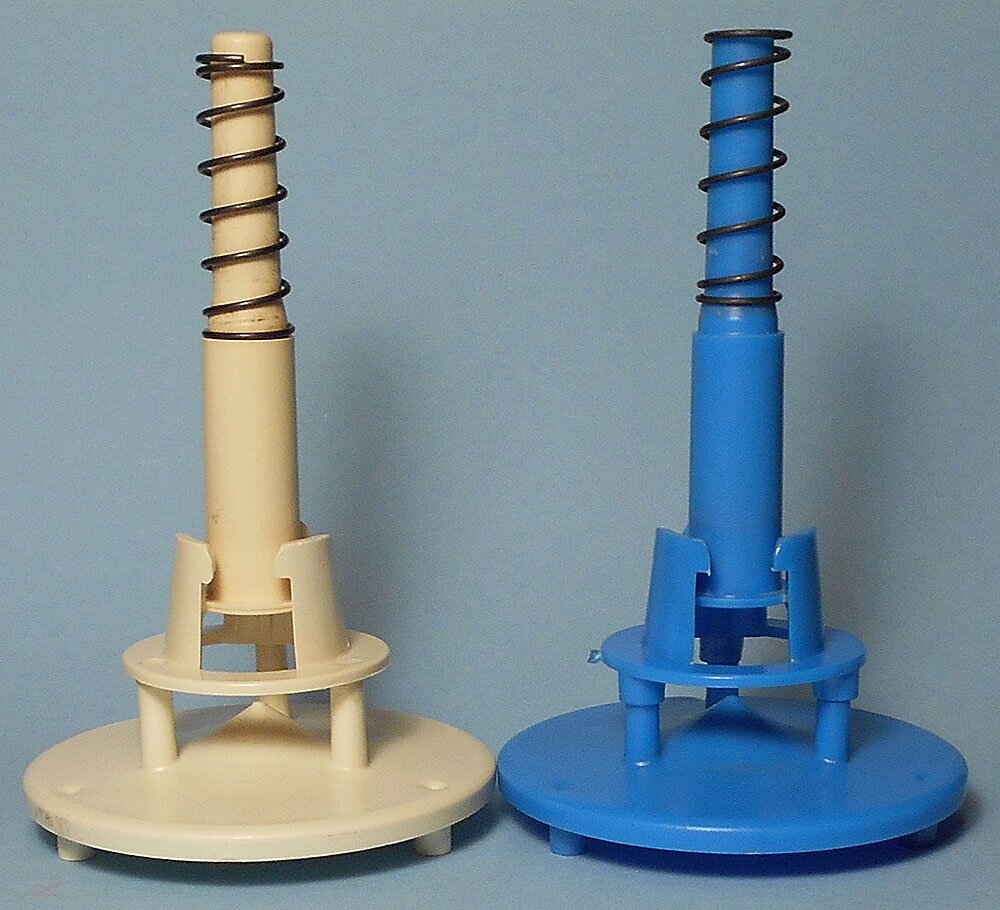 |
| Cape Canaveral vertical rocket launcher (4 inches tall) |
Rocket ready to fire (8 inches tall) |
Rocket launchers with two types of pegs between the bottom piece and the rocket launcher itself. The one on the right has pegs molded onto the bottom piece that fit into pegs molded onto the rocket launcher. Phot courtesy of collector Bob Spreitzer |
Vertical launchers use 2-stage rockets, one stage that sits directly on the launcher and the other that has the nose cap. Within the many space playsets produced by Marx with these vertical launchers, there are five different first stages and six different second stages. The variety of these pieces (as well as similar 4-stage rocket pieces described later in this section) can be rather overwhelming. Or, at least, I know I was overwhelmed by the numerous similar pieces, until I ran into an interesting and humorous article in PFPC Issue 37 written by toy soldier guru Tim Geppert and titled "Vertically Launched, Multi-Stage Rockets I Have Known." Information below is largely from that article...and greatly appreciated!
Each first stage of these 2-stage rockets has three fins and a "male" connector to attach it to the second stage. If you do not know what a "male" connector is, please check with your mothe or anyone who works in construction. Each can fit with any of the six second stage pieces. All are hard plastic and are generally white. However, Tim reports that he has heard of blue (I can verify that, as shown below), green and red ones.
| First Stage of 2-stage rockets | ||||
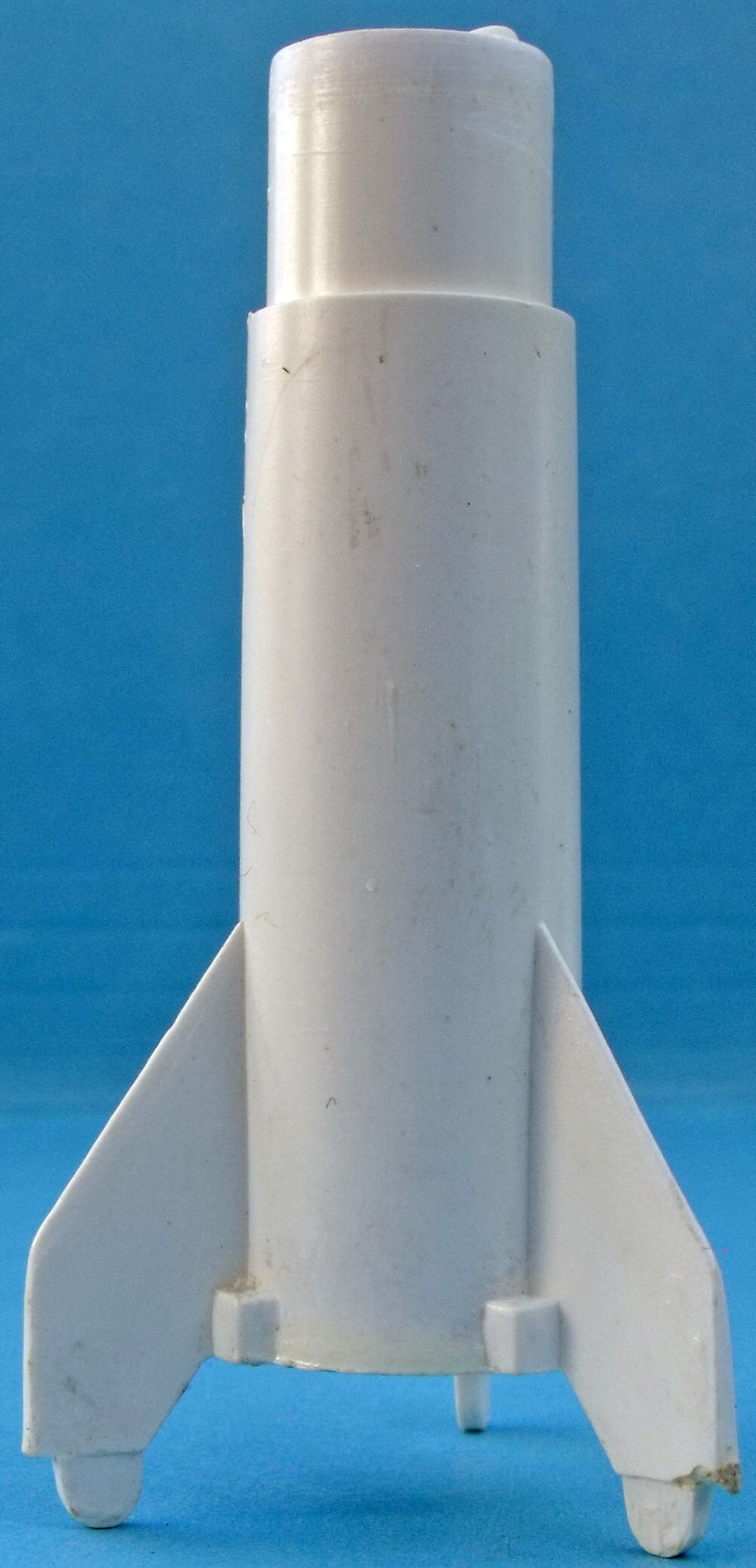 |
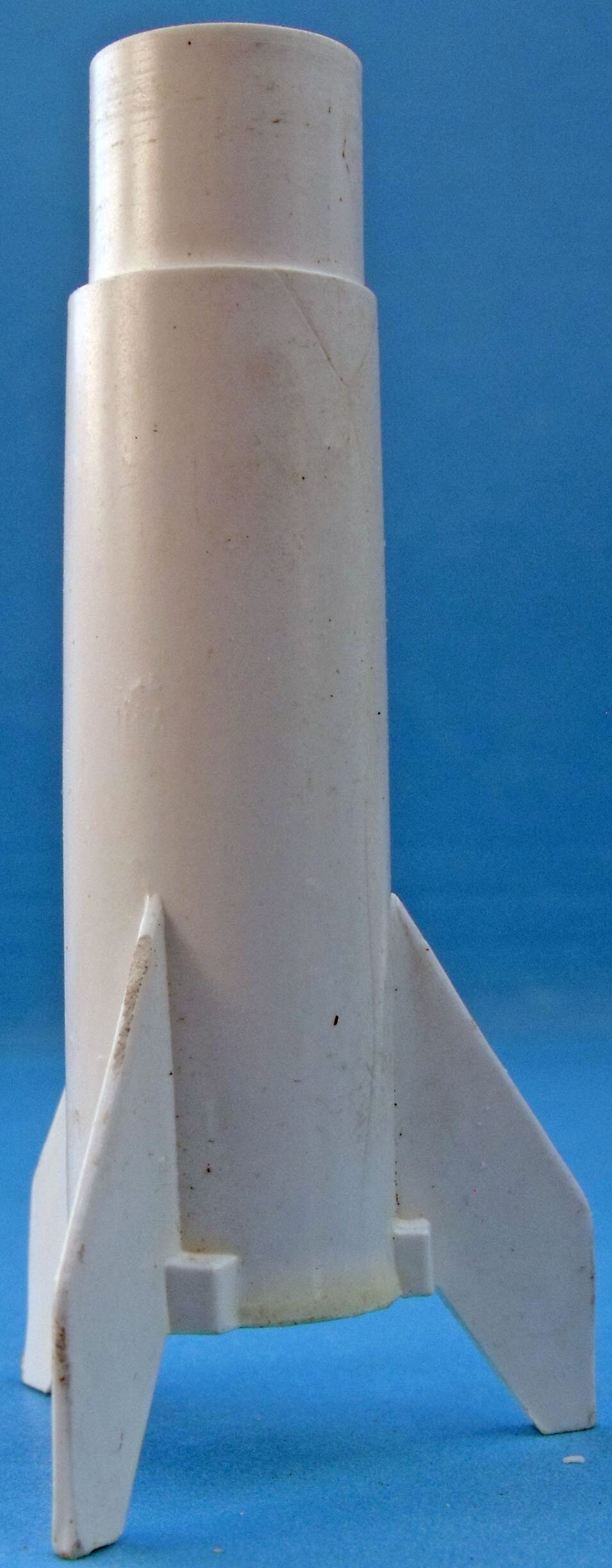 |
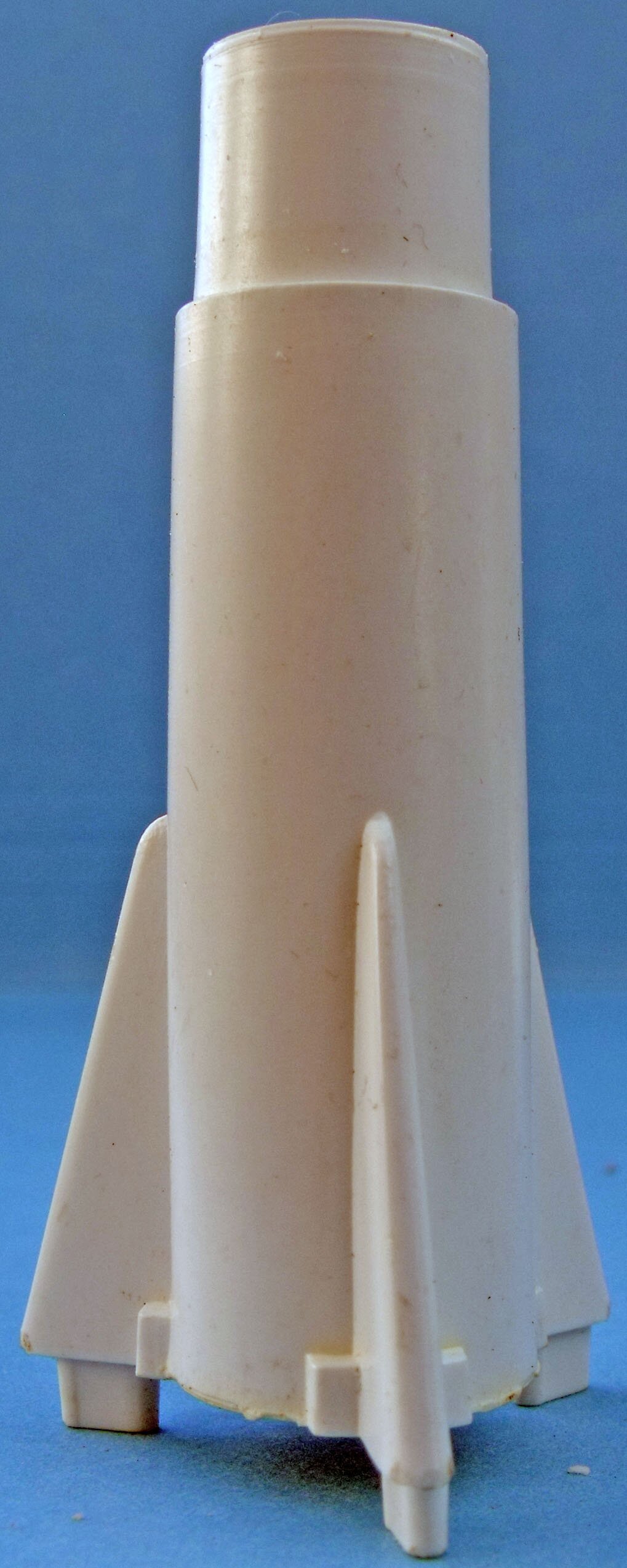 |
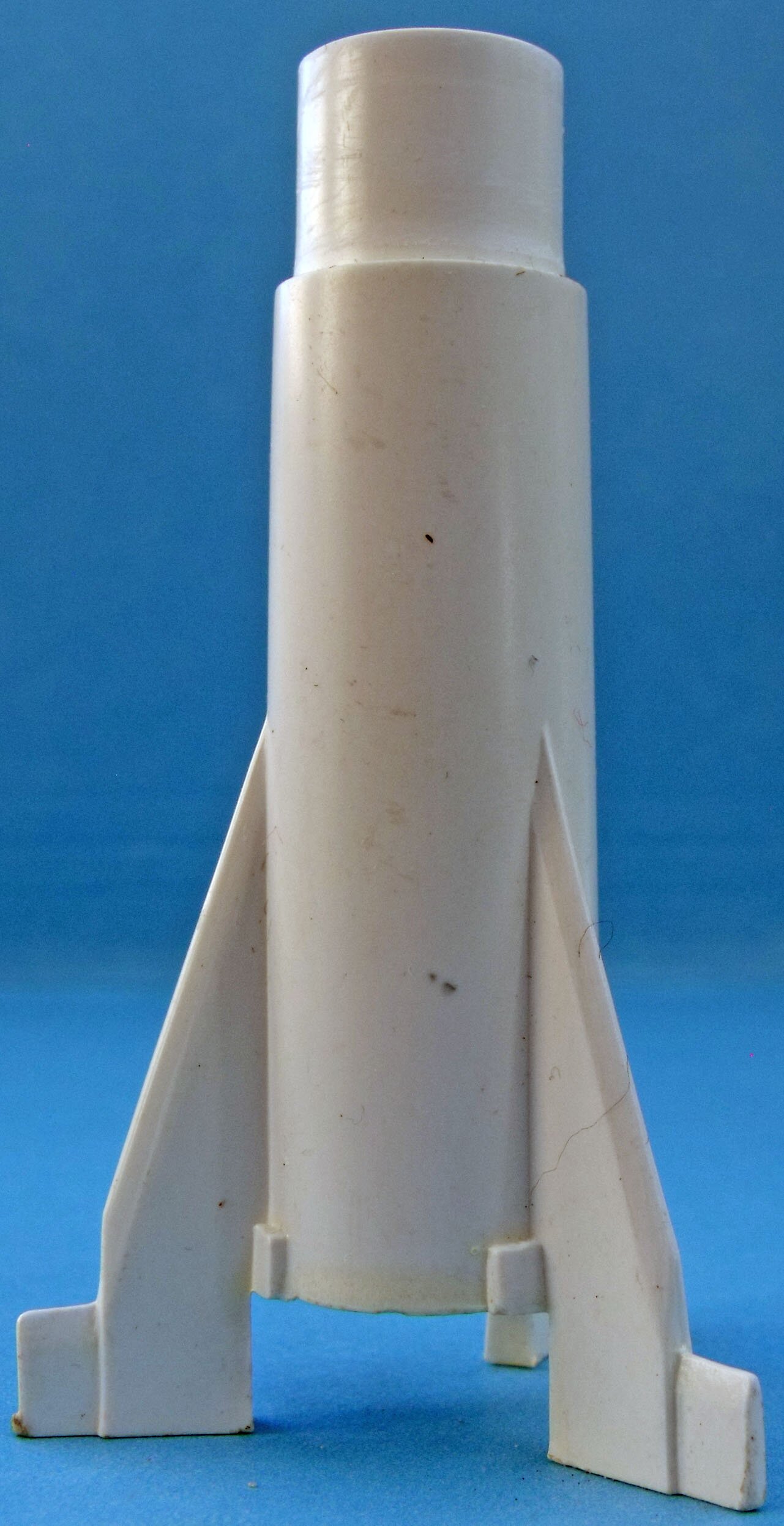 |
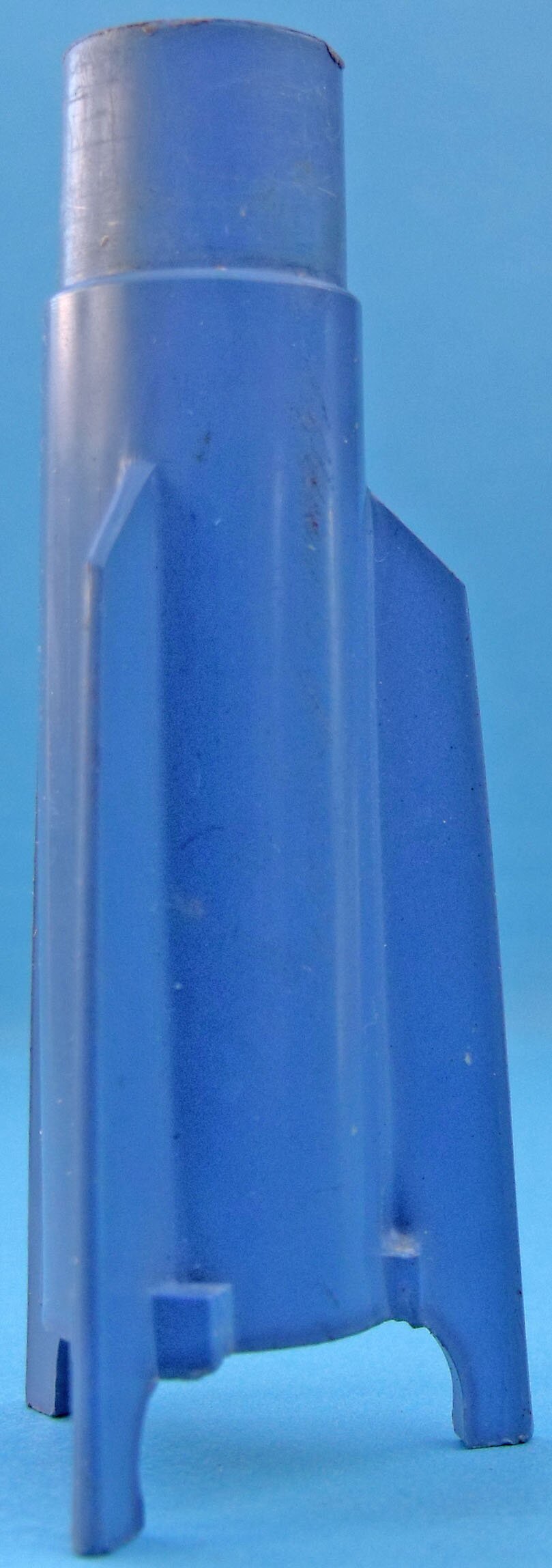 |
| 2-5/8" tall | 2-5/8" tall | 2-1/2" tall | 2-5/8" tall | 2-5/8" tall |
The second stages were made in both hard and soft plastic and in white, silver, and orange. Orange ones are shown from the Galaxy Command section a little further down this page, and based on the first one shown just below, at least a few were made in a transparent plastic. They fit firmly into the first stage piece, apparently not intended to separate when fired.
| Second Stage of 2-stage rockets | |||||
 |
 |
 |
 |
 |
 |
| 4-1/4" tall | 4-1/2" tall | 5-1/8" tall | 4-7/8" tall | 5-1/8" tall | 4-3/4" tall |
BOMARC Missile Launcher
PL-1028 launcher, PL-1029 missile body
Included in numerous space and military playsets, the BOMARC missile is a defensive weapon intended to destroy enemy missiles, with no space exploration use other than to protect the space facility. For Marx, the missile is black, sitting on an attractive orange platform, both made in soft plastic. The platform is in three pieces -- base, turret, and boom -- and the missile is made up of the body and a small nose cone. The launcher is a bit more complicated that most of the company's missiles and rockets, with a boom that can swivel on its base, as well as raise and lower. The base of the missile is about 5 inches on each side; as shown below in the first picture, it stands about 7 inches tall. The missile itself is 6 inches long.
It is the company's only rubber-band powered launcher. Without instructions, figuring out how the launcher fires can be a bit tricky; a playset instruction sheet explains the configuration of the rubber band. A rubber band (I do not have an original one) is connected to a runner on the boom and to one of four hooks on the bottom of the boom. The runner is pushed downward on the boom until it locks into place at the bottom. The rocket is then placed onto the boom, connecting with the top of the runner. A push on the trigger at the back of the turret releases the runner and sends the rocket flying.
I do not know how far the missile originally traveled, but the strongest rubber band I have felt safe in using (without risking damage to the launcher) sends the missile about eight feet when the launcher is set at about a 45 degree angle.
According to Playset Magazine Issue 37, the BOMARC missile was introduced in the 1960s in the company's Atomic Cape Canaveral Playset. It was also used in many military playsets and sold seperately on blister cards.
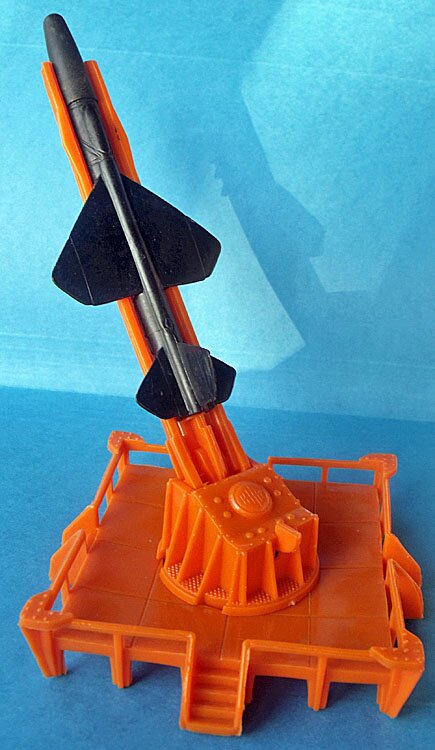 |
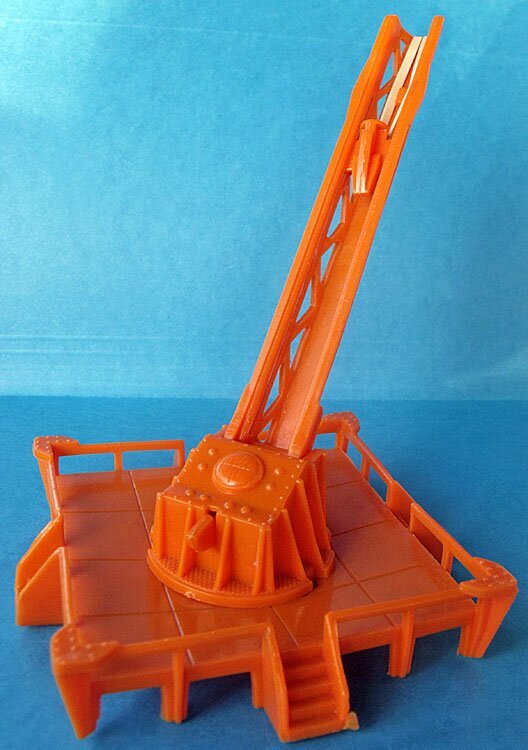 |
| Bomarc missile ready to fire (As shown, about seven inches tall. The base is five inches on each side.) |
Bomarc launcher (Note runner near top of boom, attached to rubber band. These fling the missile forward when the trigger at the back of the turret is pushed. Rubber band is not original.) |
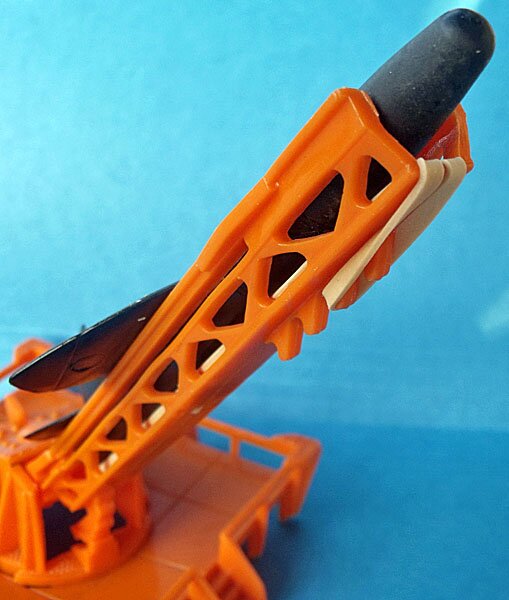 |
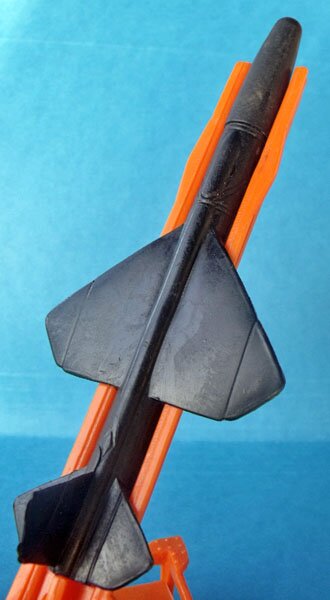 |
| Front of boom with missile ready to fire (Note rubber band stretched from runner to the second of four hooks on the bottom of the boom. Rubber band is not original.) |
BOMARC missile sitting on launcher boom |
Compass-Based Launcher
Another launcher introduced in Cape Canaveral sets was the so-called compass-based launcher. Called a "long-range guided missle launcher with compass" by PFPC Issue 46, it is a huge launcher, with the entire piece standing a little more than a foot tall as shown in the photo below. It is spring operated, and the one that I have can fire the rocket about 25 feet. It was probably quickly exiled to the backyard by many mothers of the 1960's!
When in firing position, what appears to be the bottom stage of the missile is actually fixed onto the launcher, as shown in the photos below. The launcher came in blue or orange, and missiles were white or yellow, with a soft plastic nose cone.
The launcher gets its name from a small, working compass on its base, but the compass is often missing on launchers found today.
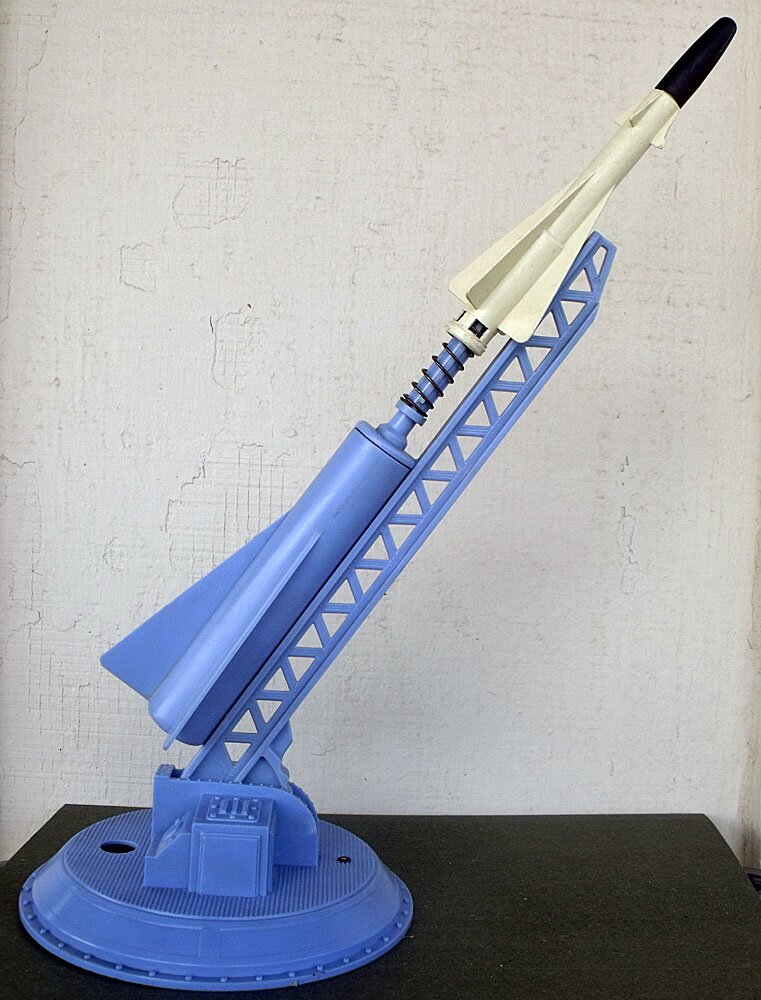 |
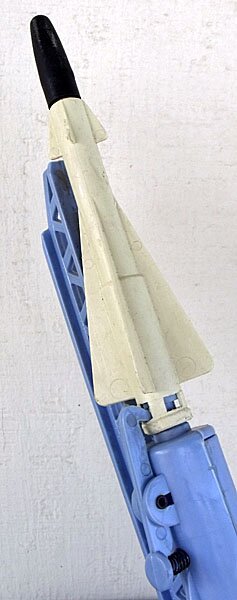 |
| Long range launcher with missile (missing the compass on base) |
Missile ready to fire |
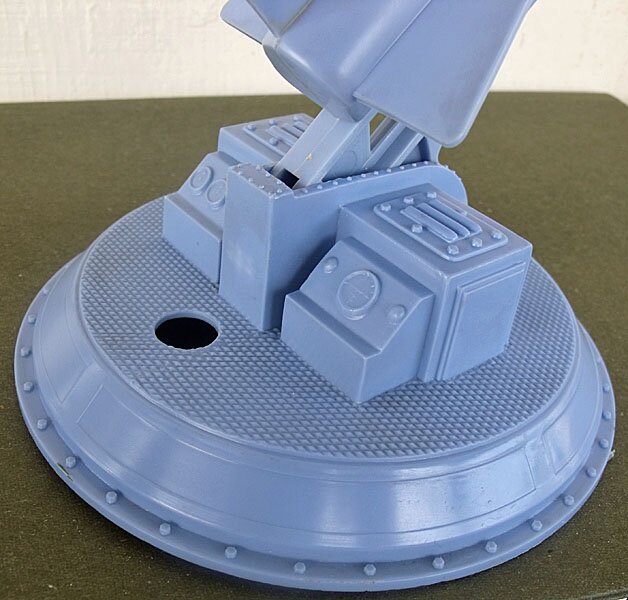 |
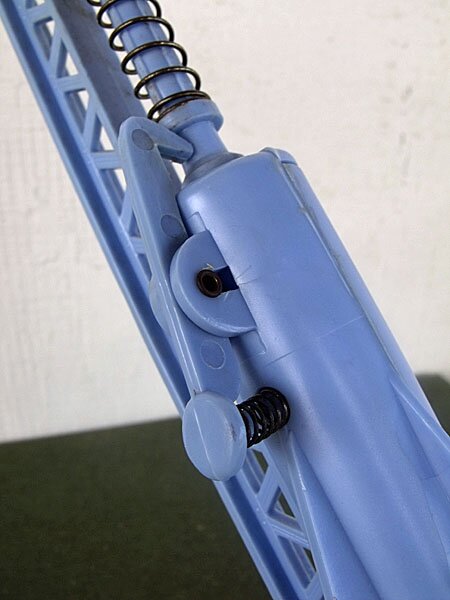 |
 |
| Base of launcher (hole is for missing compass) |
Firing mechanism | Small compass that fits into hole on launcher base Photo courtesy of collector Bob Spreitzer |
Nike Missile Launcher
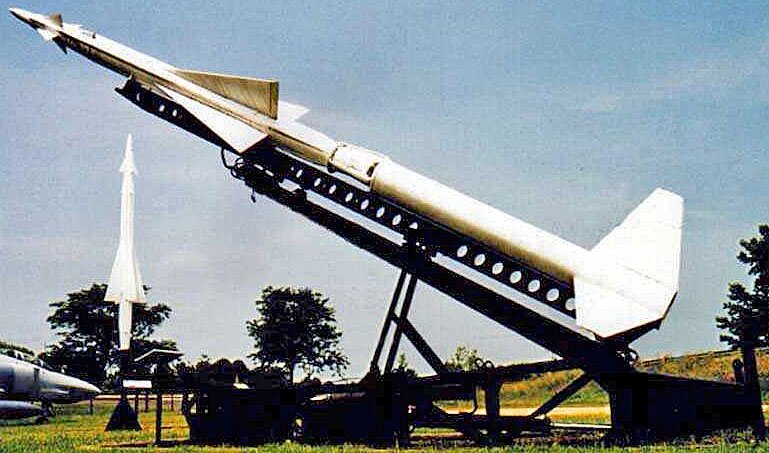 The Nike Missile Launcher, which was a common item in Battleground playsets, is another missile that came in many Cape Canaveral sets. The Nike was the first U. S. ground-to-air missile system, used for defense purposes and not space exploration. The launcher came in silver or orange and was spring-powered. It came with three missiles and has two holes at the rear of the launcher to hold the spare missiles in an upright position. Missiles were red, yellow, blue, or white.
The Nike Missile Launcher, which was a common item in Battleground playsets, is another missile that came in many Cape Canaveral sets. The Nike was the first U. S. ground-to-air missile system, used for defense purposes and not space exploration. The launcher came in silver or orange and was spring-powered. It came with three missiles and has two holes at the rear of the launcher to hold the spare missiles in an upright position. Missiles were red, yellow, blue, or white.According to PFPC Issue 46, the launcher includes a compass in a hole on its base for military playsets, the same as on the compass-based launcher described above. However, the magazine notes that the launcher did not have a compass in space sets. Rick Koch's photo below includes a compass, so the item pictured probably came from a military set. Other than the compass, I know of no difference between the Nikes in military and space sets.
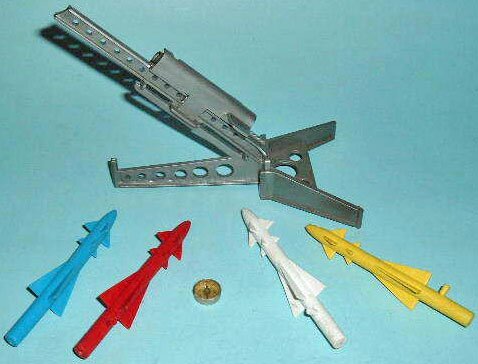 |
| Nike launcher with missiles (Note small compass from large hole on rear of launcher base) Photo courtesy of Rick Koch, Ebay toy-hood |
Rocket Launchers with Gantries
With the advent of Cape Canaveral playsets in 1958, also came more realistic toy space exploration rocket launchers, complete with gantries that rolled up to service tall rockets, then moved back to allow for take-off. Though nicely made and attractive, the Marx gantries were grossly undersized due to the huge size of the actual gantries and the expense of making and packaging the toys. Despite that, they were cool as heck!
Platform Rocket Launcher with Gantry (4-stage rockets)
The first of these had three platforms that crewmen used to reach the rocket, initially a 3-stage rocket and later a revised 4-stage rocket. With a crane-like projection at their tops, these launchers were made in white or off-white hard plastic and stood about 8-1/4 inches tall. Each stage of the rockets was a separate piece, made in white hard plastic. The 4-stage rocket had two tops that could be used, a satellite and a closed container that I assume carried a payload of whatever your imagination could dream up.
As noted earlier on this page, a small Marx cereal premium set in the late 1950s -- Cape Cheerios Rocket Base -- had a similar gantry, but its base had a mechanism that allowed the rocket to be tilted away from the gantry, all the way down to a horizontal position. This version of the platform gantry is not included in any other set, but the tilting ability is similar to the Atlas Rocket Launcher described next. PFPC surmises that the premium may have been a market test prior to Marx releasing its Cape Canaveral playsets. Rockets used in these launchers are described a little further down on this page.
 |
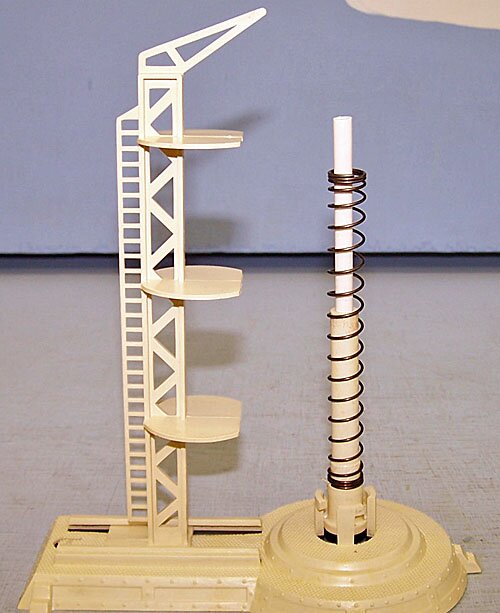 |
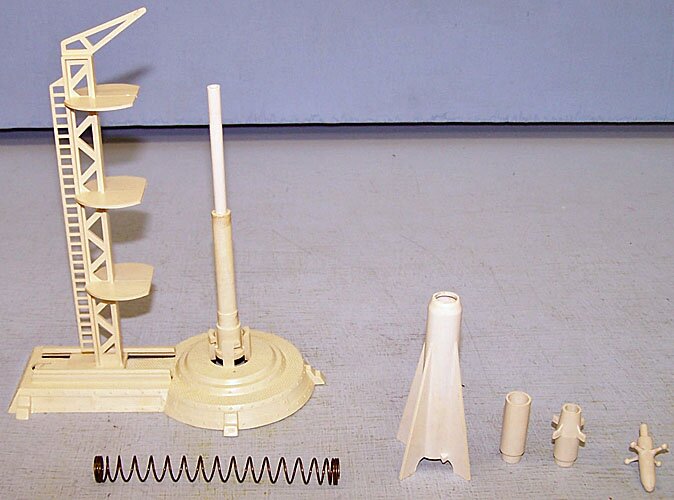 |
| Platform launcher with 4-stage missile ready to launch | Platform launcher with firing spring in place | Components of platform launcher and 4-stage missile |
| (PL-1004 and -1004A) | (PL-1004 and -1004A) | |
| Photos courtesy of Dan, Ebay marxy1950 | ||
As with 2-stage rockets for vertical launchers described previously, the variety of 4-stage rocket pieces totally overwhelmed me, until I ran into an article in PFPC Issue 37 written by toy soldier guru Tim Geppert titled "Vertically Launched, Multi-Stage Rockets I Have Known." Information below is largely from that article.Each of the four first stages of The first stage of each 4-stage rocket has four fins and a "female" connector to attach it to the second stage. The one exception is the fourth one pictured below; in the PFPC article Tim has drawn it without the peg on top, and I have no idea why the one I have has a peg. Any thoughts?
Tim states that these are generally white, but he has seen the first one pictured below in a dark orange (with its other three stages being the same color). The pieces of 4-stage rockets fit together so loosely that one might assume they actually do not go together, which is another reason why it is a headache to sort out all these rocket pieces. Tim theorizes that Marx intended this loose fit, allowing the four stages to go their separate ways when fired.
| First Stage of 4-stage rockets | |||
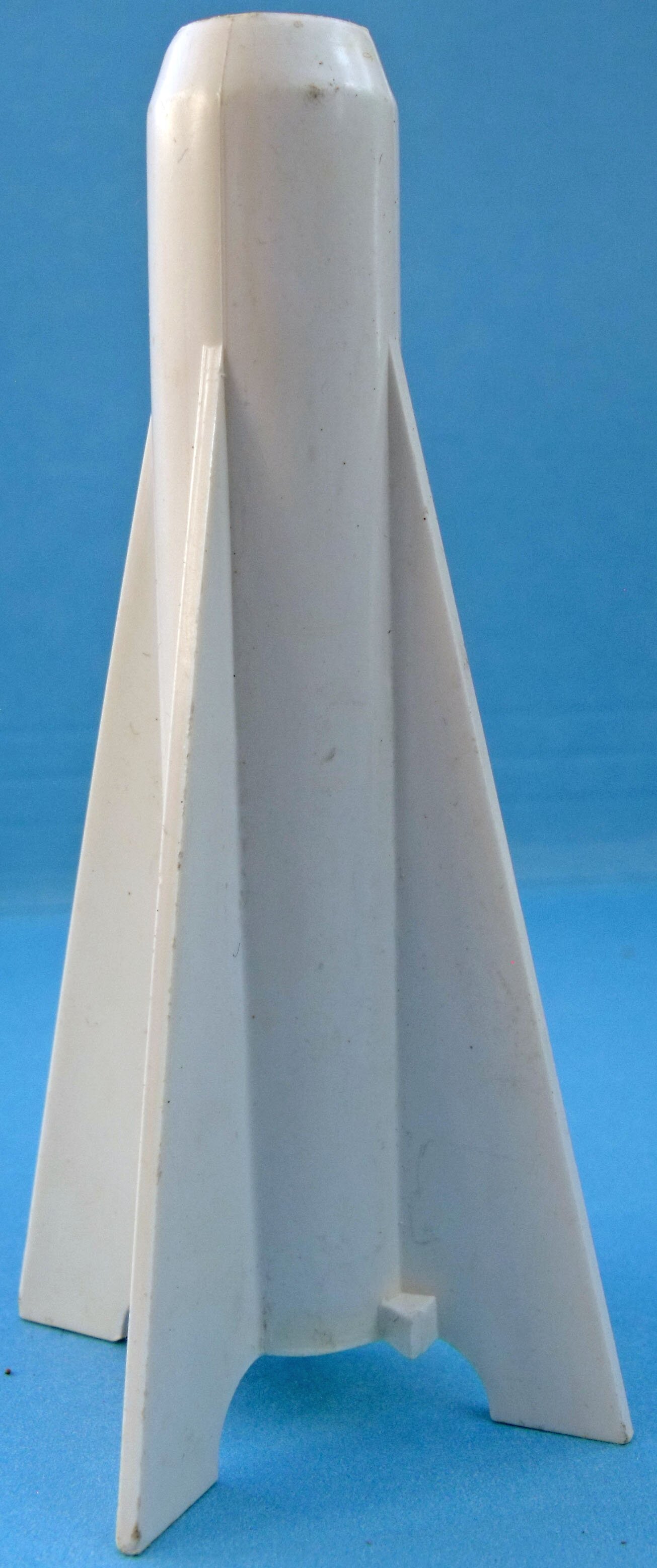 |
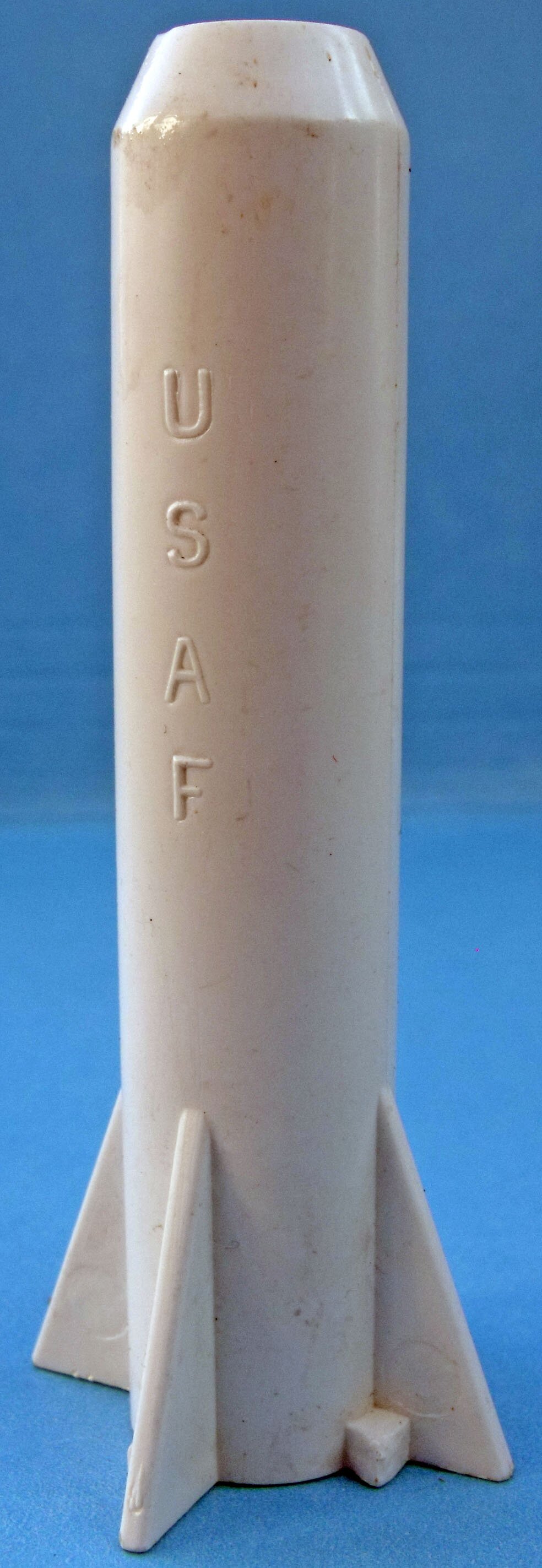 |
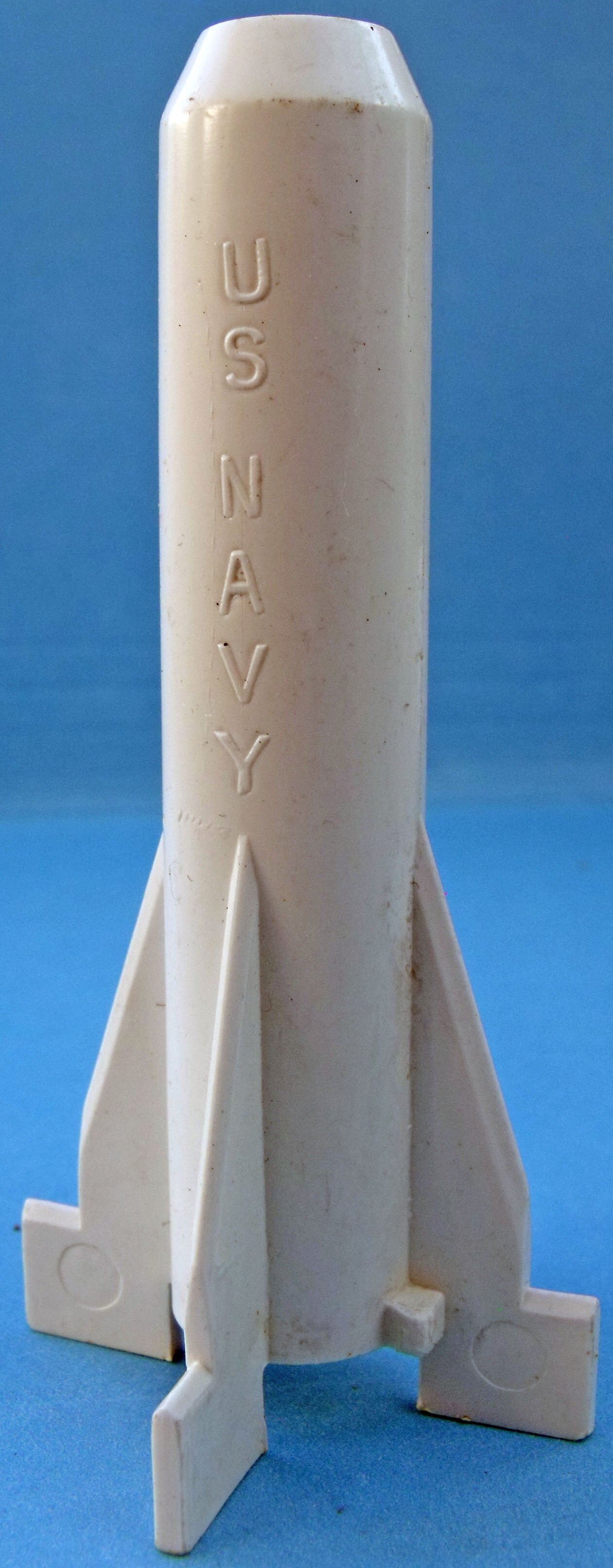 |
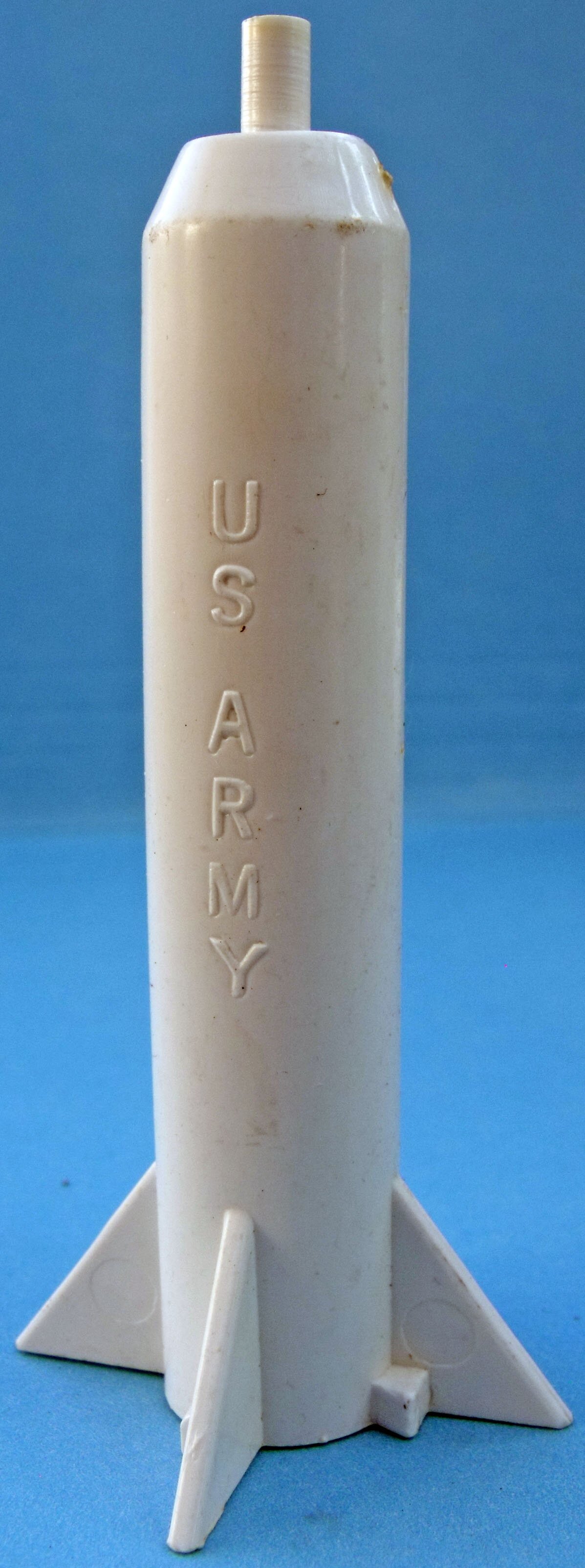 |
| 3-1/2" tall, not marked | 3" tall, marked USAF | 3-1/4" tall, marked U.S. Navy | 3-3/8" tall, marked U.S. Army |
Tim's article states that when pictured (in Marx literature, I assume), the first first-stage piece above uses this piece as its third stage, with the usual third stage piece as its second stage. Yes, it's all a bit complex!
| Second Stage of 4-stage rockets |
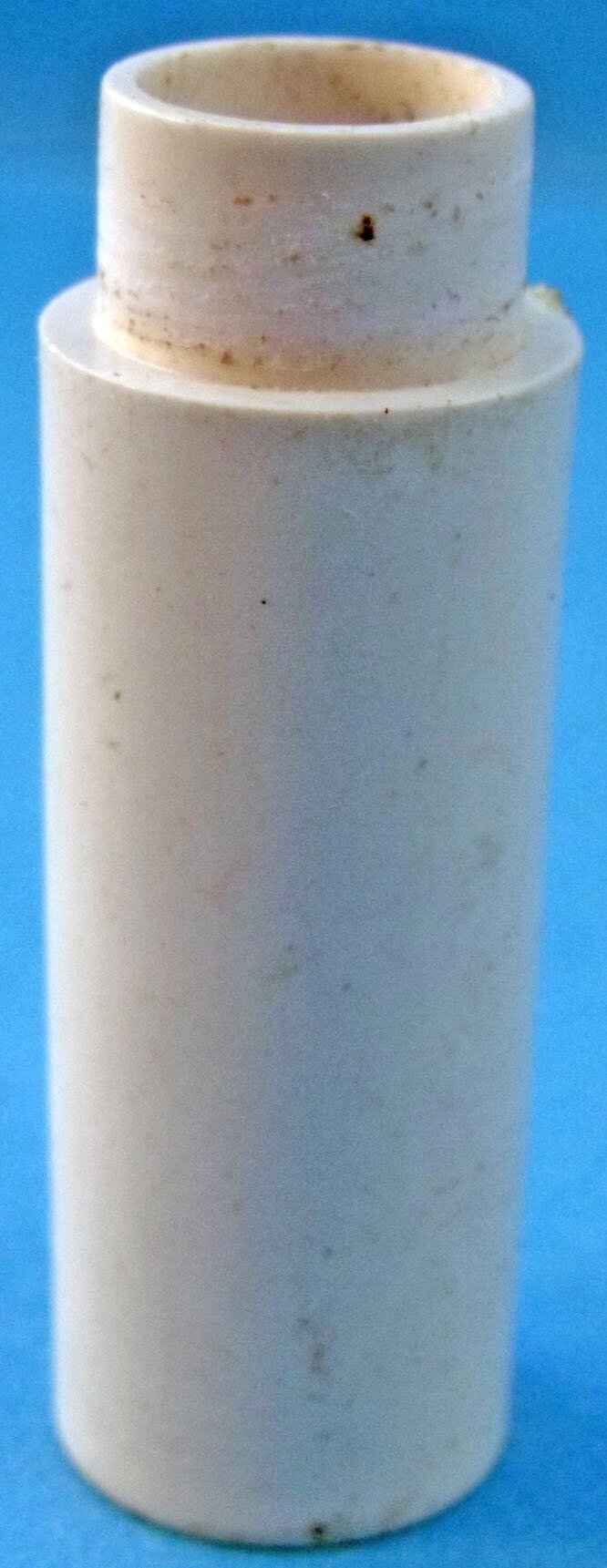 |
| 1-3/8" tall |
All third stage pieces have four fins.
| Third Stage of 4-stage rockets | |||
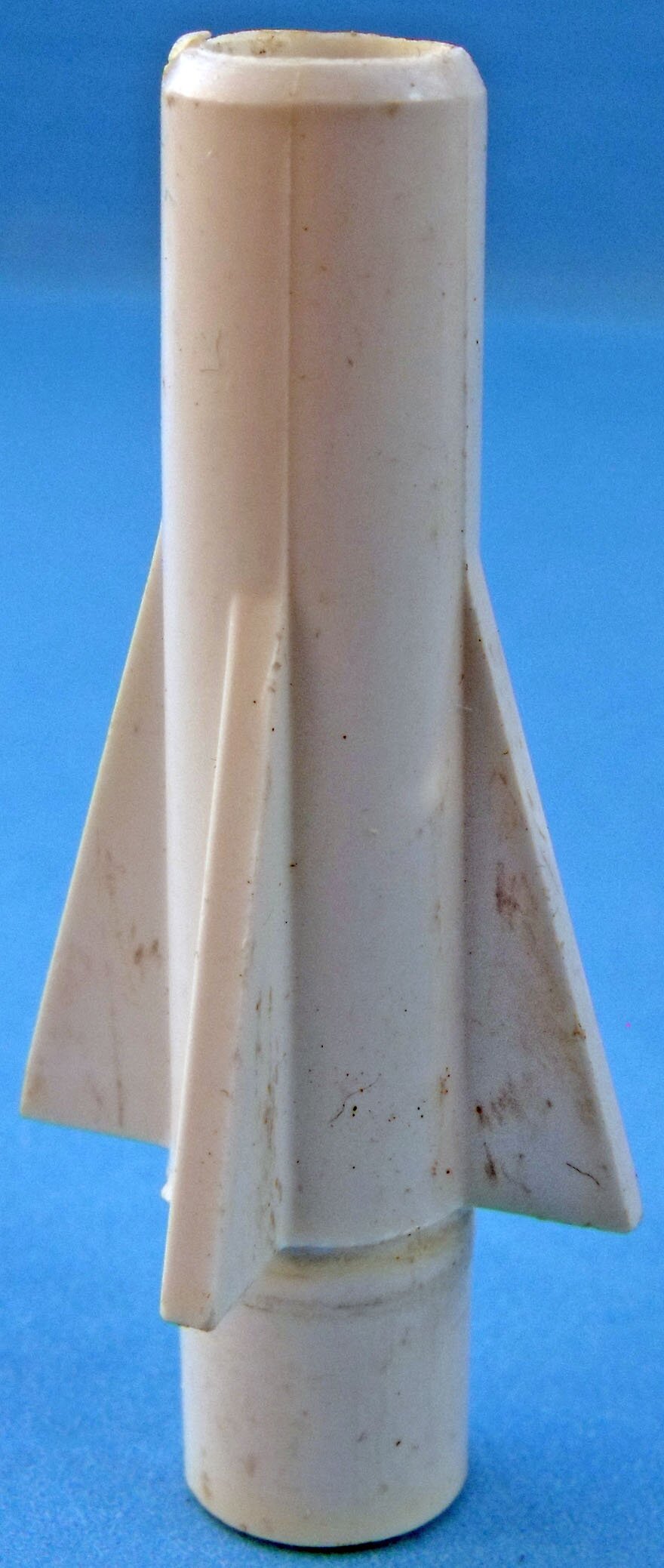 |
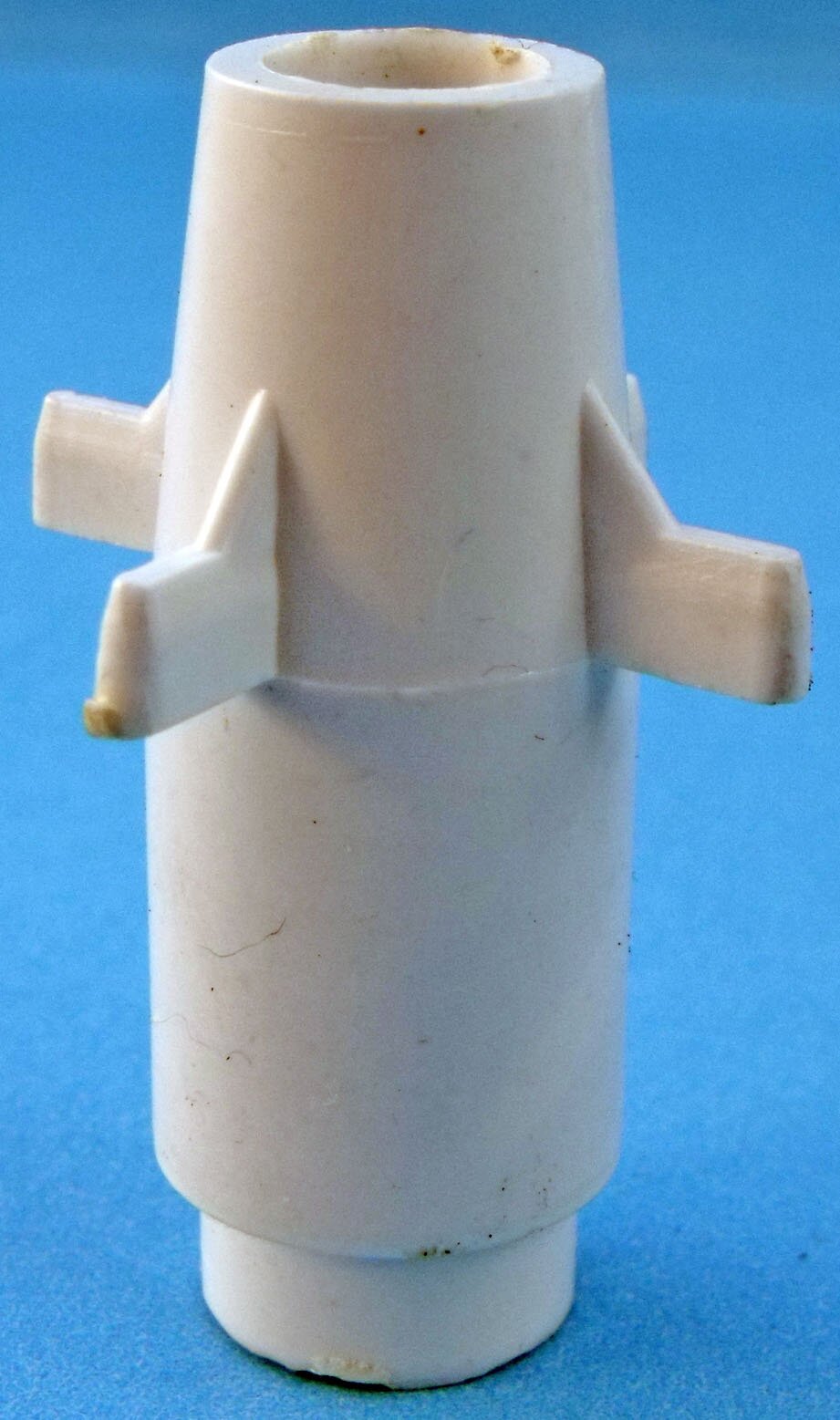 |
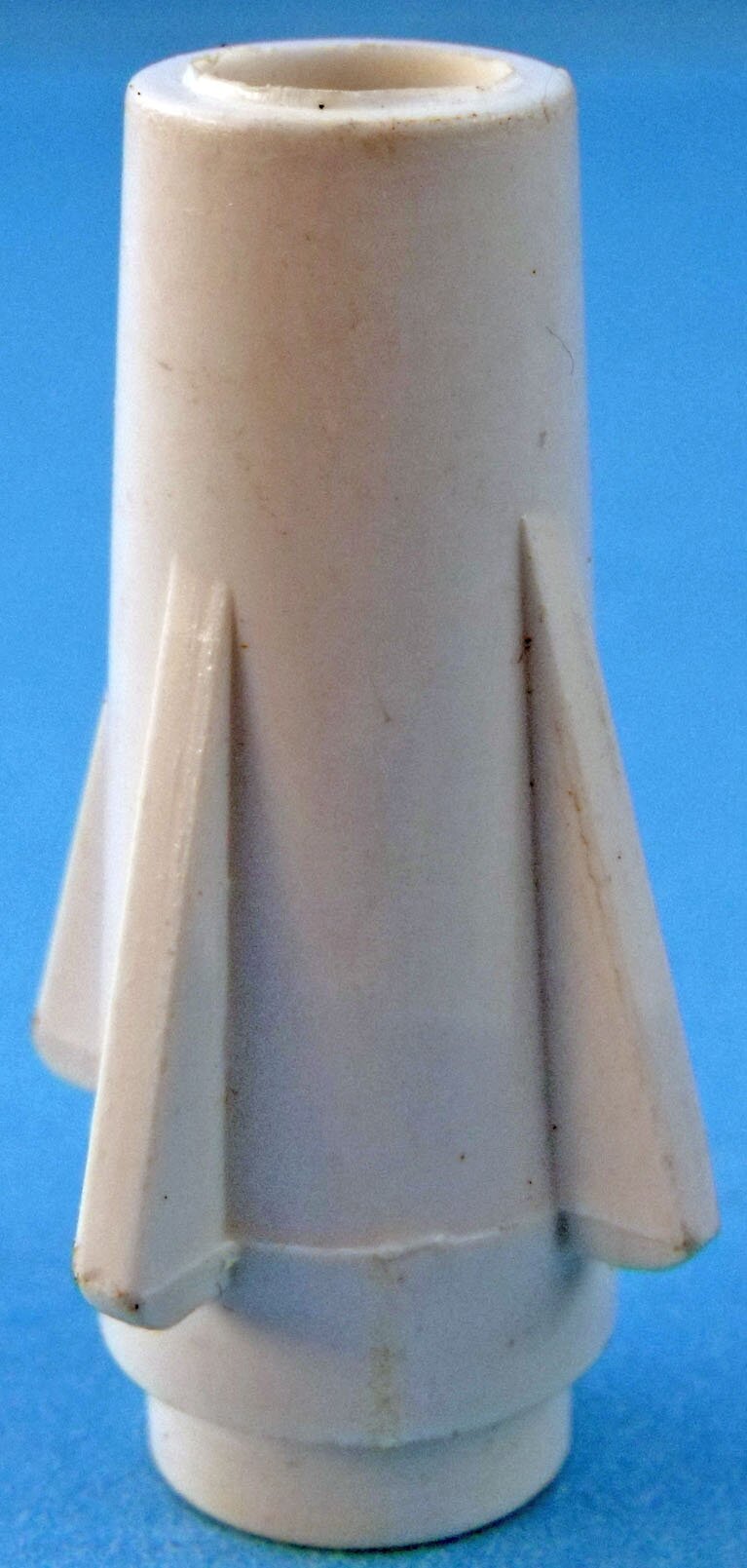 |
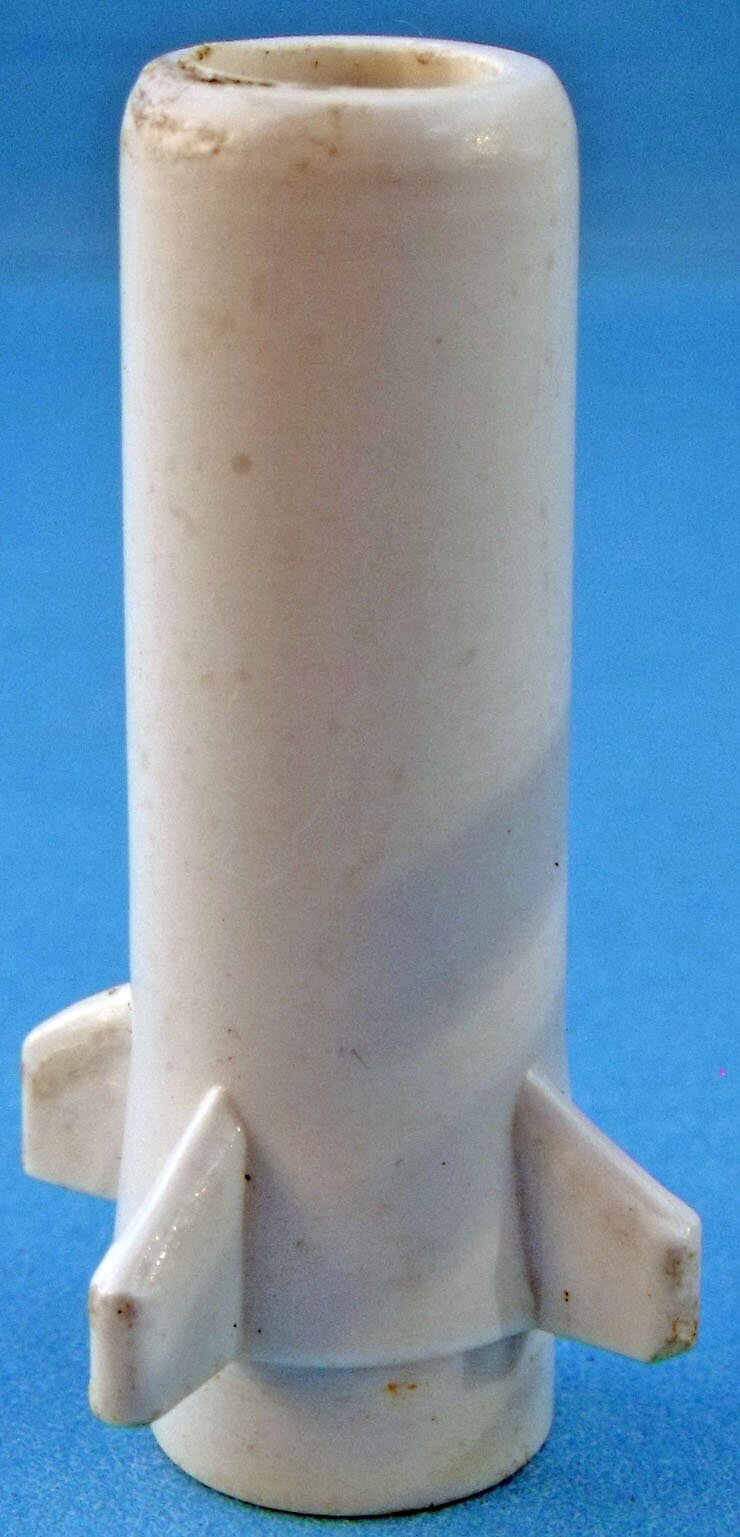 |
| 1-5/8" tall | 1-1/4" tall | 1-1/4" tall | 1-1/4" tall |
| All third stage pieces have four fins. | |||
Being hard plastic and the smallest piece of the rocket, the fourth stages -- the rocket noses -- were the pieces most often lost or broken. Which is probably why they are the most difficult pieces to find today. There are four different versions.
| Fourth Stage of 4-stage rockets | |||
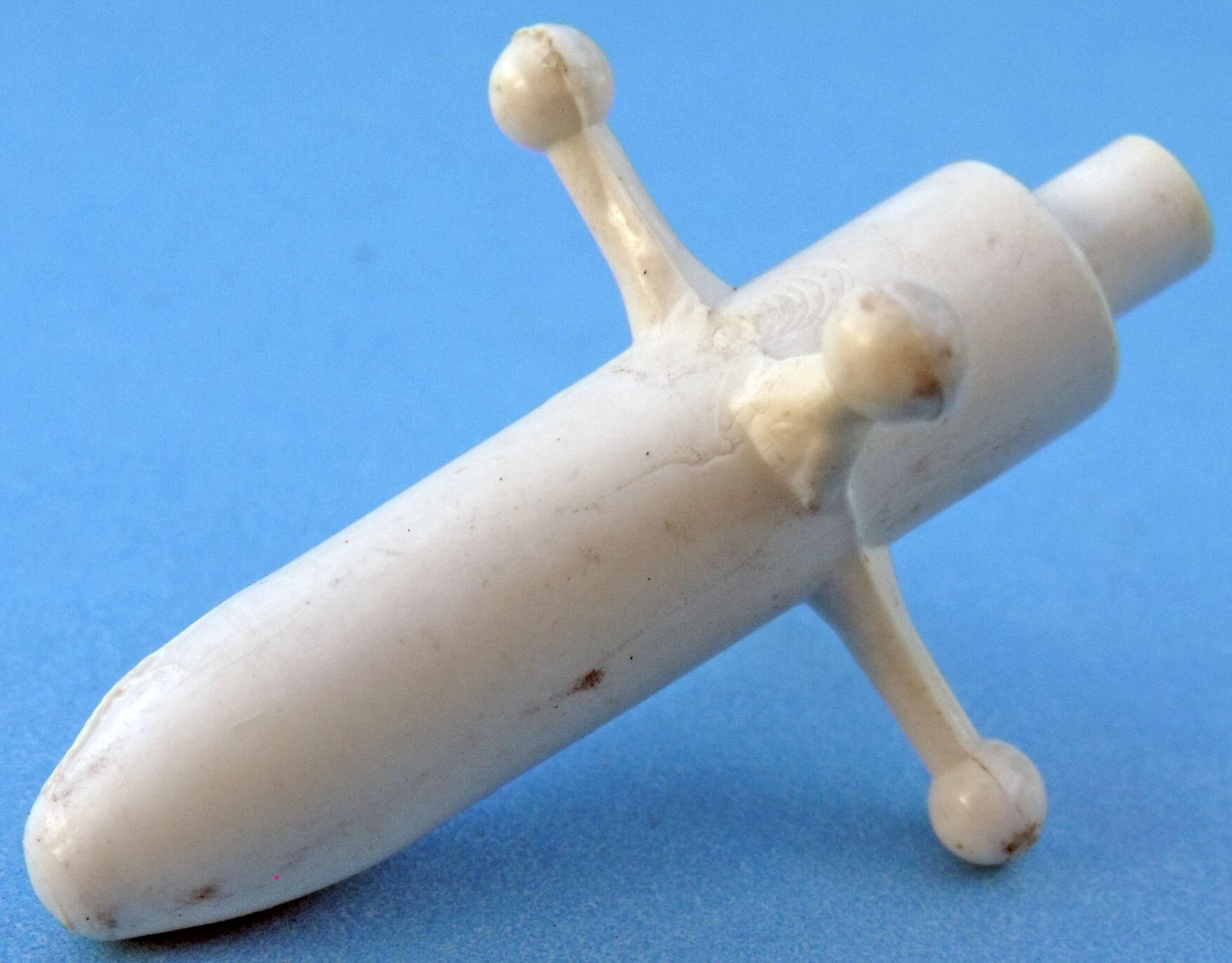 |
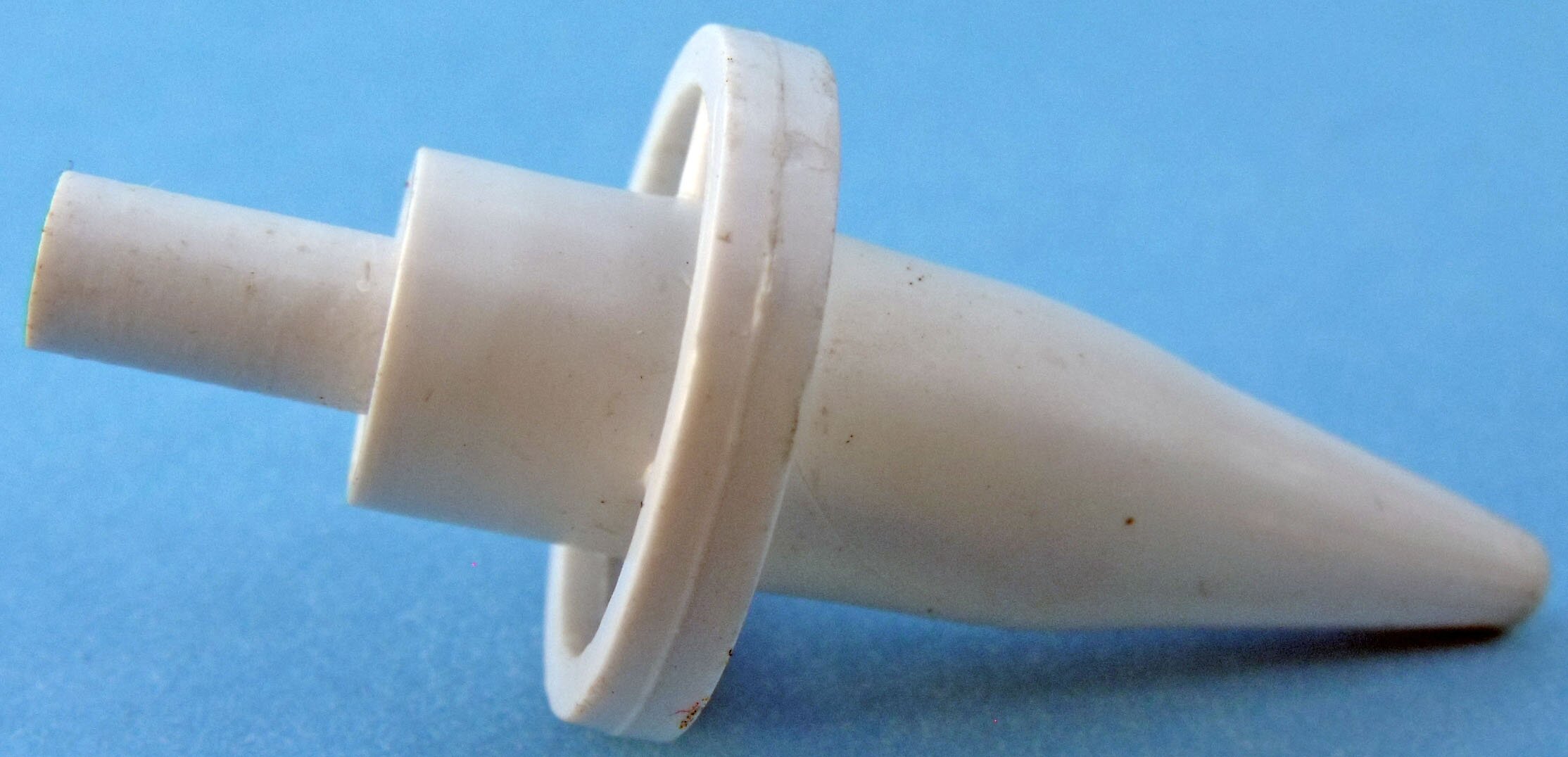 |
 |
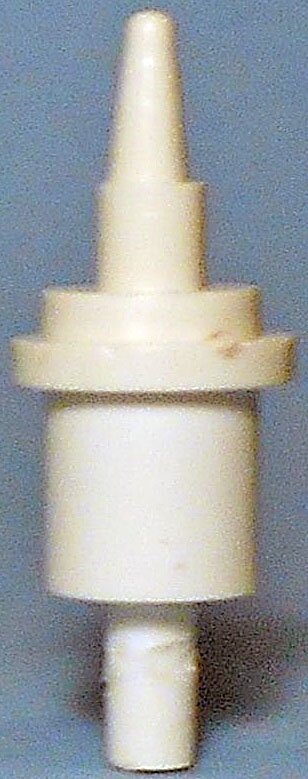 |
| 1-1/4" tall | 1-1/2" tall | Two photos above courtesy of collector Bob Spreitzer | |
Please remember that you will be tested on this subject matter at the next OTSN!
Atlas Rocket Launcher with Gantry
PL-1101, PL-950 nose cones
 In 1961, Marx introduced a second, much-improved rocket launcher with gantry to fire new, realistic Altas rockets. The first set to have this item was the Sears Deluxe Cape Canaveral Playset (#4536). The launcher stands about 9 inches high, a bit taller than the platform gantry launcher.
In 1961, Marx introduced a second, much-improved rocket launcher with gantry to fire new, realistic Altas rockets. The first set to have this item was the Sears Deluxe Cape Canaveral Playset (#4536). The launcher stands about 9 inches high, a bit taller than the platform gantry launcher. Similar to the Cape Cheerios launcher, the base included a tilting mechanism, which allowed the rocket to be loaded directly onto the launcher horizontally by truck (see the section on vehicles later on this page) and then tilted upright to its firing position. The gantry can move on the base to enclose the rocket for servicing, then move back for firing. The entire piece is in white plastic with a black rocket nose cone similar to those for the early vertical launcher.
| Second photo below is courtesy of veteran seller and collector Kent Sprecher. All other photos are courtesy of collector Bob Spreitzer. | ||
 |
Marx's Atlas rocket is in three pieces: rubber nose cone plus top and bottom pieces, divided at the middle line seen in the top photo at left. Unlike other Marx rockets, the Atlas has no locking tabs for firing, because the spring housing that it sits on has these tabs, as shown below. | |
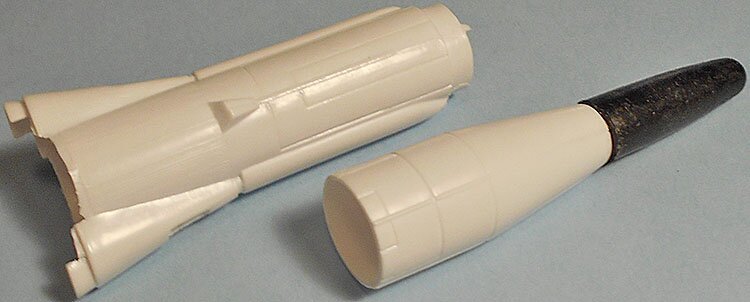 |
||
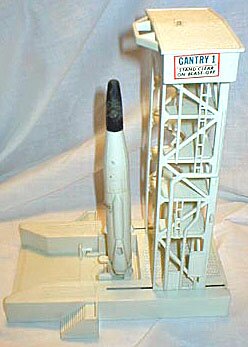 |
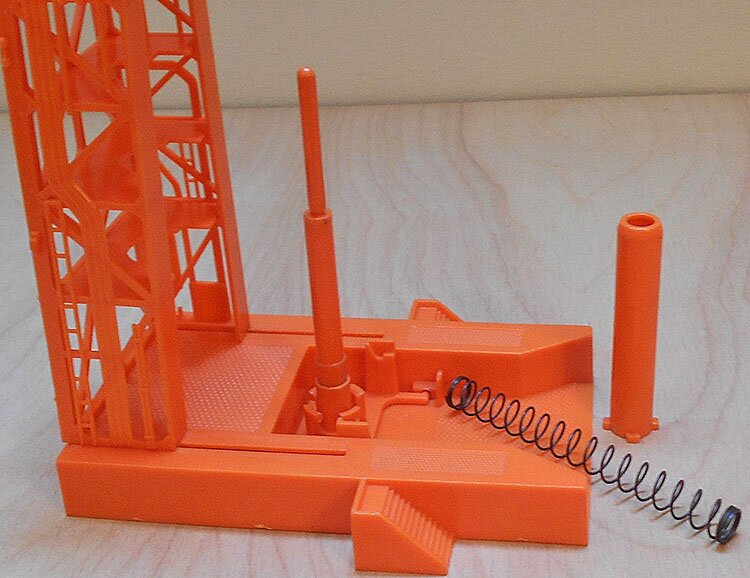 |
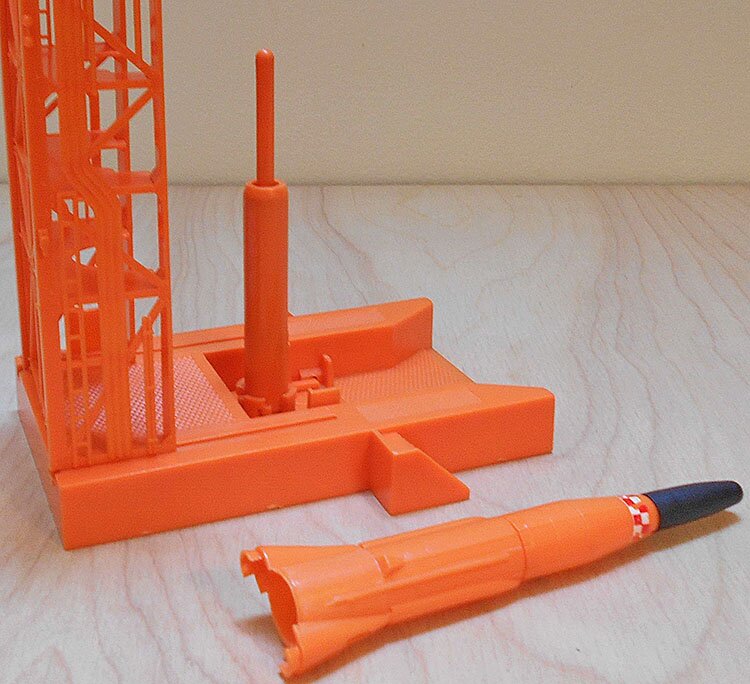 |
| Atlas gantry with rocket in place (PL-1101 and PL-950) |
Gantry with spring and housing for spring that has tabs that lock onto the base for firing Orange gantry is from Operation Moon Base playset |
Gantry with spring and housing in place ready to fire rocket |
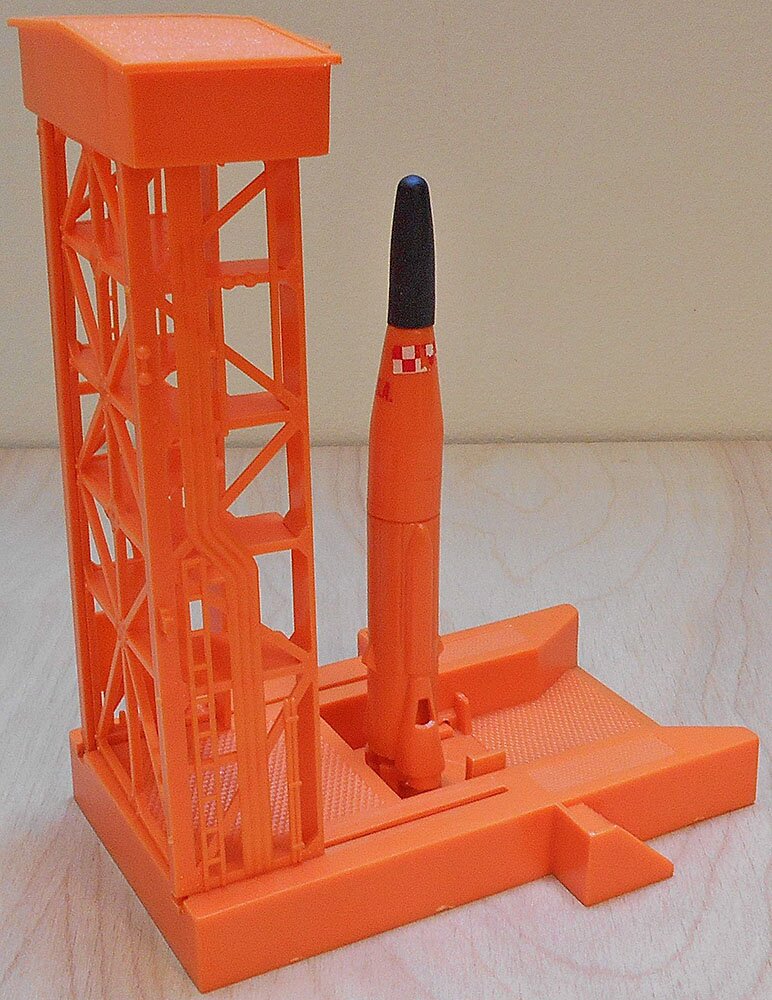 |
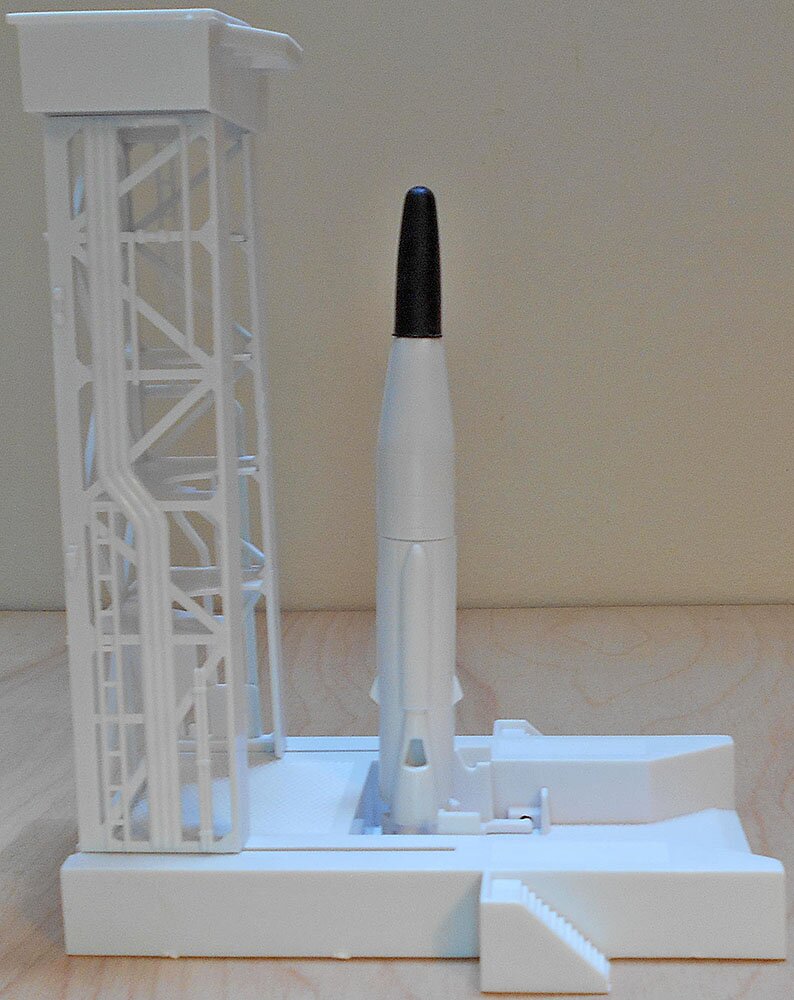 |
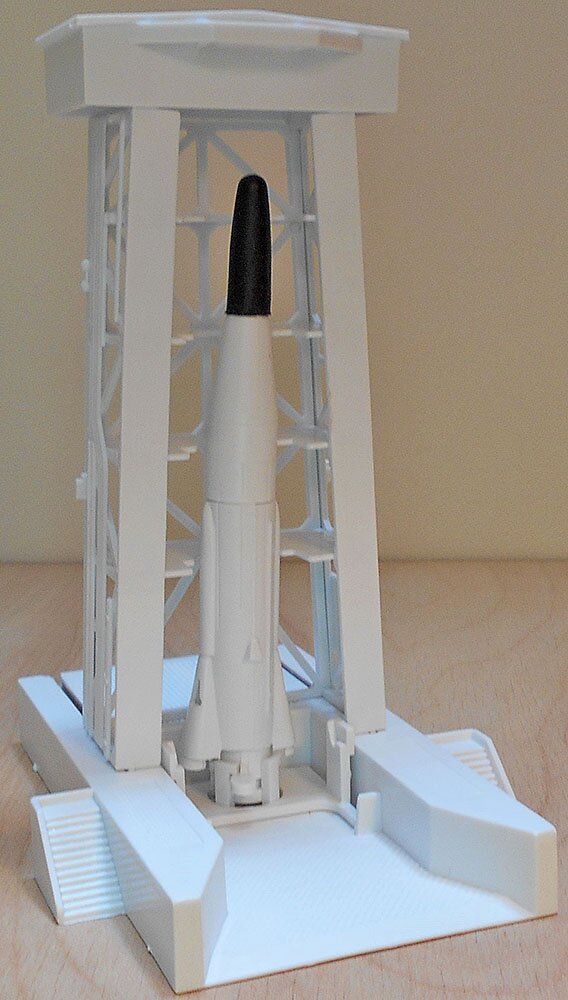 |
| Gantry ready for firing Note the slots in the base for the gantry to move over the rocket for maintenace |
Gantry ready for firing | Gantry moved over the rocket for maintenance |
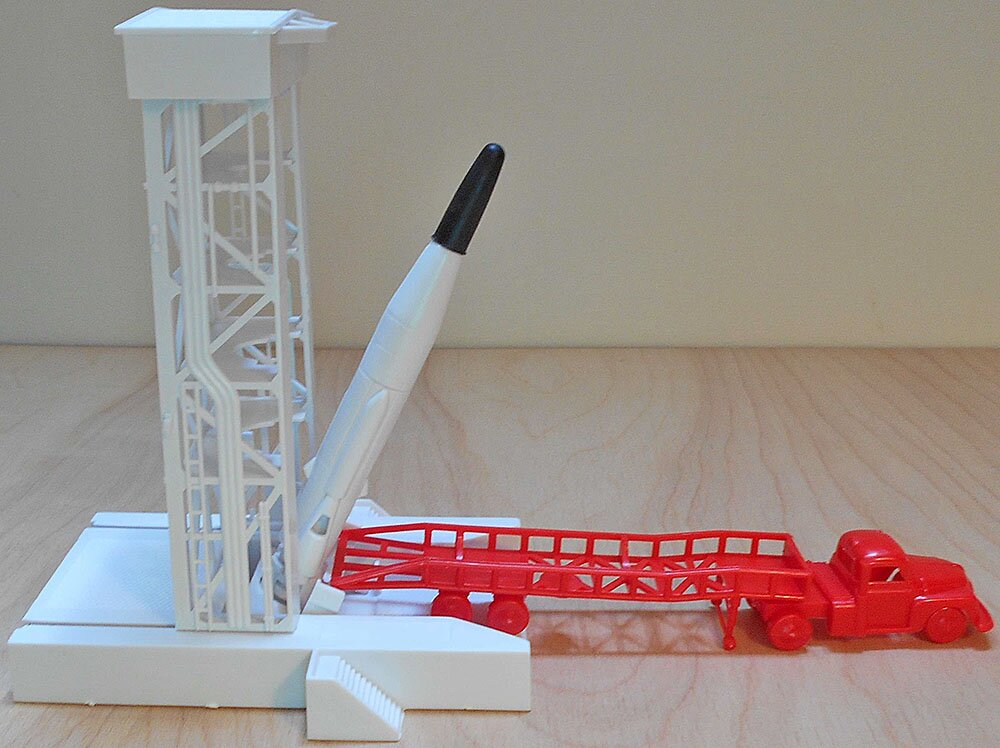 |
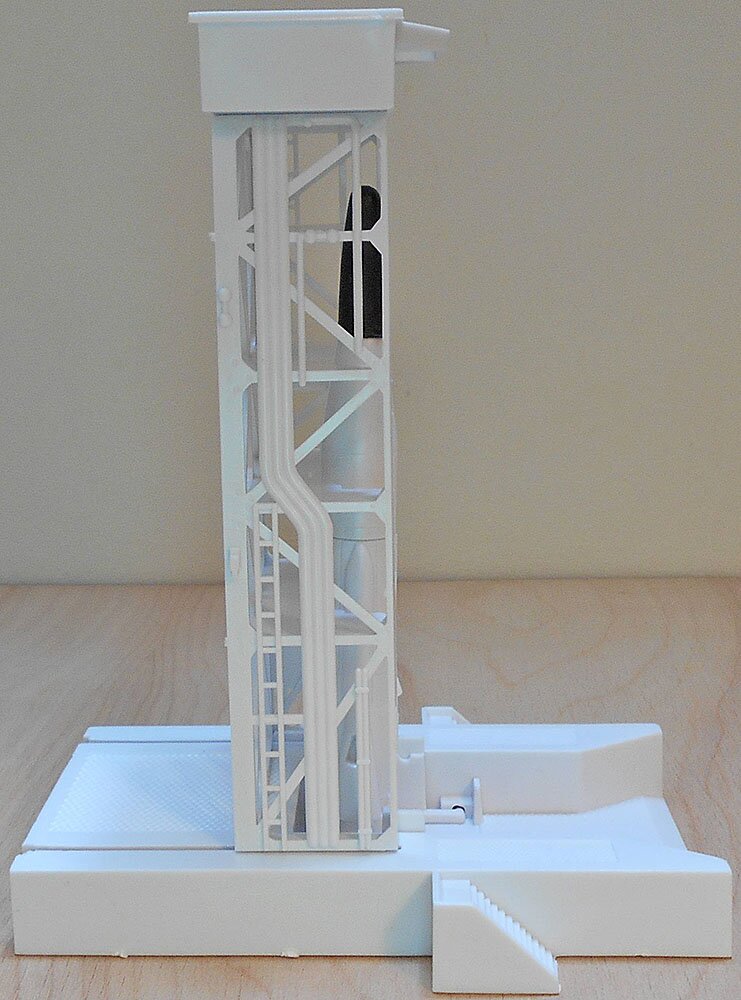 |
|
| Missile carrier delivering rocket to gantry |
Rocket in place over gantry | |
 |
||
| Operation Moon Base main driver and trailer for rocket | ||
Moon Base launchers
| Gantry | Launching pad | Rocket |
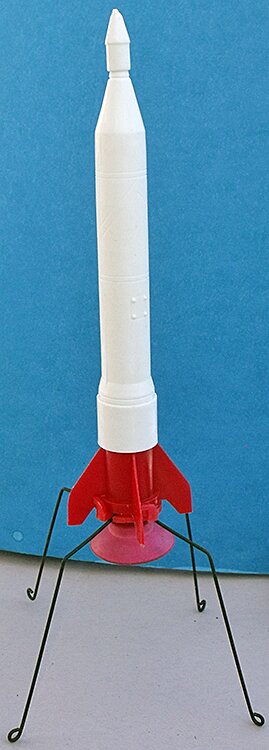 |
You attach the suction cup on the bottom of this rocket to the floor, then wait for it to gradually release, with the rocket sent flying by the compacted wire legs. The rocket stands about 7-1/2 inches tall. On the one you see here, the rubber has hardened somewhat, but it still flew upwards about eight feet when "fired." Of course, that was straight up and down, probably not the ideal trajectory...but launch it from a slanted surface and you could probably do some damage! Mothers beware! |
| Delayed action rocket |
Mystery Space Ship launcher
According to PFPC Issue 56, the Mystery Space Ship set had a rocket launcher that could be mounted on the mystery ship or the ship's base; sets included three rockets. The rocket shown on the set's instructions looks pretty cool, but unfortunately the actual small, ultra-plain space rockets look little like those pictured.
Much smaller than Marx' other rocket launchers, the Mystery Ship launcher is about three inches long; the rocket itself about 1-3/4 inches. These came in orange or green in hard plastic. The rocket is spring-fired, held by a tab at the top of the launcher body until it is ready to be released. The launcher I have has the original spring in good shape -- many thanks to space toy guru Steve Young -- and fires a rocket about 15 feet. Do this carefully, however, as the rockets are small and easily lost.
The launcher and rockets can be found only in the Mystery Space Ship set.
 |
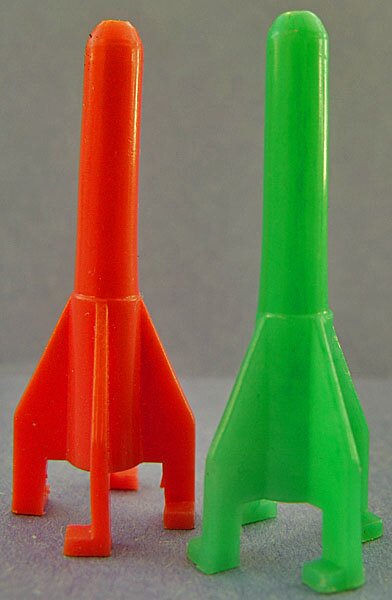 |
 |
| Rocket launcher with original spring | Space rockets | Rocket ready to fire |
Galaxy Command rockets
Although firing rockets had gone away with new child safety laws by the time Marx introduced its Galaxy Command Play Set in 1979, the set included several non-firing rockets. These could be used with the set's trailer for carrying rockets and a rather primitively-made launching pad (see description later on this page).
Note that the photo below is from Fritz and Bettina Berg of Toys and Stuff. Despite their web site, I can find no way to contact them. They have contacts of similar sites on their site, so I think they will not mind me using them. However, if you are them, please contact me, or if you know them, please let me know how to contact them! I generally do not use photos without permission, but these are so wonderful, I could not resist.
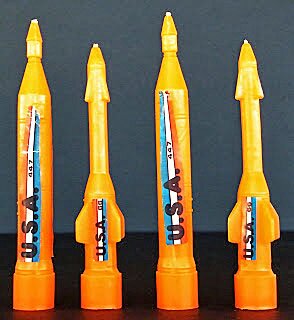 |
| Non-firing rockets from Galaxy Command Play Set Photo courtesy of Fritz and Bettina Berg of Toys and Stuff |

| Ground Vehicles |
Tom Corbett Space Car
This space car was about 5-1/2 inches long and 3 inches wide. The car was a metallic blue hard plastic with black wheels; it is a treasured item among today's collectors. You can find them, but it will set you back $100 or more!
The seated figures from the Tom Corbett and the Space Patrol groups fit nicely into the car (see space figures page).
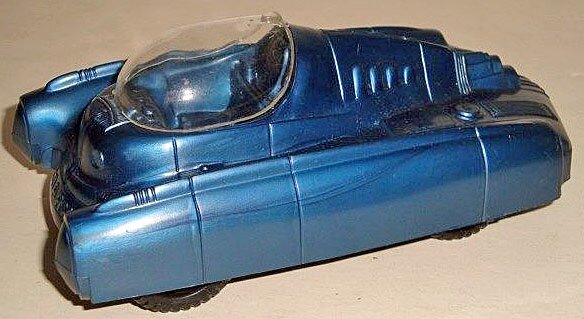 |
| Tom Corbett space car (Car PL-475, Canopy PL-488) Photo courtesy Allan Ford, Ebay 610allanf |
Cape Canaveral vehicles
PL-1102
In 1961, Marx introduced a complete line of vehicles to service space operations at its Cape Canaveral playsets. Playset Magazine Issue 37 notes that the vehicles came in alternating orange and silver, each set having cabs in one color and trailers in the other. All wheels were orange.
The trailers included a rocket fuel tank, a load of fuel hose, and a missile carrier..
 |
| Cab with missile carrier Photo courtesy of collector Bob Spreitzer |
 |
| Cab with rocket fuel tank Photo courtesy of collector Phil Webb |
 |
| Cab with trailer carrying fuel hose Photo courtesy of collector Phil Webb |
 |
| Cab-trailer hitch design Photo courtesy of collector Phil Webb |
Moon Base vehicles
Another group of vehicles -- these operable on the moon -- was introduced in 1962 in Moon Base sets. The unusual-looking vehicles were made in light blue hard plastic with black wheels. They also appeared in Giant Martian Landing (light blue) and Galaxy Command (white).
The vehicles are large -- though still a bit underscale compared to the figures -- with the prime mover being about 2-3/4 inches wide, 5-3/4 inches long, and 2-3/4 inches tall at its highest point. It is hollow, with no interior detail.
Note that the photos below are of vehicles from the Galaxy Command set and belong to Fritz and Bettina Berg of Toys and Stuff. Despite their web site, I can find no way to contact them. They have contacts of similar sites on their site, so I think they will not mind me using them. However, if you are them, please contact me, or if you know them, please let me know how to contact them! I generally do not use photos without permission, but these are so wonderful, I could not resist.
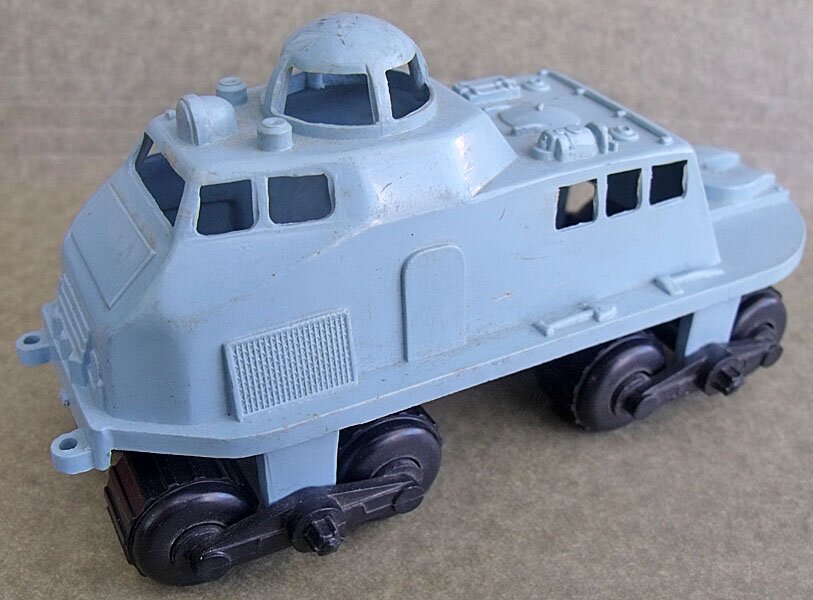 |
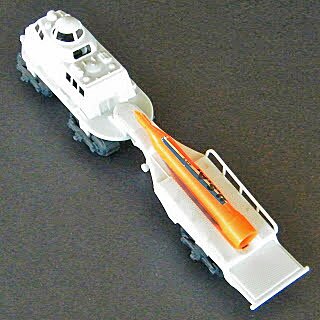 |
| Prime mover about 5-3/4 inches long |
Prime mover with loaded trailer Photo courtesy of Fritz and Bettina Berg of Toys and Stuff |
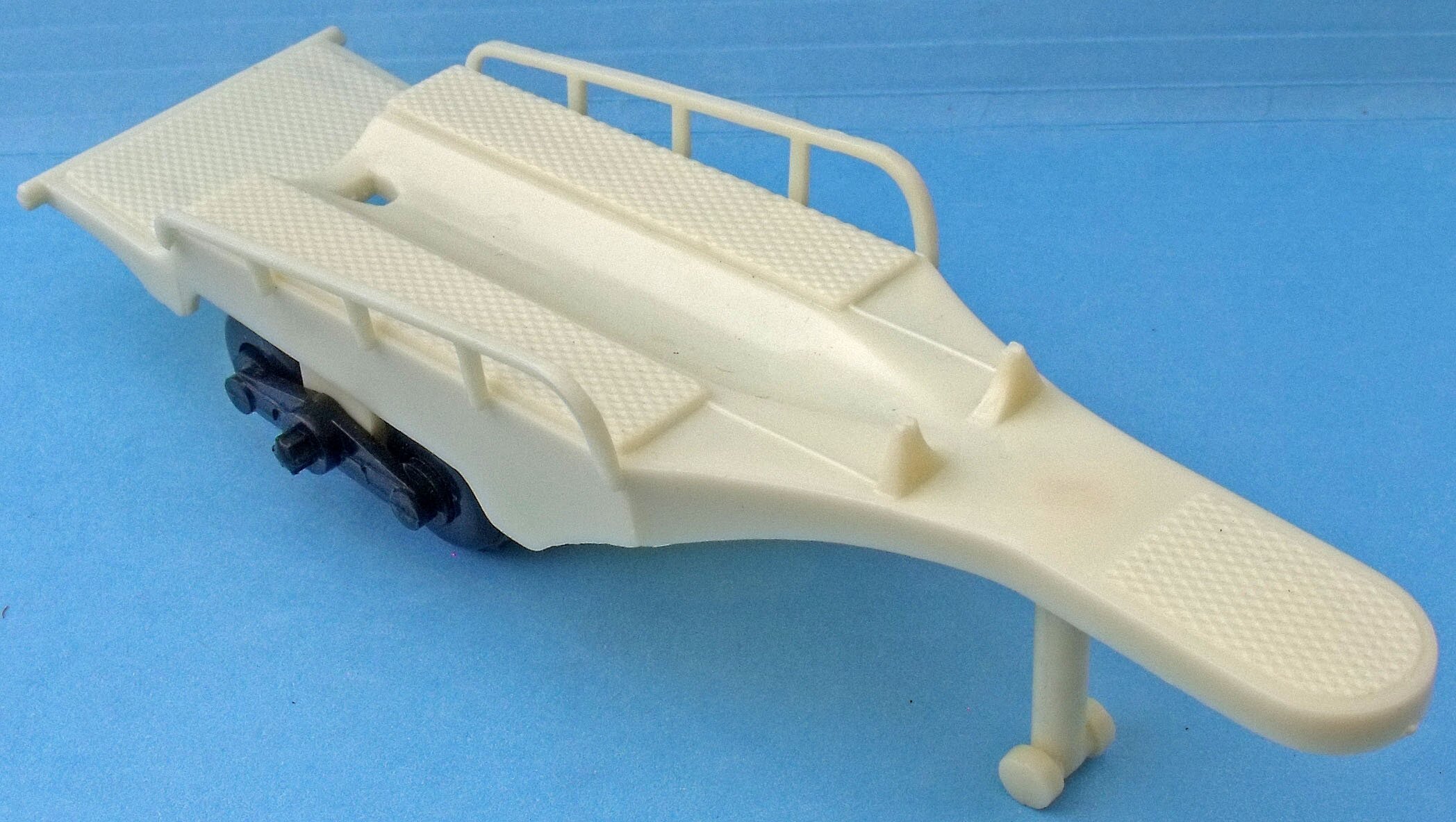 |
| Missile trailer About seven inches long. Front end of unhitched trailer is held up by separate support rod with molded-on wheels. |
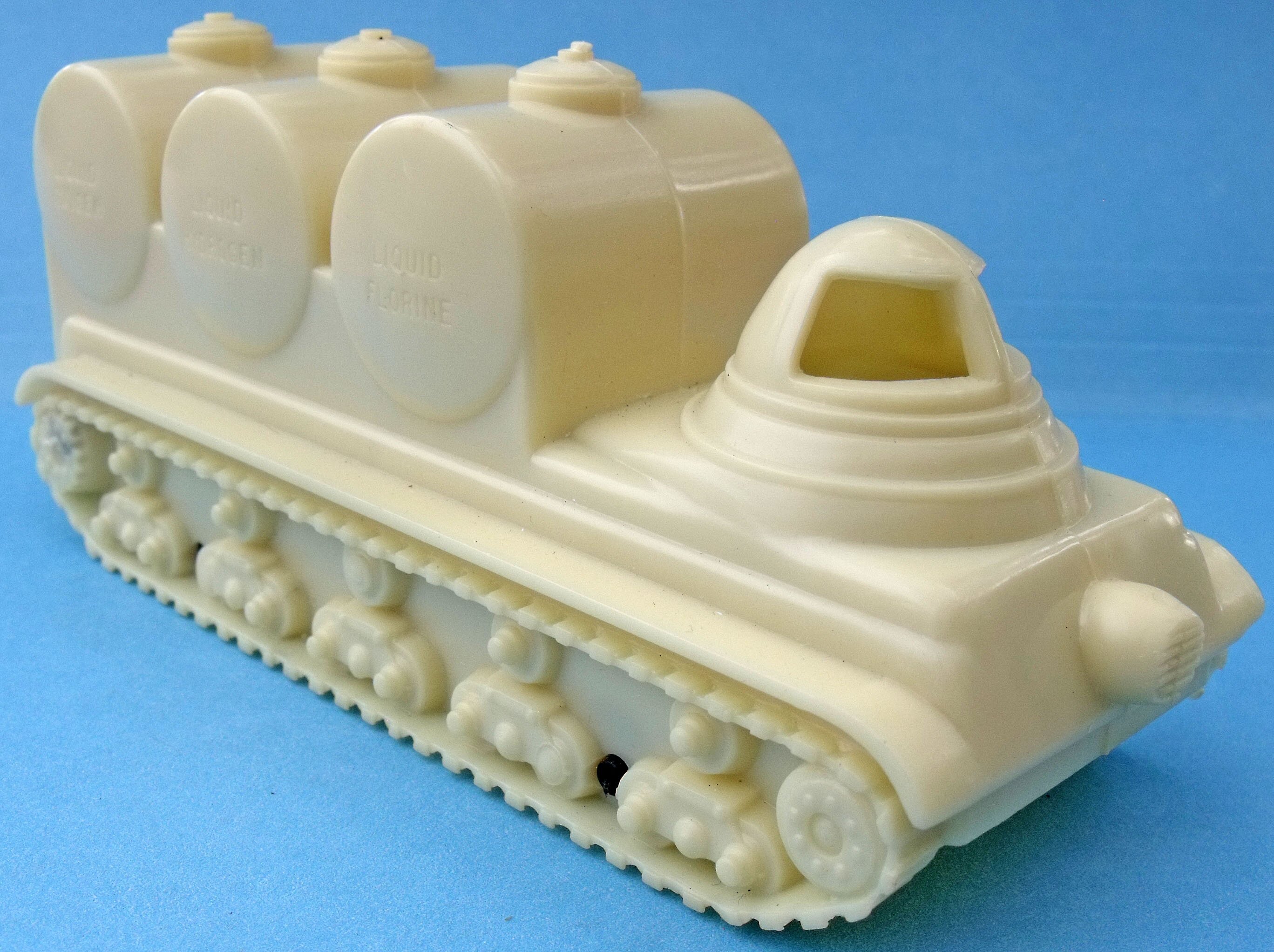 |
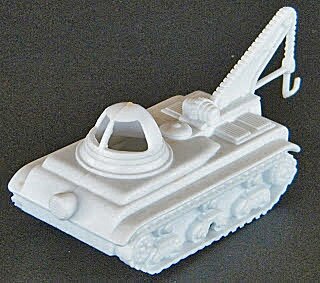 |
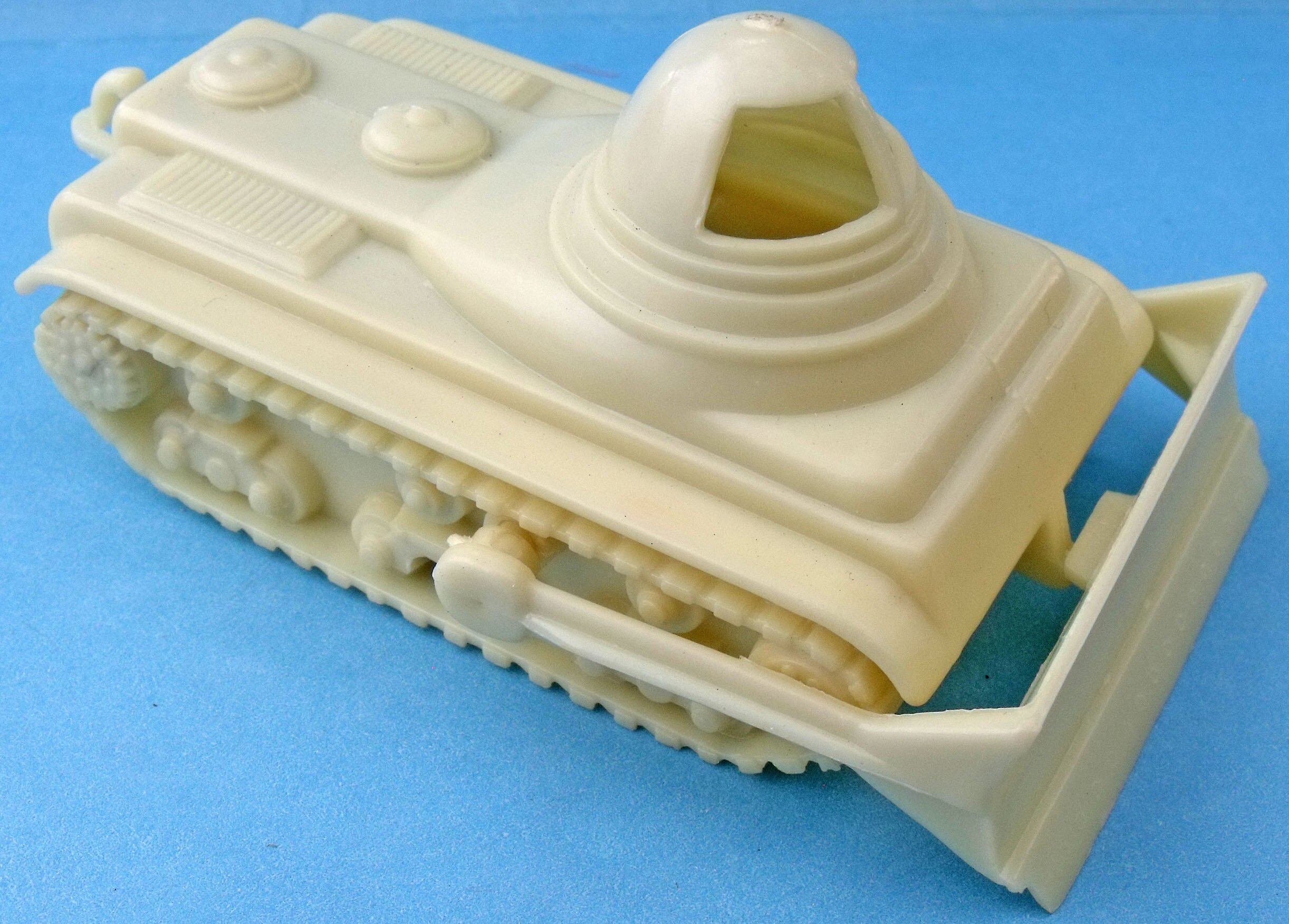 |
| Track vehicle, fuel carrier about 4-1/2 inches long |
Track vehicle with hoist | Track vehicle with plow about four inches long |
| Above photo is courtesy of Fritz and Bettina Berg of Toys and Stuff | ||
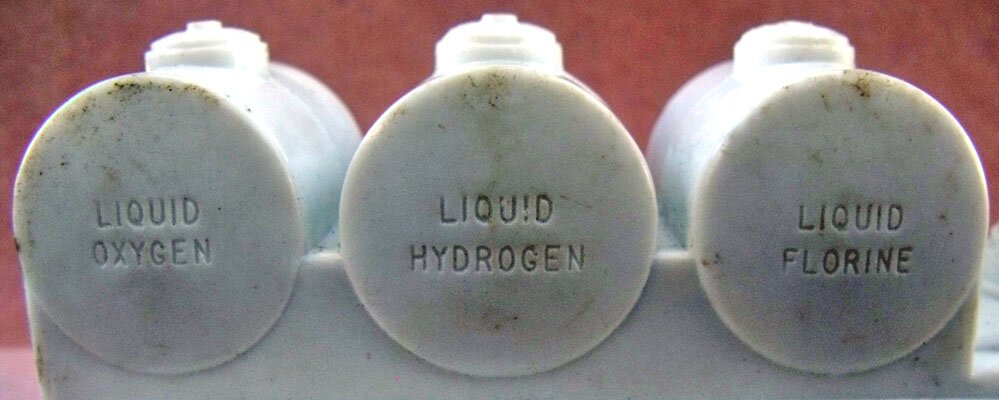 |
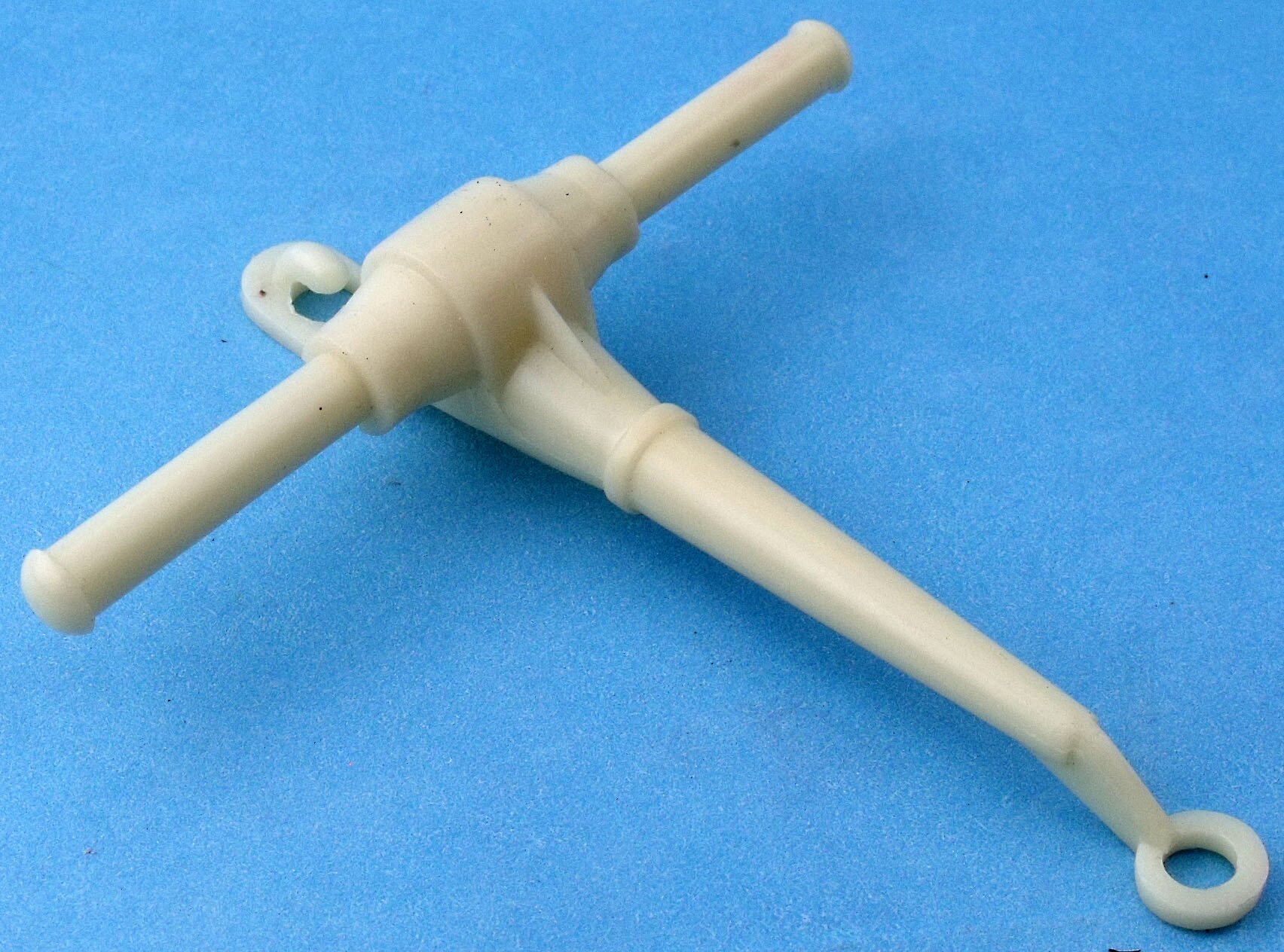 |
|
| Close-up side view of tanks of fuel carrier | Tow bar for ballon wheels (below) About three inches long |
|
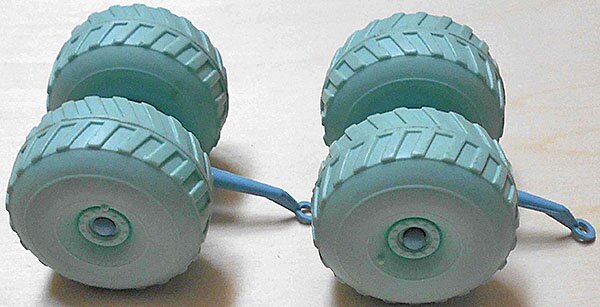 |
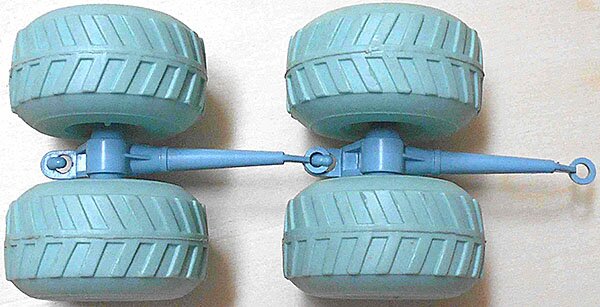 |
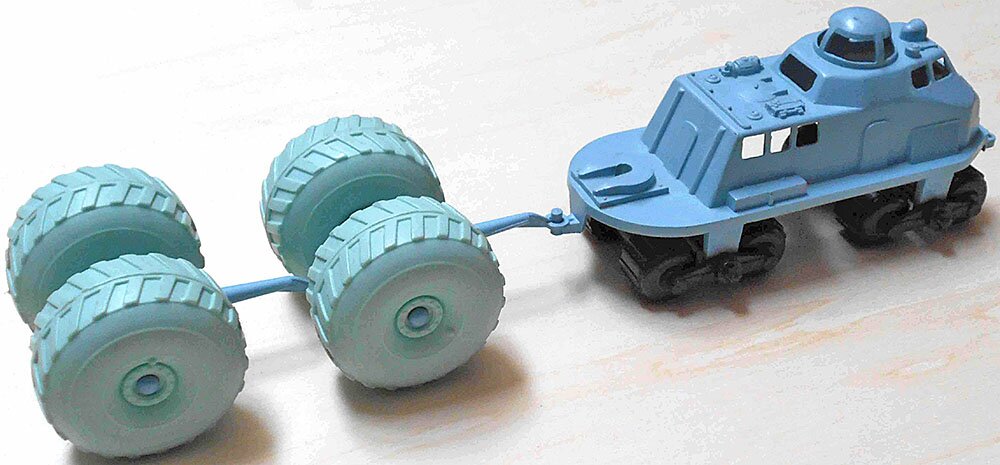 |
| Balloon wheels | Top view of balloon wheels | Balloon wheels pulled by prime mover |
| The three photos above are courtesy of collector Bob Speitzer | ||

| Flying Vehicles |
Flying saucers
Of course, you must have a good UFO in any space set. Marx made two versions of "flying saucers", and neither one is very impressive, though I suppose they added a little play value, giving the kids something to shoot up into the air.
Early Tom Corbett and similar sets included red or yellow, hard plastic "flying saucer" disks that were launched with rubber band power from red and yellow launchers. The entire contraption is very small. Saucers are about two inches in diameter, and the launcher about 3-1/2 inches. When a saucer is loaded, the entire item stands only about 1-1/4 inches high.
As seen in the photos below, the side lever is pushed in, pulled to the left, and at some point the lever hits a tab on the underside of the launcher, sending the saucer about a foot up in the air. The one I have cannot be "cocked" and left ready to fire, and I believe (but am not positive) this is the way they were meant to work. Its direction of flight is rather random -- sometimes straight up -- and mine does not travel more than a foot or so at most. At least that is how mine works. I suppose that the saucer flew a little higher and/or further when the launcher was new, but again am not sure. Nor do I know whether the rubber band below is original or even what size rubber band came with the saucer. Some of the fins on the saucers shown below show wear, so I believe this one has seen a good about of activity, and it's likely the rubber band is not original.
Based on size and shape, saucers were clearly made for play value, with no semblance of a realistic representation of anything or any relation to the rest of a set's figures or accessories. Based on my recollection of my childhood, it was pretty cool to try and have the saucer positioned just right to knock out one or two of the aliens as it came back down to earth! However, since my saucer flies such a short distance, my memory may be faulty.
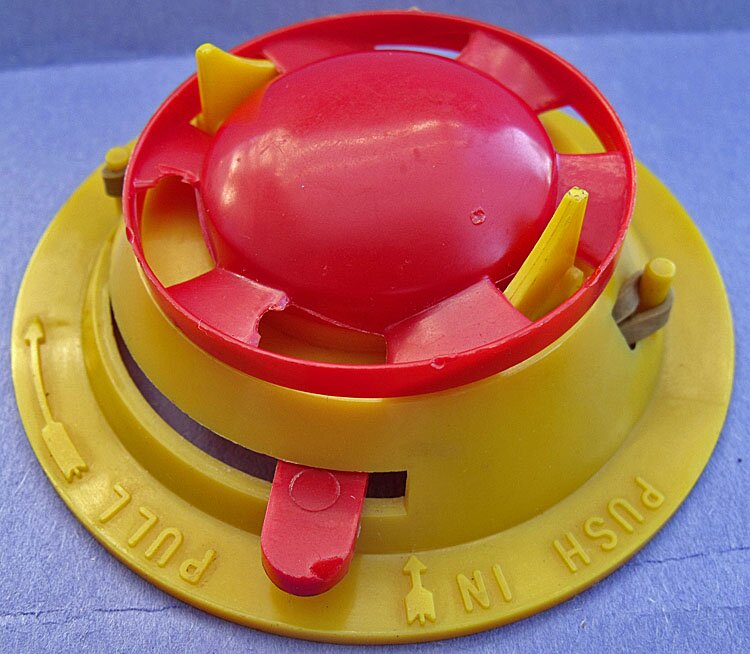 |
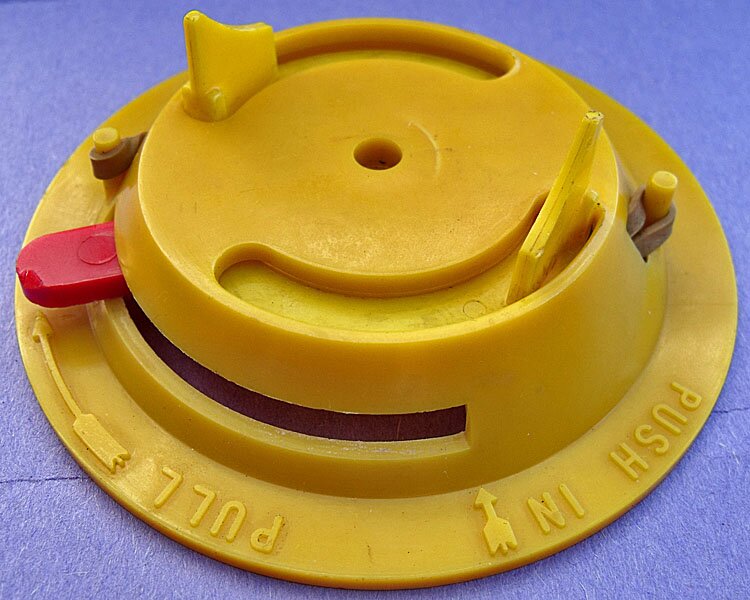 |
| Tom Corbett flying saucer ready for launch | Top of Tom Corbett flying saucer launcher |
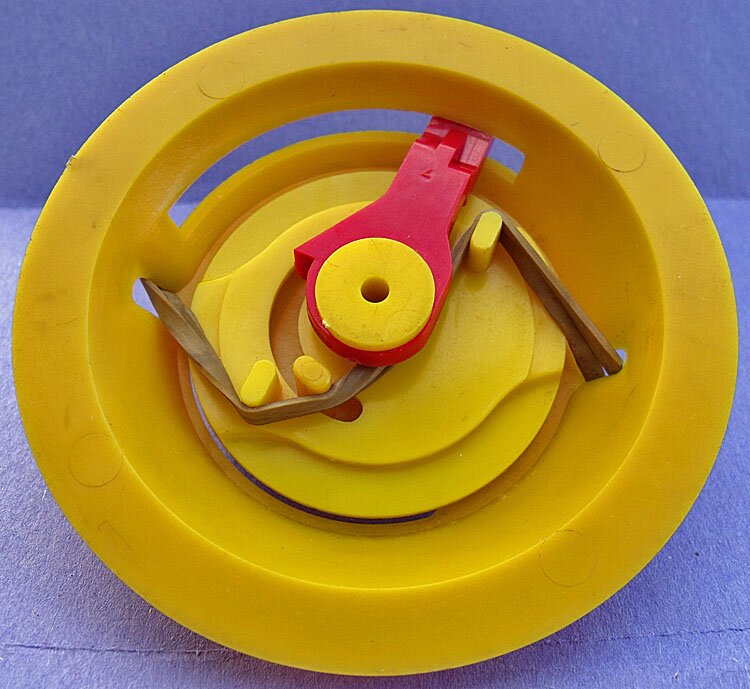 |
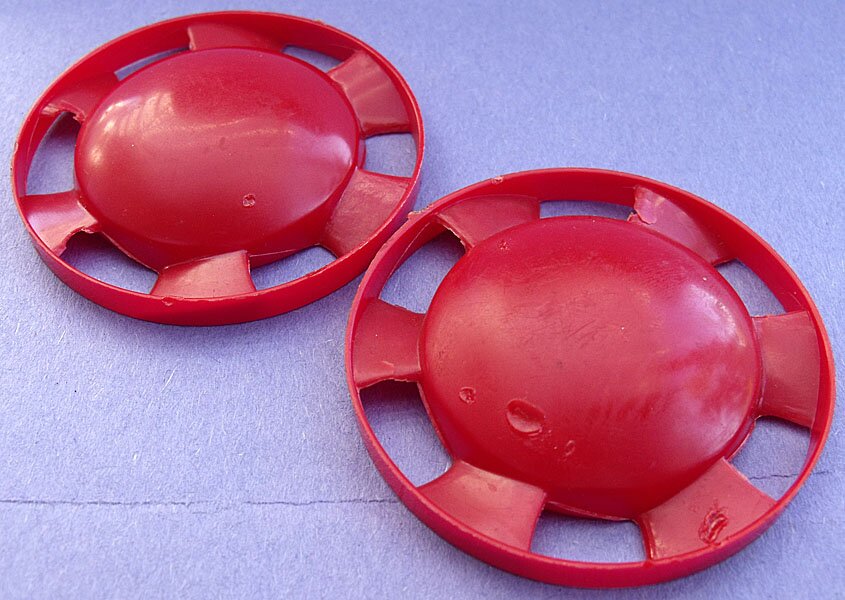 |
| Bottom of Tom Corbett flying saucer launcher | Saucers |
The second flying saucer version came with Moon Base playsets, first released in 1962, and were similarly small. They are sometimes called satellites, though they look nothing like satellites we know today. The saucer again is about two inches in diameter, so -- unless it is the most out-of-scale Marx ever made -- there is no chance that any figure anywhere near the size of those in the playset could travel in the thing. On the other hand...maybe this is an inter-galactic space drone that can be sent to obtain information from anywhere in the Universe?
The saucer uses a spring mechanism to fly; the spring is wound up by turning the saucer once it is placed in launching position. The one shown below still works, and can fly a somewhat impressive 10 to 15 feet. However, the spring mechanism obviously can easily be overwound, and I imagine that many which still exist no longer work.
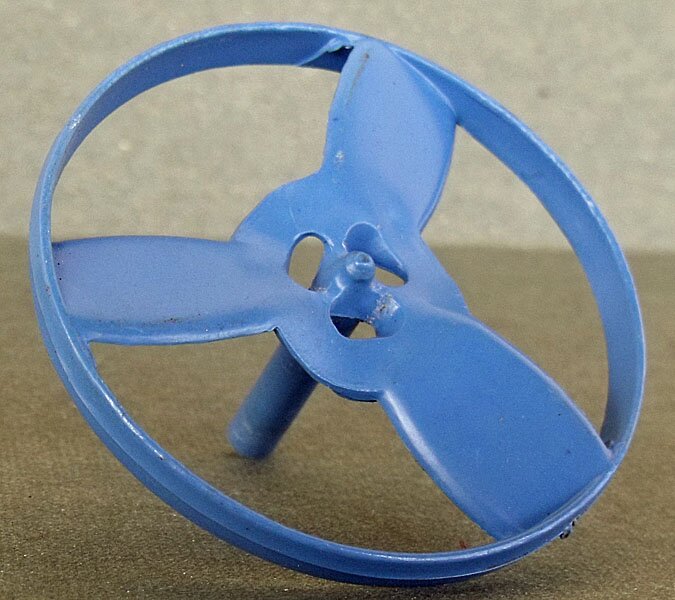 |
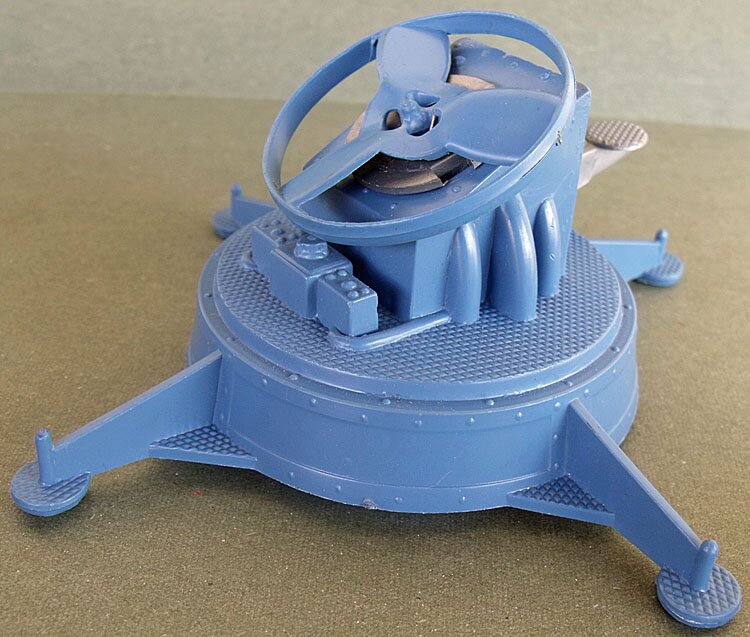 |
| Moon Base flying saucer | Moon Base flying saucer launcher (with saucer in place) |
Rocket Firing Jet
The company's rocket-firing jet -- which was first seen in a 1960s Battleground playset -- also was included in the 1961 Sears Deluxe Cape Canaveral Play Set(#4536). The Delta-wing jet was included in several military playsets, but this was its only appearance in a space set.
The multi-piece jet held a spring-powered rocket under each wing. According to Playset Magazine Issue 37, the Cape Canaveral jet came in a unique mixture of colors: "...mixed blue semi-hard plastic, with silver rocket pods, rockets, and landing gear, or can be found in reverse with silver plane and blue accessories."
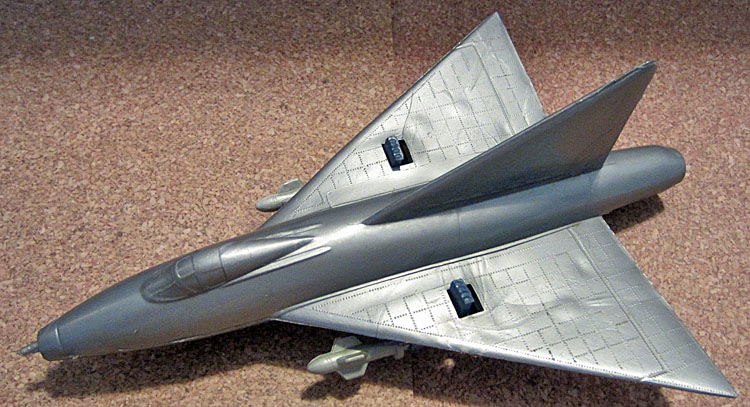 |
| Rocket-firing jet (Silver jet shown is probably from a military set.) Photo courtesy of Phil Webb |
Rocket Firing Moon Ship
In addition to the rocket-firing jet in the one Cape Cavaveral set (see previous section), a rocket-firing "moon ship" was included in the Operation Moon Base playset, sold first in 1962. Made in hard plastic metallic blue, it held two spring-powered rockets and is similar to the rocket-firing jet. The moon ship consists of two body halves, two triggers, two springs, and a sprue of six rockets.
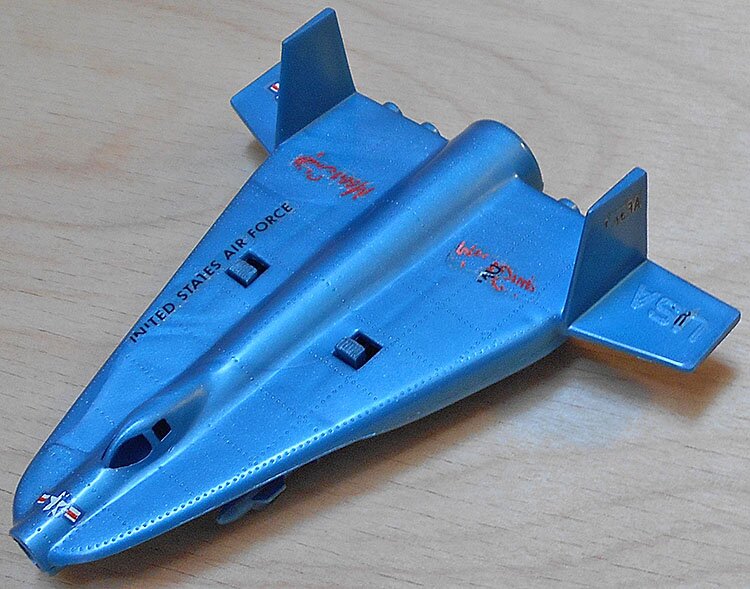 |
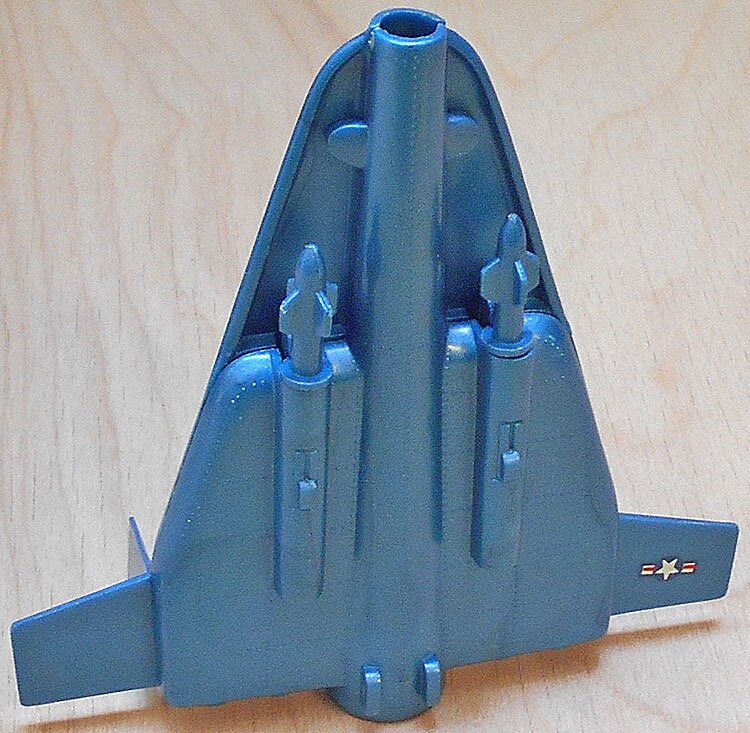 |
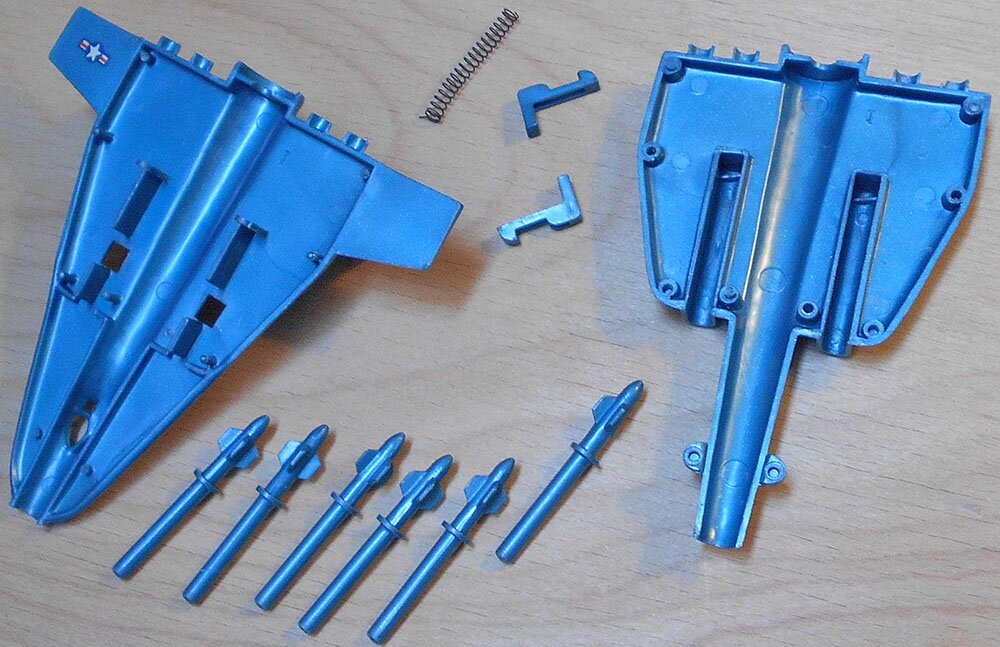 |
| Rocket-firing moon ship | Bottom of ship with missiles | Pieces of the ship |
| Photos courtesy of collector Bob Spreitzer | ||
Rescue Helicopter
Of course, as we all saw on television, a helicopter was needed to recover the astronauts after their capsule landed in the ocean. Marx simply borrowed its helicopter with a winch from its military sets for some Cape Canaveral sets, and all was well.
| The three photos below are courtesy of collector Bob Spreitzer | |
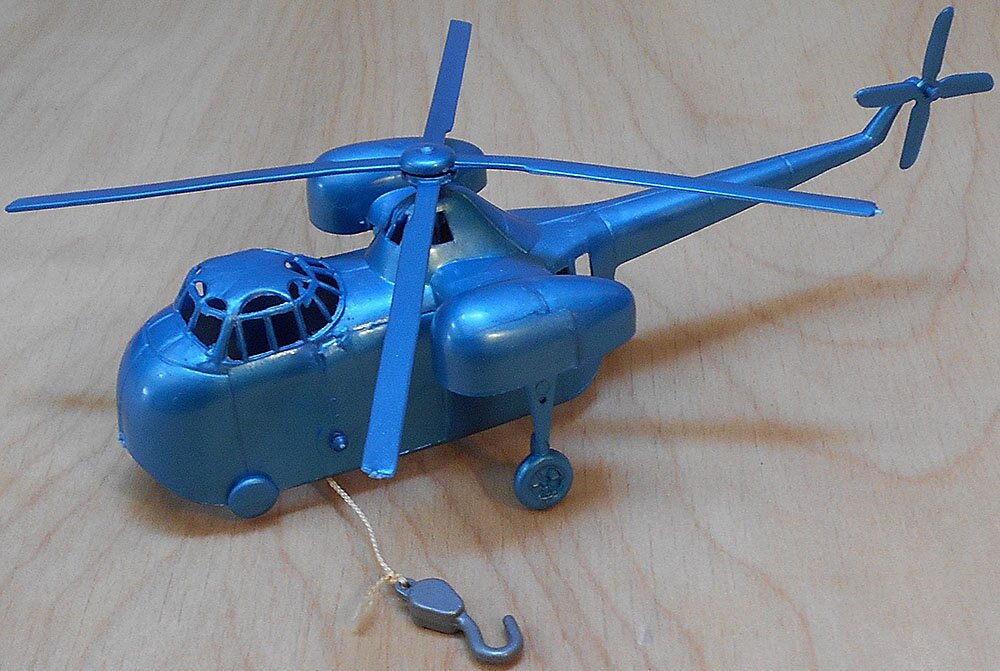 |
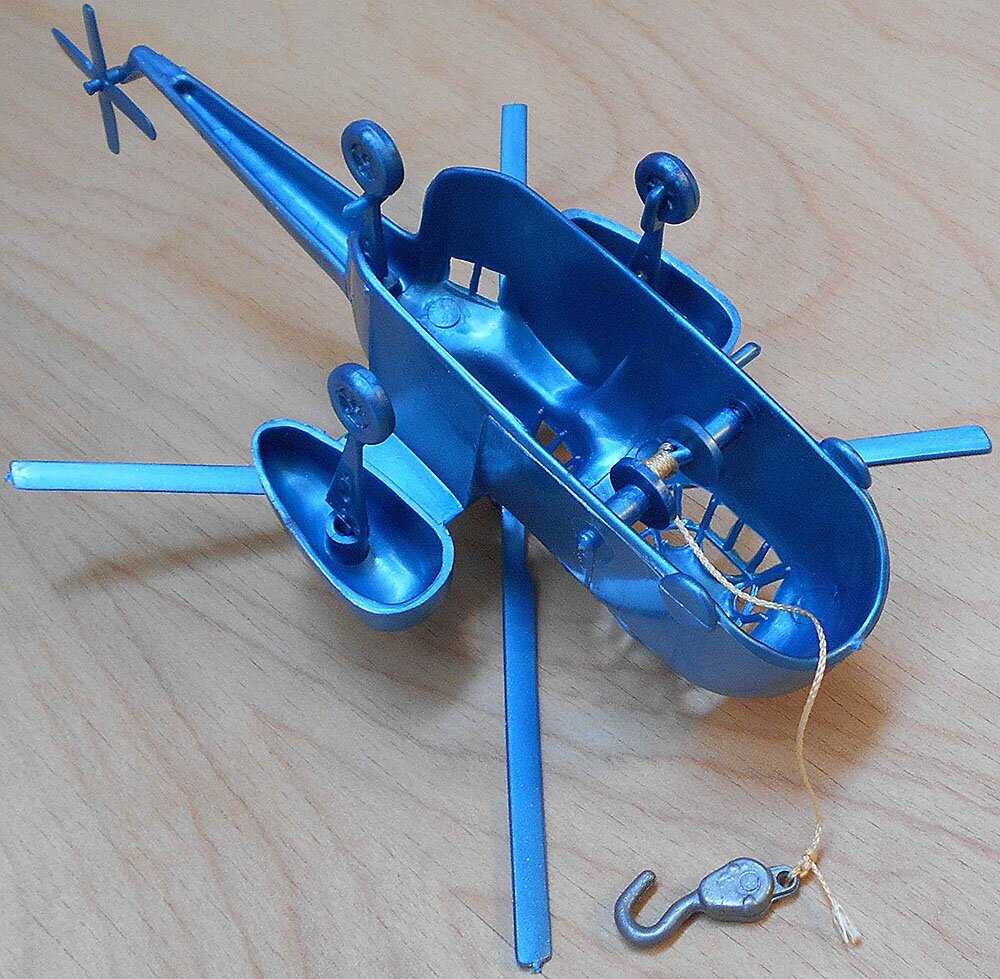 |
| Rescue helicopter | Bottom of helicopter with winch |
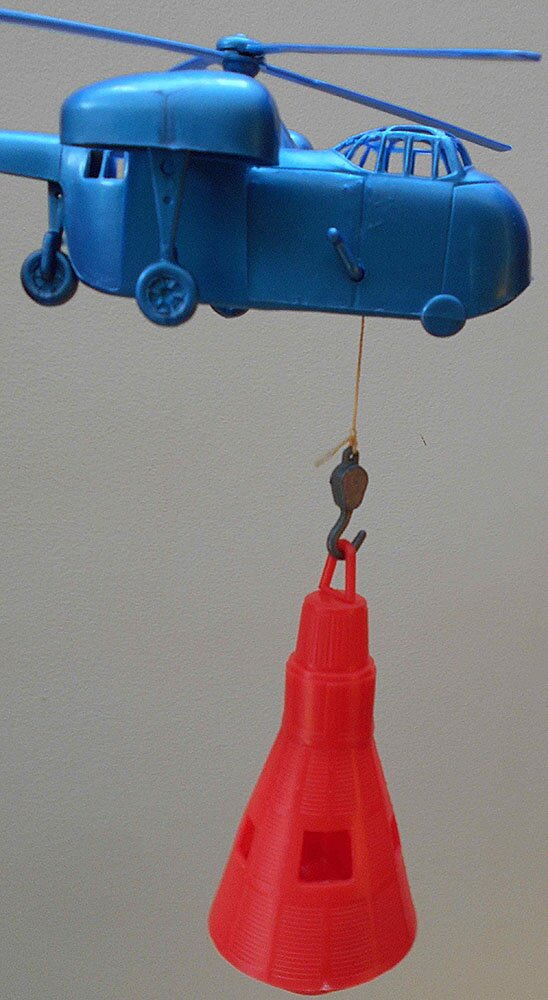 |
|
| Helicopter in action | |
Flying Helicopter
A different helicopter was included in the 1961 Sears Deluxe Cape Canaveral Play Set (#4536), the company's flying helicopter. Again, it was found in several military playsets, but this was its only appearance in a space set. Manufactured in soft plastic silver, the spring-powered helicopter took off from a multi-piece base.
Playset Magazine Issue 37 notes, "Real missile bases always had a helicopter that flew 'range safety' making sure the launch area was clear."
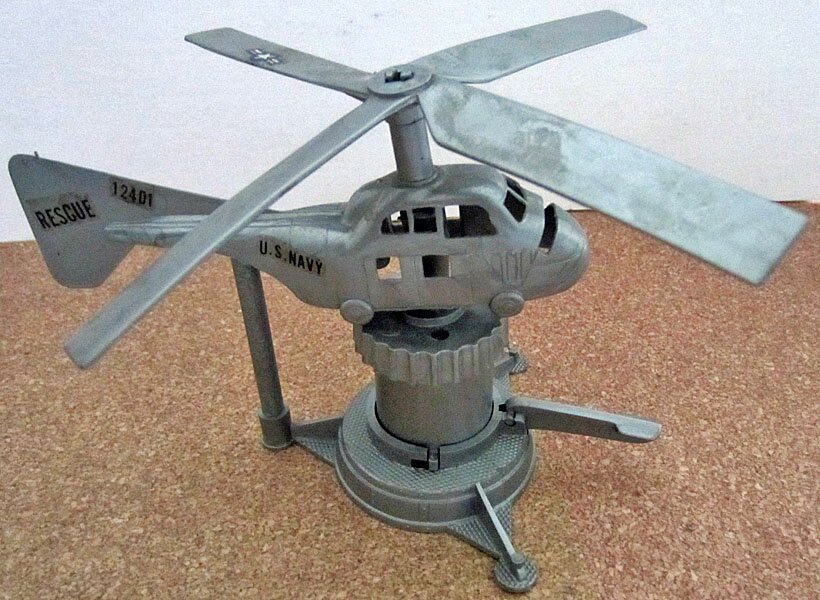 |
| Flying helicopter Photo courtesy of collector Phil Webb |
Space Capsule
Starting in 1962, most Marx space sets included a one-man space capsule, modeled after the capsule in which early U.S. astronauts orbited the earth. The capsule was made in silver or red, with a 54mm astronaut that fit inside and was made in the same mold. According to PFPC Issue 35, it was based on a Mercury space capsule; it is a stand-alone item that does not fit on any playset rocket. Although the U. S. space program built larger capsules that held more than one man, Marx never produced larger space capsules for its playsets.
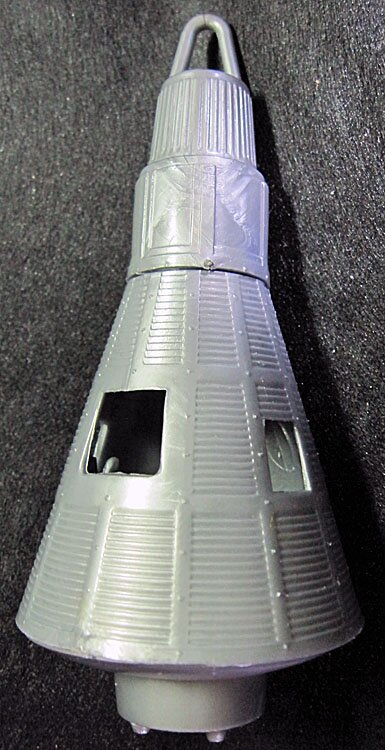 |
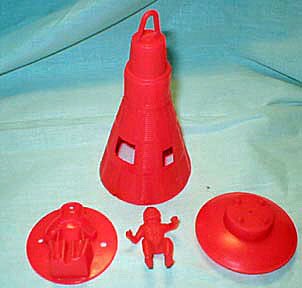 |
| Assembled space capsule Photo courtesy of collector Tom Lozowski |
Pieces of space capsule Photo courtesy of Kent Sprecher |
Moon Base Space Platform
Moon Base playsets, first sold in 1962, included a greatly undersized space platform, a structure in which astronauts theoretically would remain in outer space for extended periods of time. Attached to a metal wire, the platform orbited above the space station located on the set's moon terrain. The platform is shown later on this page as part of the set's moon mountain under the Terrain Section.
Mystery Space Ship
In addition to the Moon Base playsets, Marx also introduced its down-scaled Mystery Space Ship playset in 1962. Its primary attraction was an unusual, circular "Gyro Space Ship" (with hand crank) that could make a variety of movements and sounds. The set's instructions showed fifty "tricks" the ship could perform. The yellow space ship was about eight inches in diameter with two domed compartments on top that could hold down-sized versions of astronaut figures initially made for Marx space capsules (see section above). A launcher on top of the ship could fire small rockets (see section on rockets and missiles). Forget the few tiny figures and accessories that came in the set...the ship was what sold this set and the ship was a world of fun all by itself. Based on its frequent appearance on Ebay, the set was very popular.
PFPC Issue 56 includes an excellent article on the set.
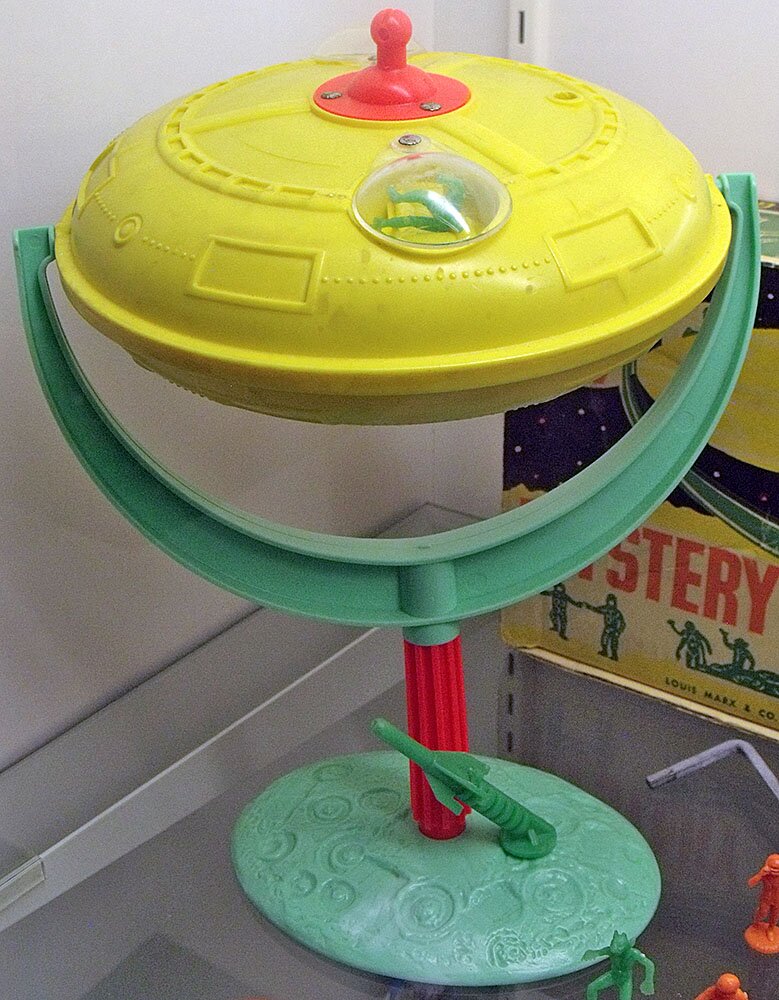 |
| Mystery Space Ship Photo is of item at the Marx Museum in Moundsville, West Virginia |
| Ship crank |
Mystery Space Ship Space Car
Mystery Ship playsets included two small "space cars" which are just slightly larger than one of the set's down-sized space figures. They look like rockets with bulging rounded noses, seemingly straight out of a 1950s comic book. They have no launcher, so are basically decoration.
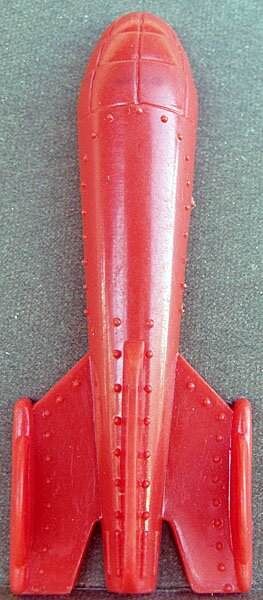 |
| Mystery Space Ship Space Car |

| Water Vehicle |
The only water-born vehicle that came in a Marx space playset was an exploding submarine, which was in the 1961 Sears Deluxe Cape Canaveral Play Set (#4536). Playset Magazine Issue 37 goes so far as to call it "the key" to that set. According to Playset Magazine, the submarine was eight inches long, made in silver-gray hard plastic, and exploded with a "mousetrap-like spring mechanism." It also came in one military set and, as with most of Marx' military vehicles, it was grossly undersized for the rest of the playset.
The sub was made up of two body halves, a small tower that fits atop the sub, a small array of antennas that attach to the tower, and the exploding mechanism. Any disturbance to the top of the submarine would dislodge the parts and send them flying.
Playset Magazine notes the sub was so delicate that its parts were often damaged the first time it was "exploded." It came in only this one Cape Canaveral set and one military playset. Obviously, it is rarely found in today's market...and is expensive.
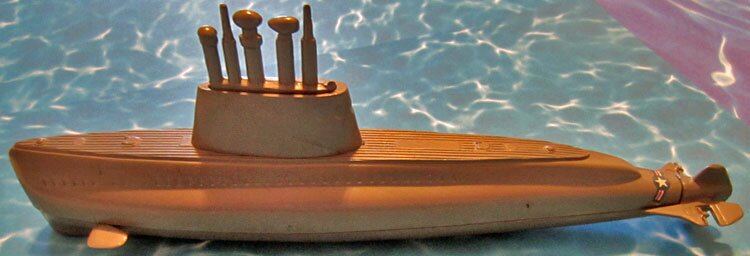 |
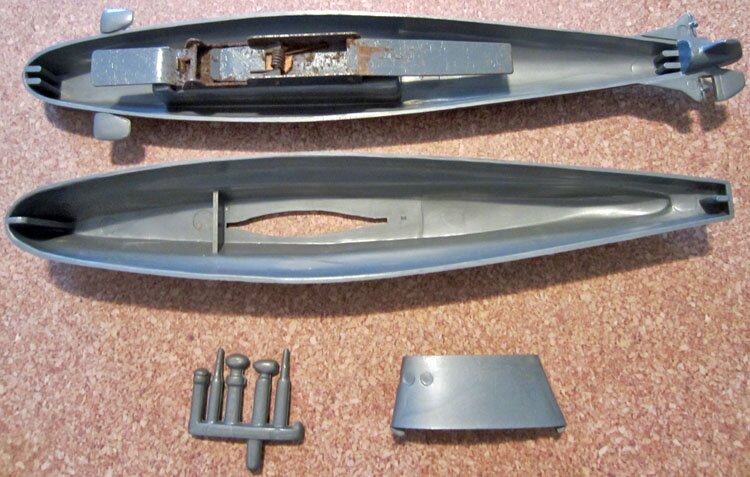 |
| Exploding submarine Photos courtesy of collector Phil Webb |
|

| Terrain |
Early space exploration sets had no terrain items other than sometimes a few trees and occasional playmats (see next section on Playmats). However, huge terrain pieces were the main parts in a couple of the company's later sets. Notably, these were produced about the same time that Marx was turning out large terrain pieces in its other playsets, such as Comanche Pass and Navaronne. Unlike those pieces, however, the large space set terrain was made of a thin vacuform material and is very difficult to find in good shape today.
Small terrain items
Trees
A few space sets included trees. They could be any of the three basic trees that were found in many other Marx sets, especially in the Wild West sets.
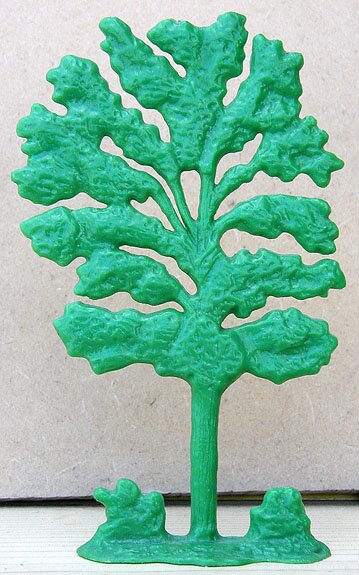 |
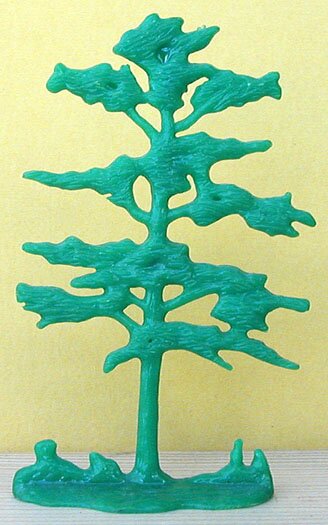 |
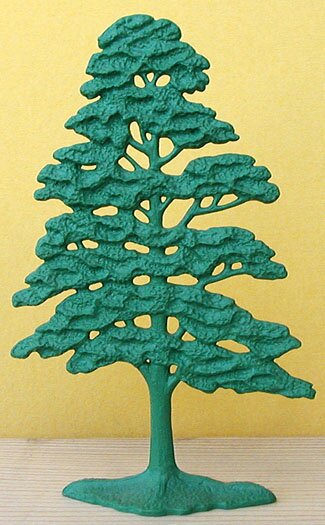 |
| Full tree or Oak tree (PL-131) |
Scraggly tree (PL-131) |
Delta tree or A tree (PL-524) |
Exploding mountain
Moon Base sets -- as well as a few military sets -- introduced the company's exploding "mountain" in 1962. The hard plastic accessory included a spring mechanism that sent the three pieces of the mountain flying in all directions. Instructions with the set read, "To blow up mountain, fire rocket from moon ship so as to strike top of small top section." A strike with anything else -- such as a rock or flying alien figure -- would serve the same purpose. PFPC Issue 35 says the Moon Base mountain came in light gray with swirls of yellow, black, and white. The one below appears to be a light tan, but is nicely swirled.
Actually more of a small hill than a mountain, the mountain's inclusion might be considered to reveal a lack of imagination by the Marx playset team in the field of space exploration, if not a little downright laziness to come up with something more original if they really wanted to reproduce something in the area of space explosions. How about an exploding rocket (I think the U.S. and Russia had a few such incidents!), exploding space ship, or even exploding flying saucer? However, I suppose the adoption of the already existing exploding mountain was primarily to save money and at the same time add a little playability to the set.
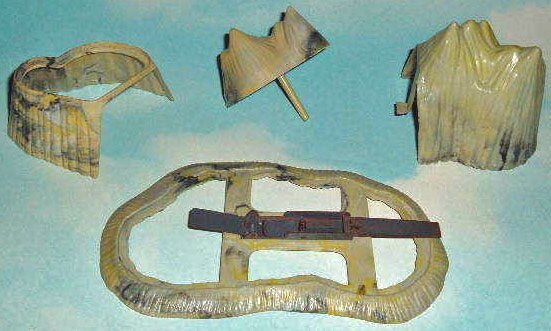 |
| Exploding mountain Photo courtesy of Rick Koch, Ebay ID toy-hood |
Moon Base Terrain
The Marx Moon Base playsets included many new accessory pieces, several which were not included in any other Marx set. A feature article on the
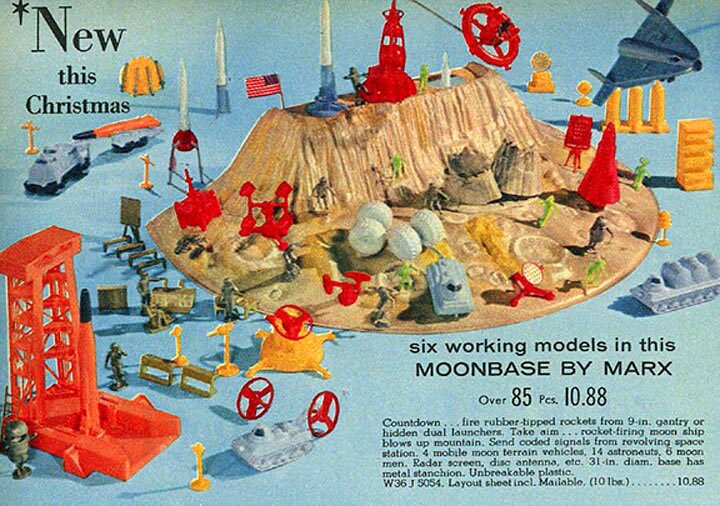 Moon Base sets in PFPC Issue 35 lists four or five different Moon Base sets, starting with Operation Moon Base (#4654) in 1962. An ad for one of the Moon Base sets is at left, photo courtesy of Kent Sprecher. As indicated, collector Bob Spreitzer has provided several of the following photos.
Moon Base sets in PFPC Issue 35 lists four or five different Moon Base sets, starting with Operation Moon Base (#4654) in 1962. An ad for one of the Moon Base sets is at left, photo courtesy of Kent Sprecher. As indicated, collector Bob Spreitzer has provided several of the following photos.The primary parts of the Moon Base sets were the moon base itself and an assortment of attachments to the base. The moon base was a large, impressive-looking vacuform piece. A unique tin litho structure sits "underground" inside the base and is accessible from the back of the base. On either side of the structure, the top of the moon base has a hole, through which vertical rockets/missiles could be fired. Attached to the top was a mechanism with a thick wire that held up a "space platform," which orbited above the moon base.
I have to assume that the space platform is intended to represent at structure with internal rooms and hallways for astronauts to conduct whatever work they need to do away from the moon surface. A neat piece, but at about 4-1/2 inches in diameter, it is very undersized.
Other than the mountain and tin litho base, these accessories were also in the company's Giant Martian Landing and Galaxy Command play sets. Due to the size of most of these items, they are not shown in scale with other items on this page.
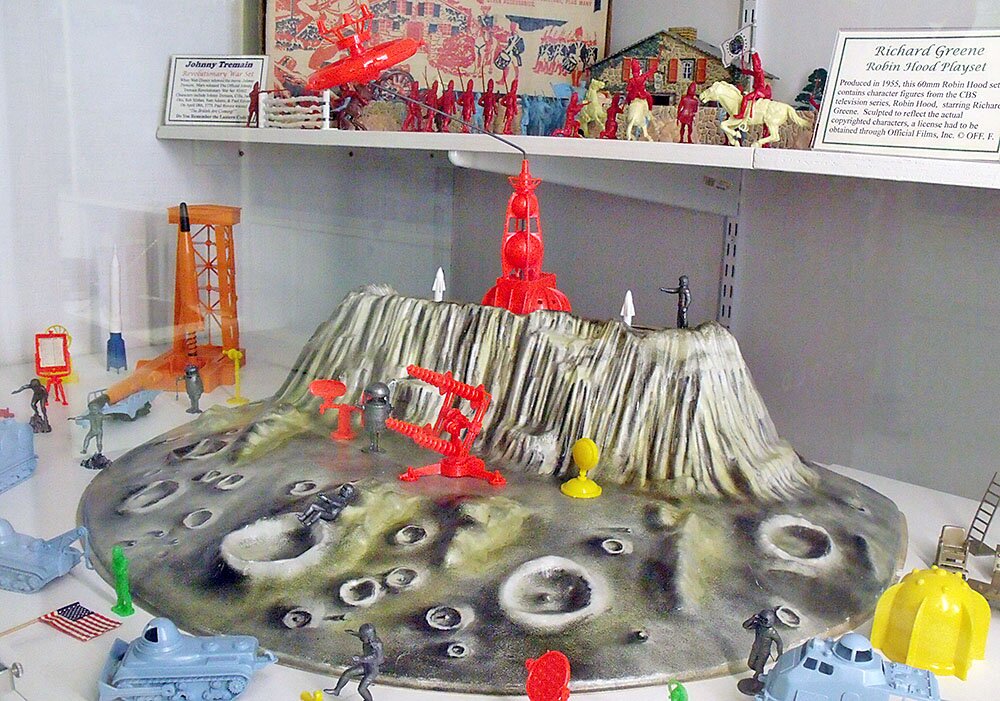 |
 |
|
| Moon Base vacuform mountain Photo is of items at Marx Museum in Moundsville, West Virginia. Note the orbiting satellite near the top of the photo and the two rocket nose cones protruding from the mountain top. |
Moon Base box and contents Photo courtesy of Facebook page Toy Soldier Guys |
|
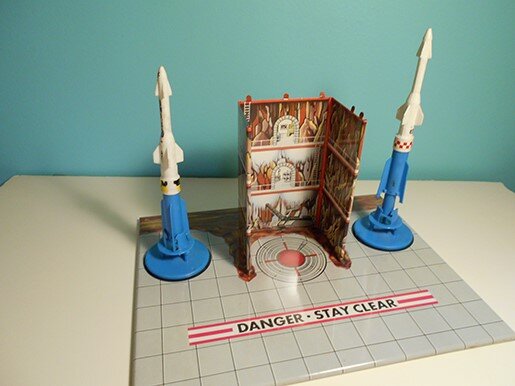 |
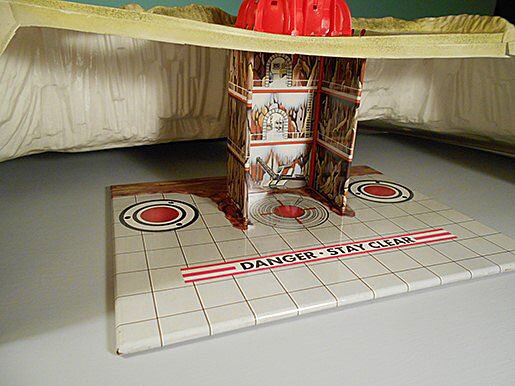 |
|
| Tin litho underground mountain structure with missiles in place Photo courtesy of collector Bob Spreitzer |
Tin litho structure attached to mountain Photo courtesy of collector Bob Spreitzer |
|
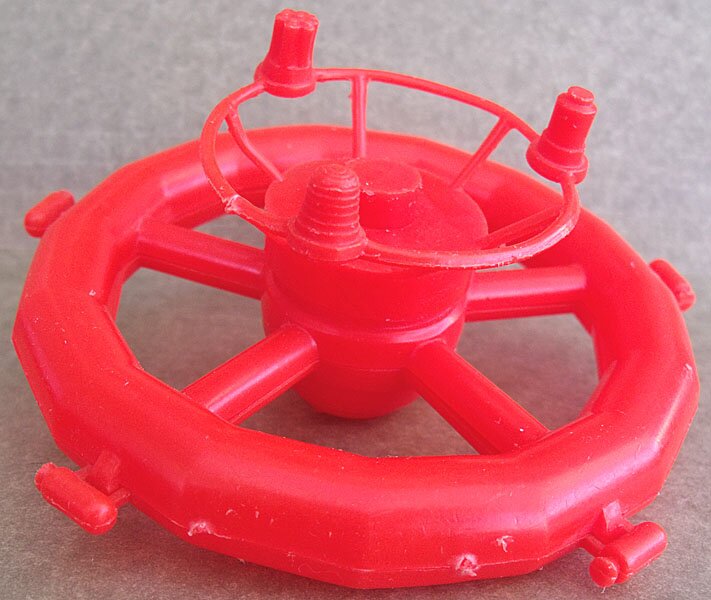 |
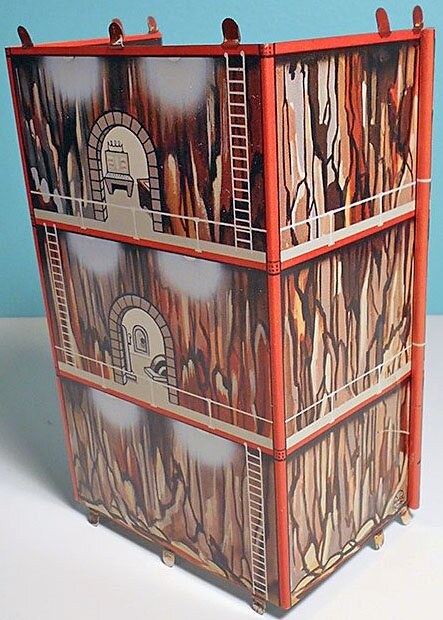 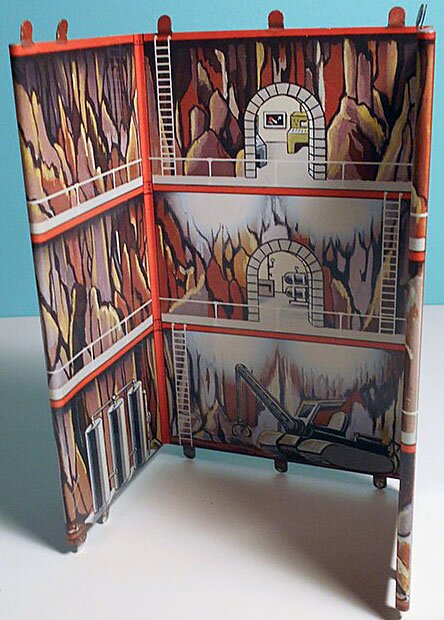 |
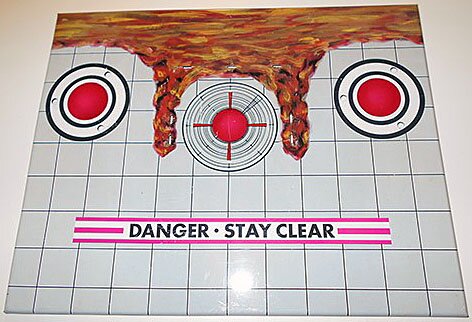 |
| Space platform | Walls of tin litho structure - inside and outside Photo courtesy of collector Bob Spreitzer, who points out that the outside rear of the structure is fully lithographed although it is not visible after the mountain piece is assembled. |
Base of tin litho structure Photo courtesy of collector Bob Spreitzer |
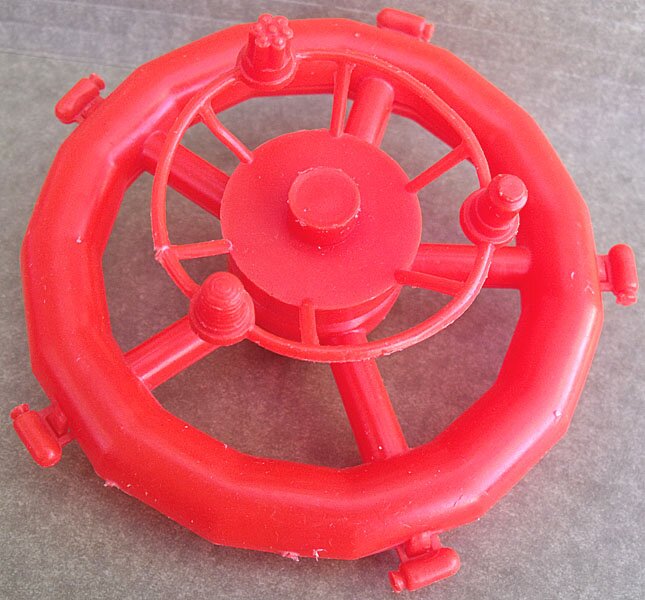 |
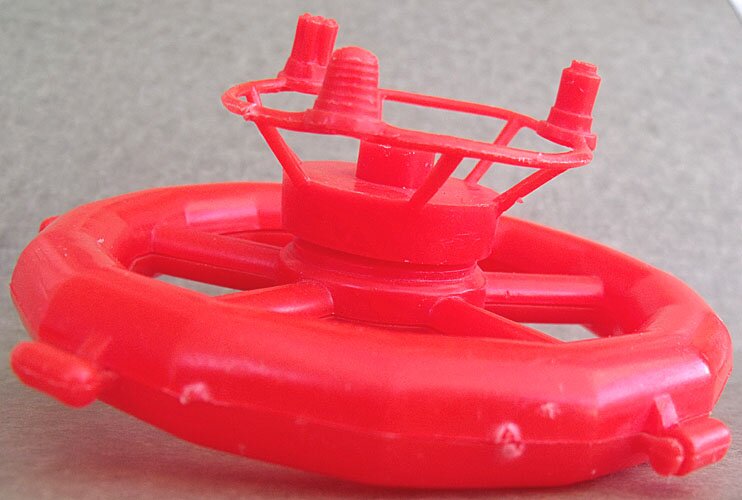 |
| Other views of space platform | |
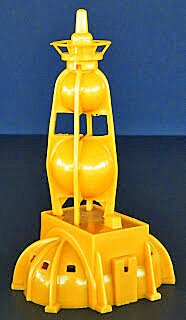 |
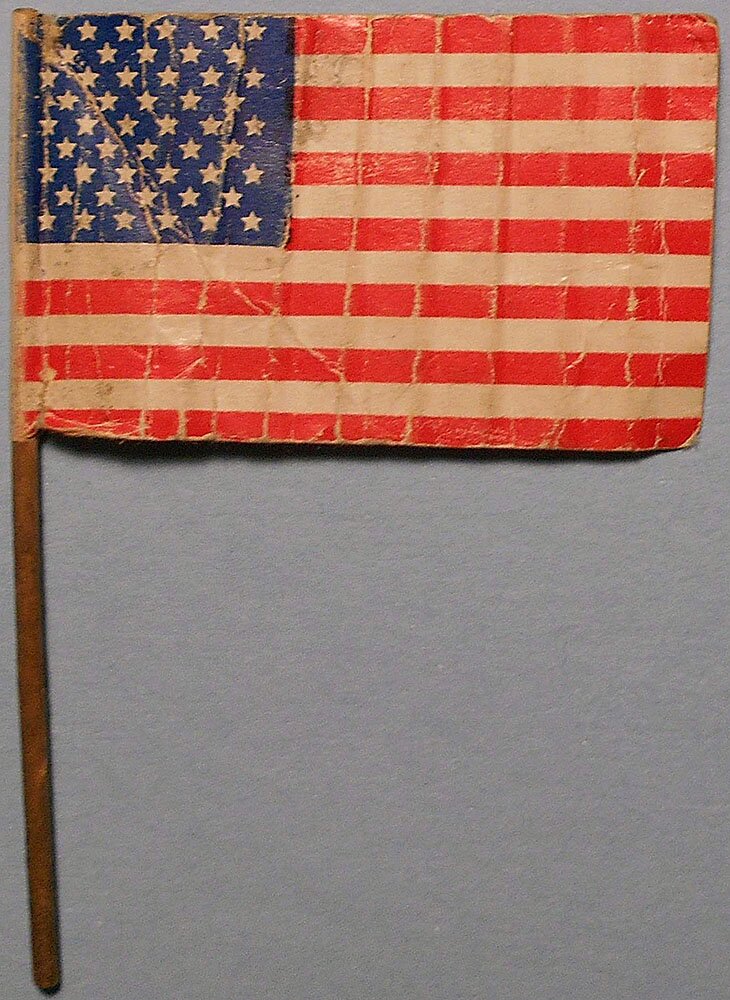 |
|
| Orbiting tower | Orbiting mechanism See photo at top of this section |
Flag Photo courtesy of collector Bob Spreitzer |
Giant Martian Landing
The Giant Martian Landing Playset was released in 1972, as Marx apparently attempted to stay one step ahead of NASA by putting humans on Mars. PFPC Issue 49 states that the exact date of release is uncertain, so it is unknown whether the set was first sold before or after the company was sold on March 10, 1972. Either way, the design was surely directed by the Marx family.
According to PFPC, the set was packaged in a huge 27-1/2 inch by 17-1/2 by 9 box in order to hold its large vacuum form Mars mountain, which was just a little smaller than the box. Though the design of the mountain was much different than the one in Moon Base sets, it was made of the same material, but with less realistic painting. The set included several rockets used in earlier sets -- though no launchers, perhaps due to new child safety laws -- as well as vehicles (blue with black wheels), an orbiting Operation Moon Base-style space platform and Moon Base field accessories (in silver). Like Moon Base sets, the Giant Martian Landing also included some of the field accessories from Tom Corbett sets (yellow), but unlike Moon Bases sets, it had no tin litho structure.
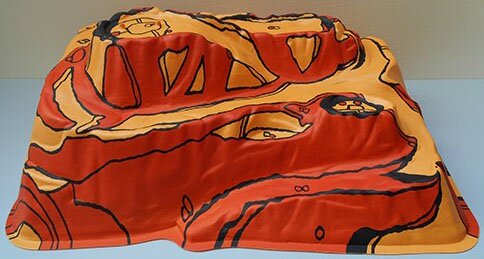 |
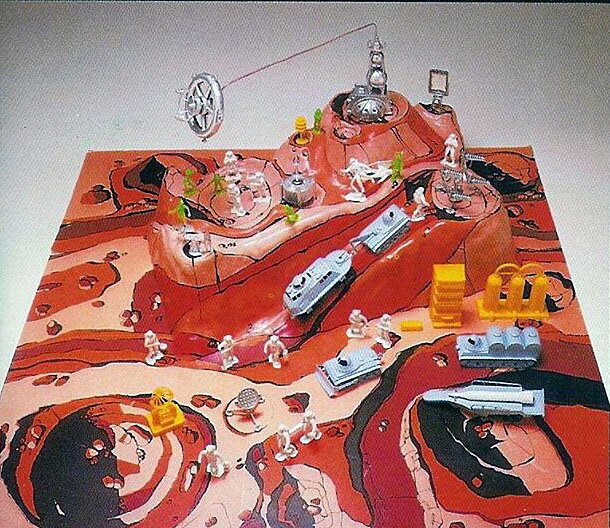 |
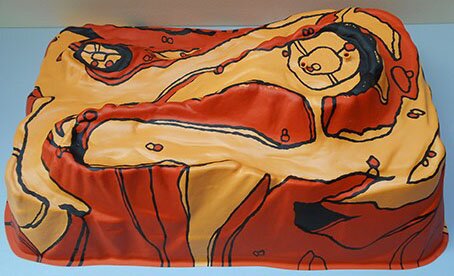 |
|
| Mountain from Giant Martian Landing Playset Photos courtesy of collector Bob Spreitzer |
Photo from advertisement for Giant Martian Landing Photo courtesy of Kent Sprecher |

| Playmats |
Many Marx playsets -- including space sets -- included thin plastic playmats. I own few of them and would welcome photos of any that you do have. The two shown below were graciously provided by fellow collectors. The Moon Base mat is about 31 by 41 inches, according to collector Charles Tarrant. If you can share any photos, please be sure to specify which set they came in.
 |
|
| Cape Canaveral | Operation Moon Base Photo courtesy of collector Charles Tarrant |
Playset Magazine Issue 37 states that the 1961 Sears Deluxe Cape Canaveral (#4536) included "a rare and very exclusive playmat...."
| Playmat from Sears Deluxe Cape Canaveral Playset |
As seen in a photo just above, a large playmat about three-feet square also came in the Giant Martin Landing playset, with colors matching the mountain piece.
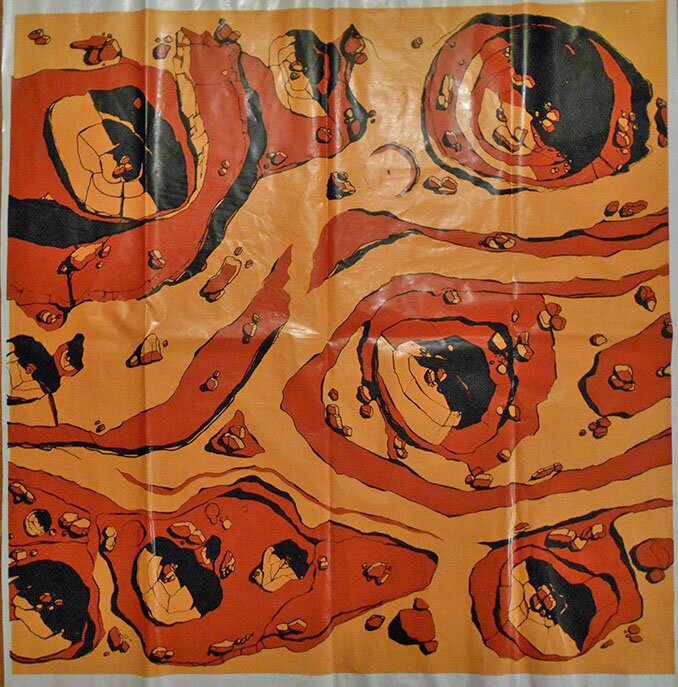 |
| Playmat from Giant Martian Landing Playset Photo courtesy of collector Bob Spreitzer |
The Galaxy Command set had a 18-inch by 24-inch playmat showing an attractive landscape of moon craters in three shades of blue.
 |
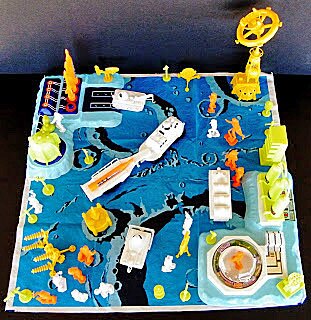 |
| Playmat | Mat with assembled playset |
| Both photos above courtesy of Fritz and Bettina Berg of Toys and Stuff | |

Back to Main Table of Contents